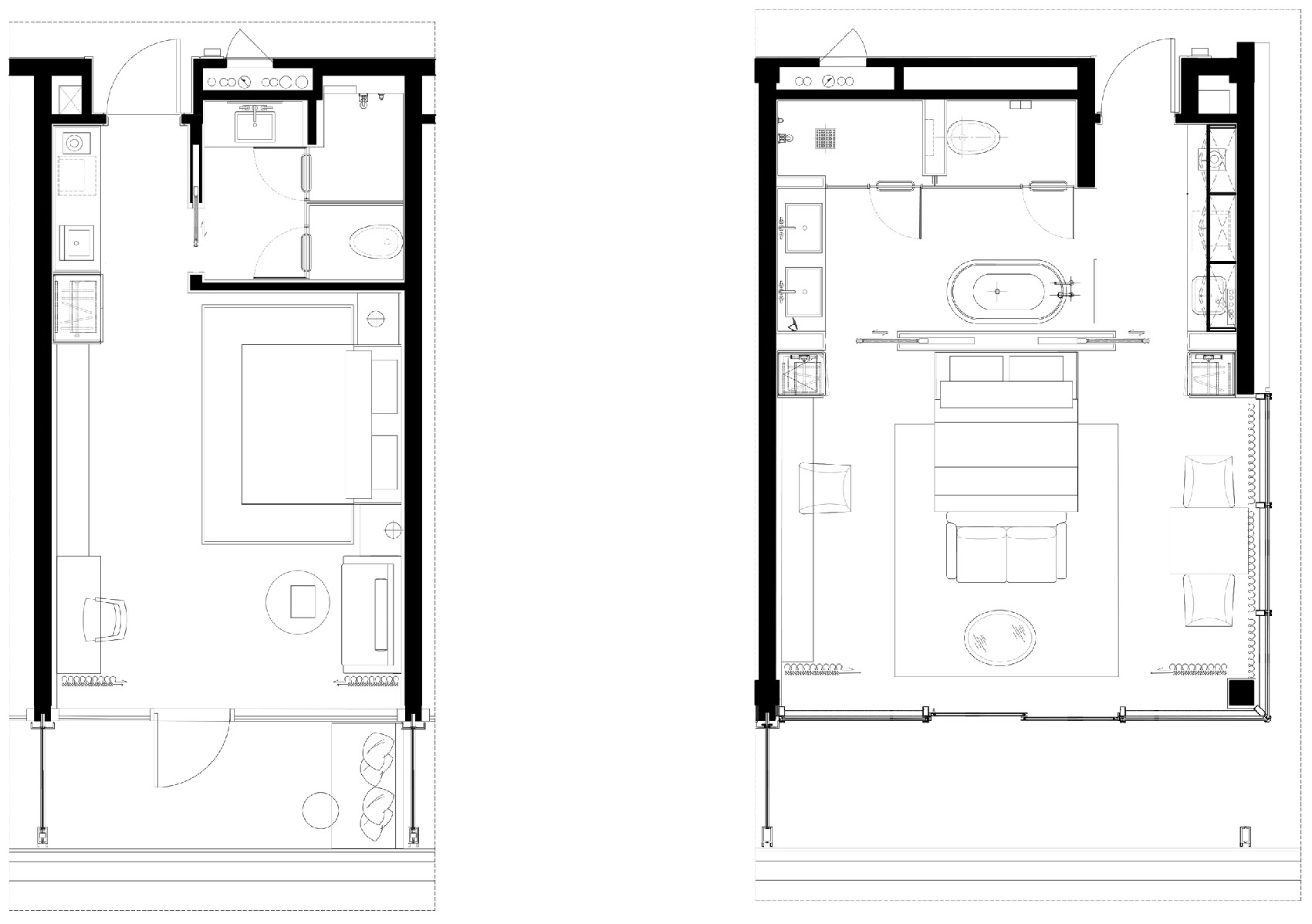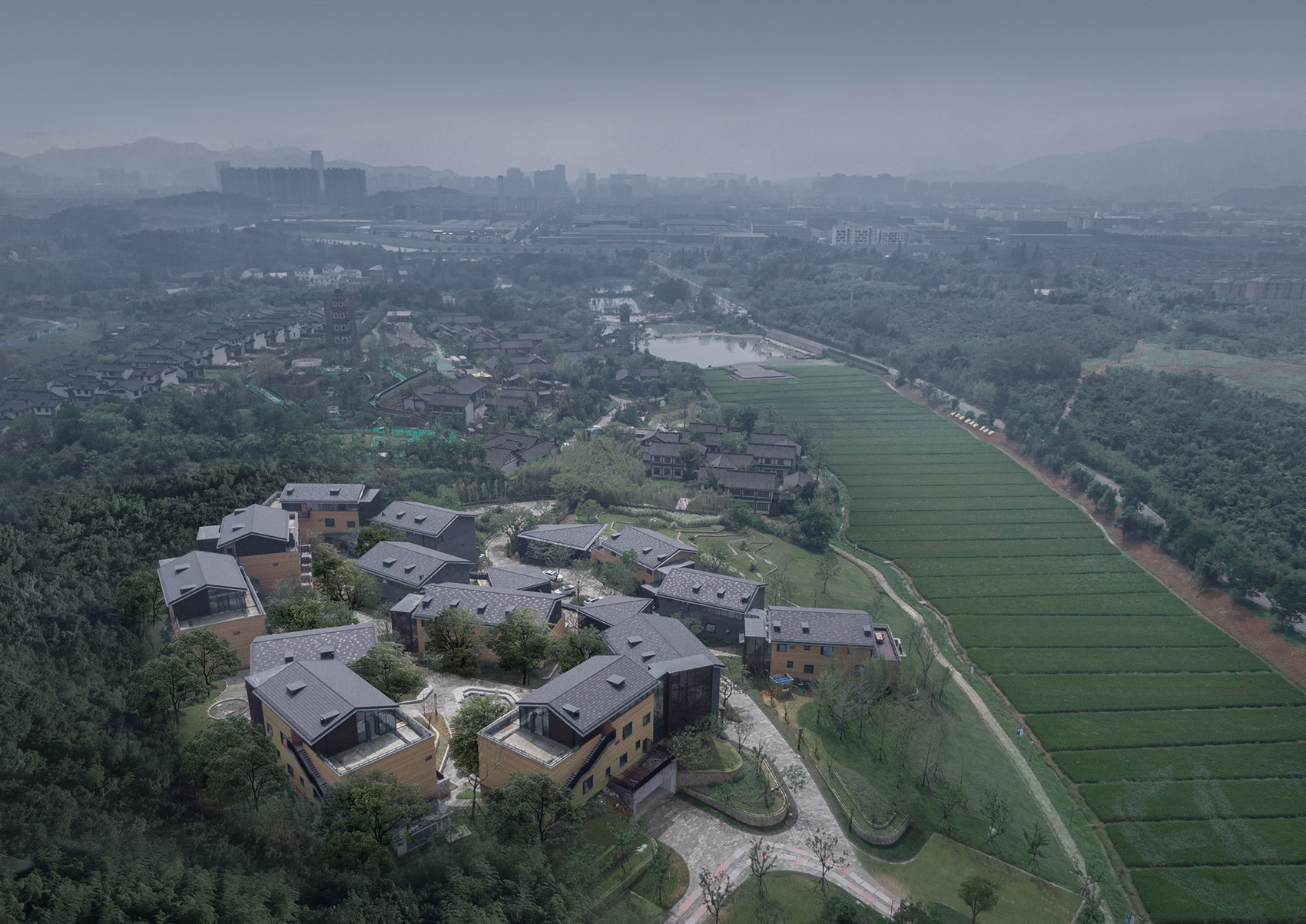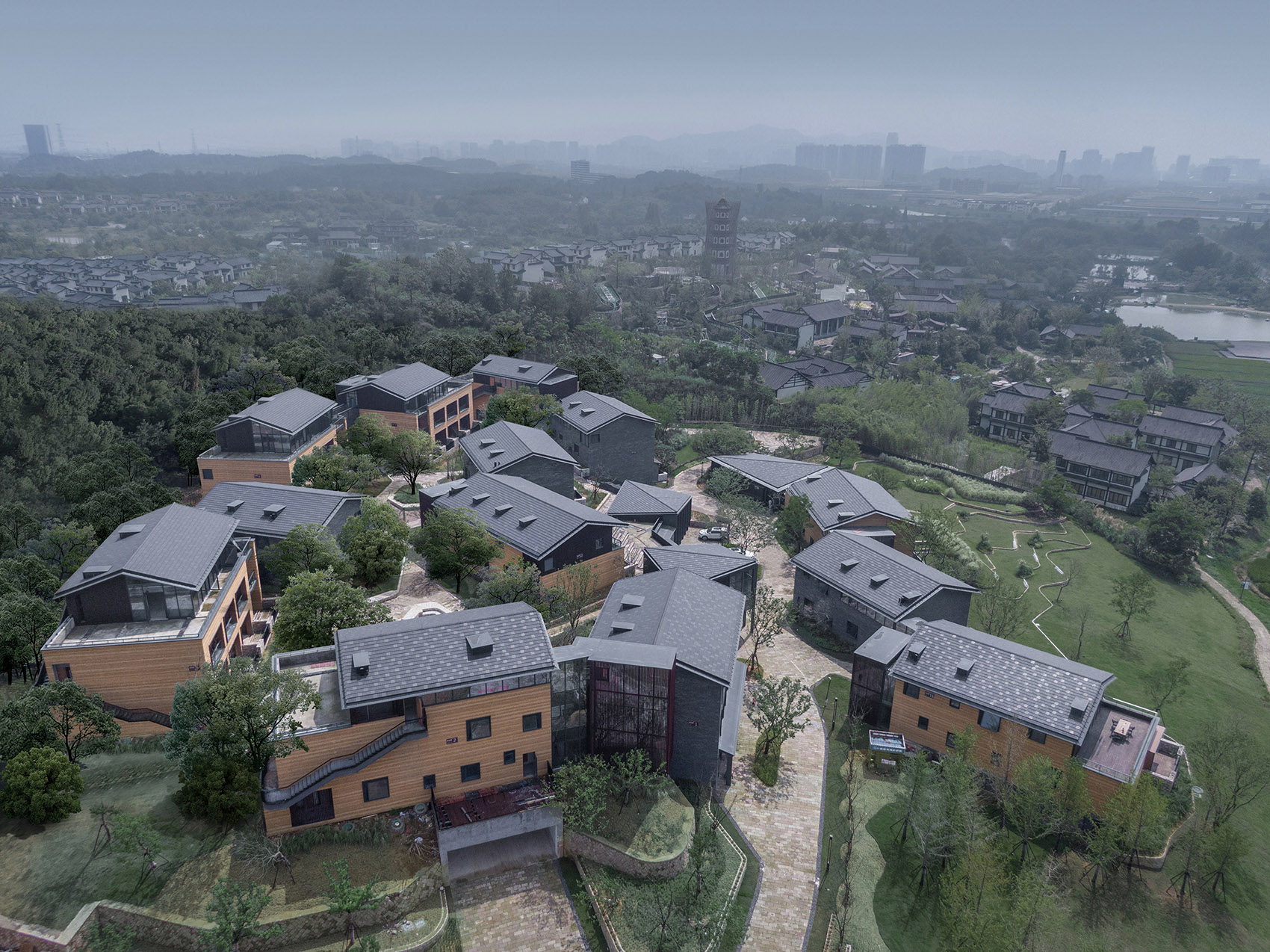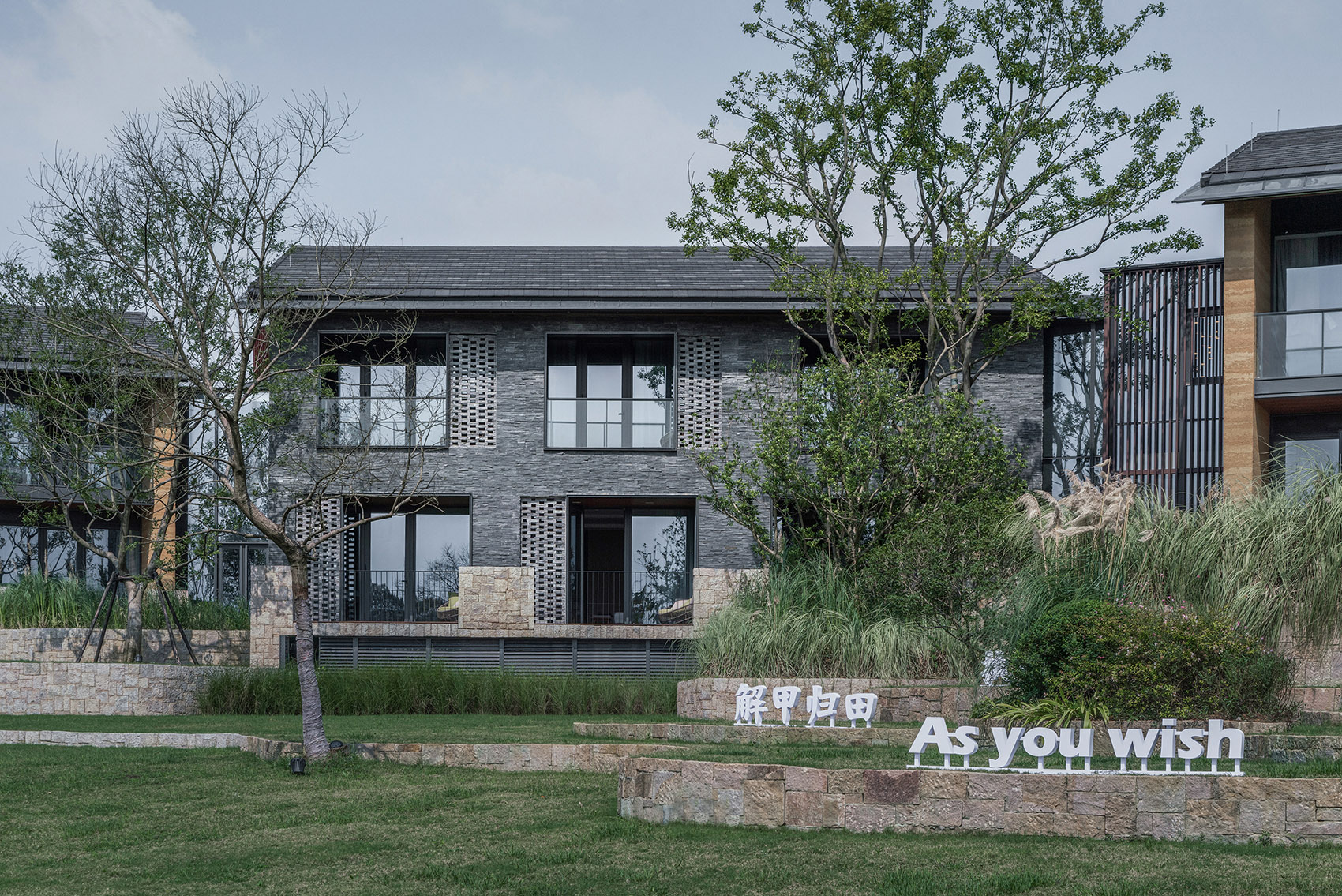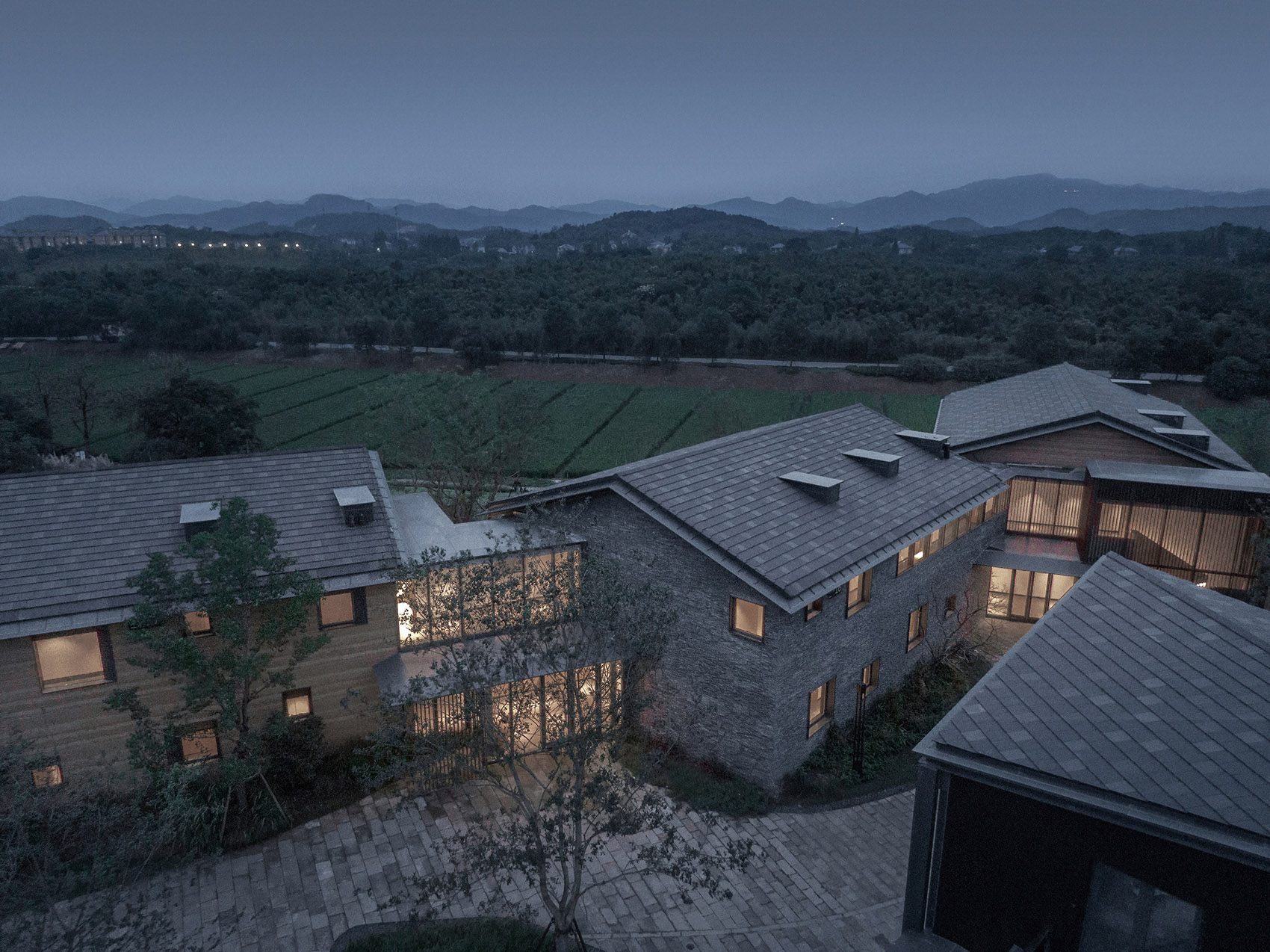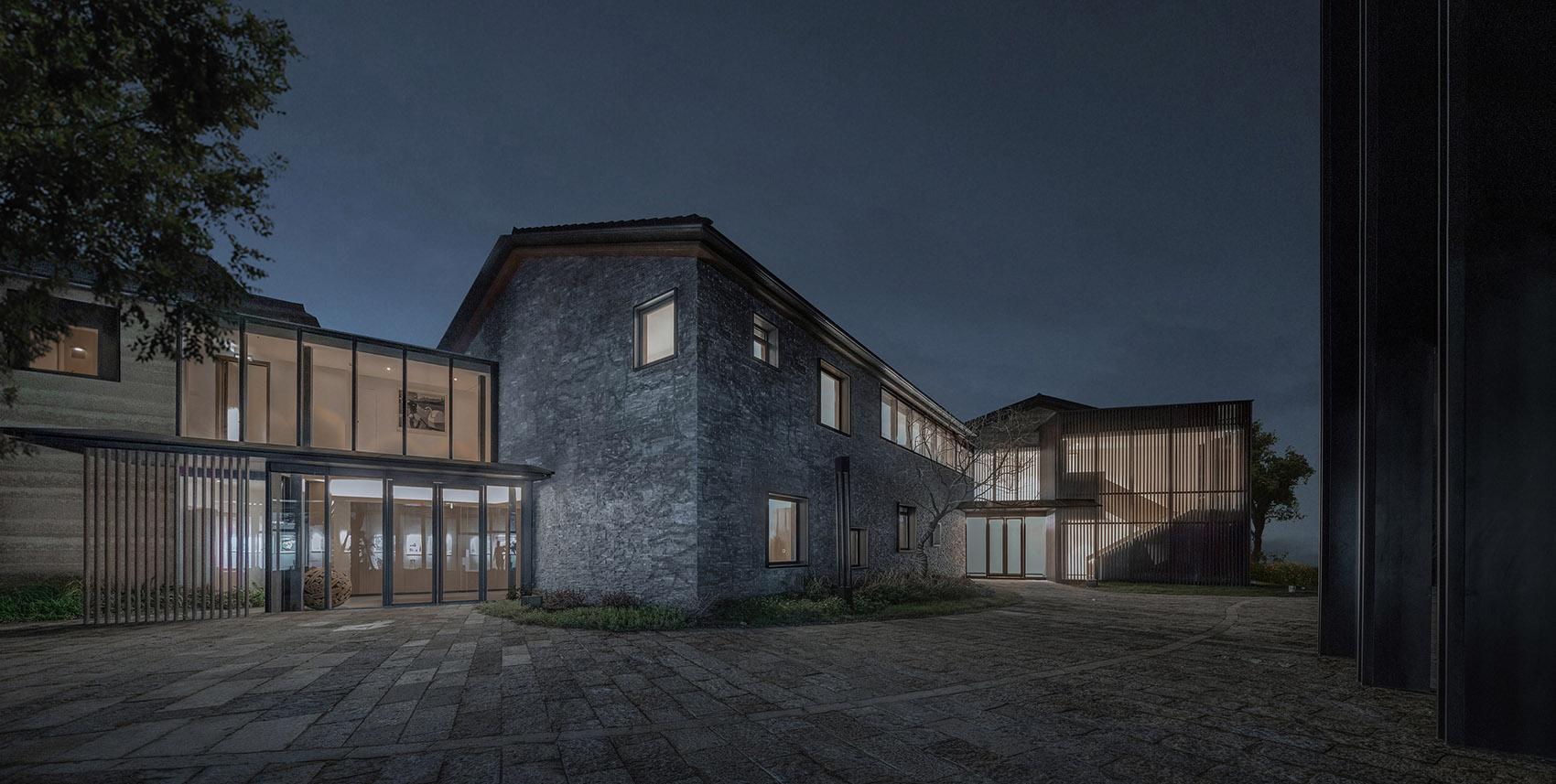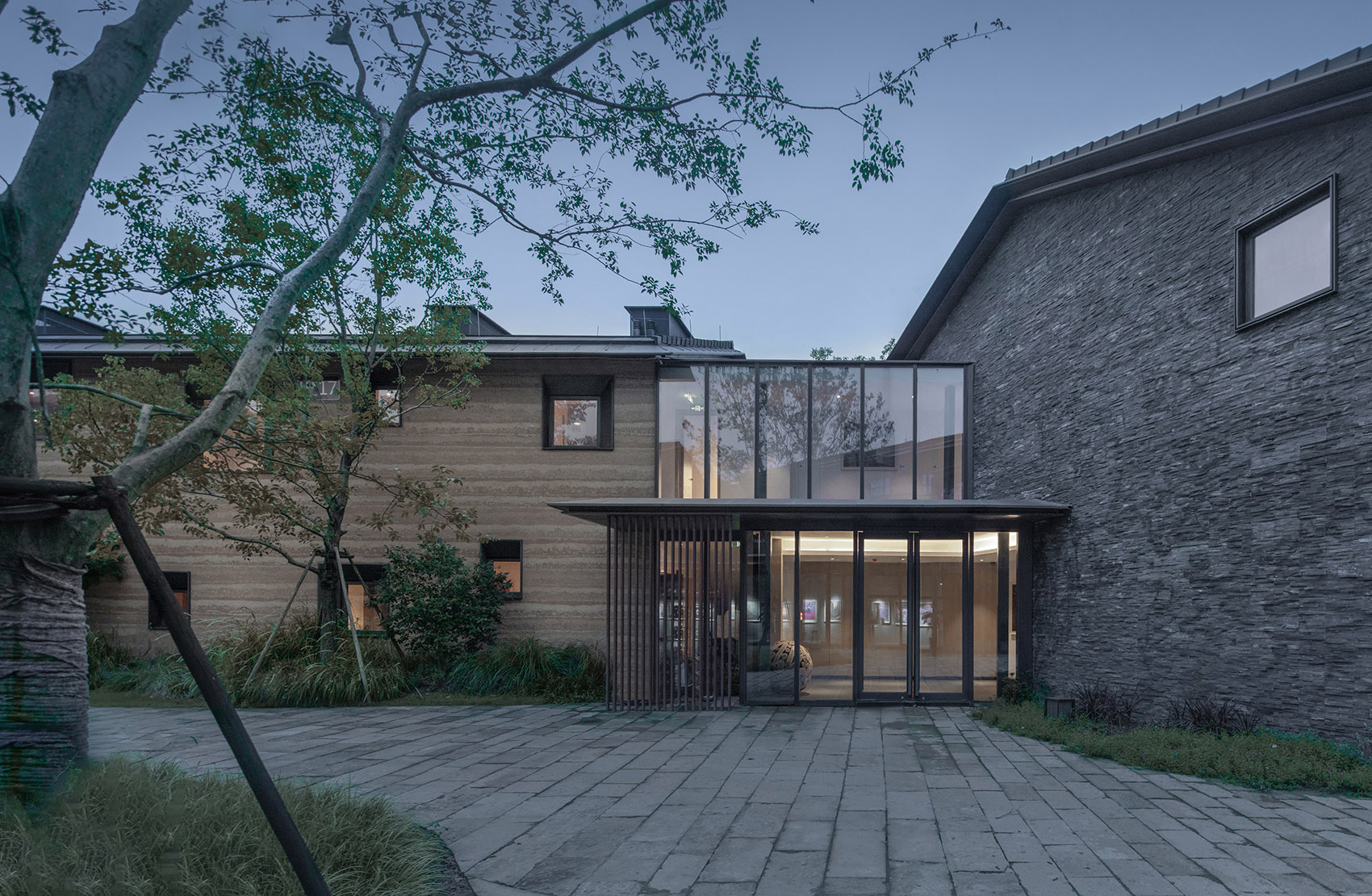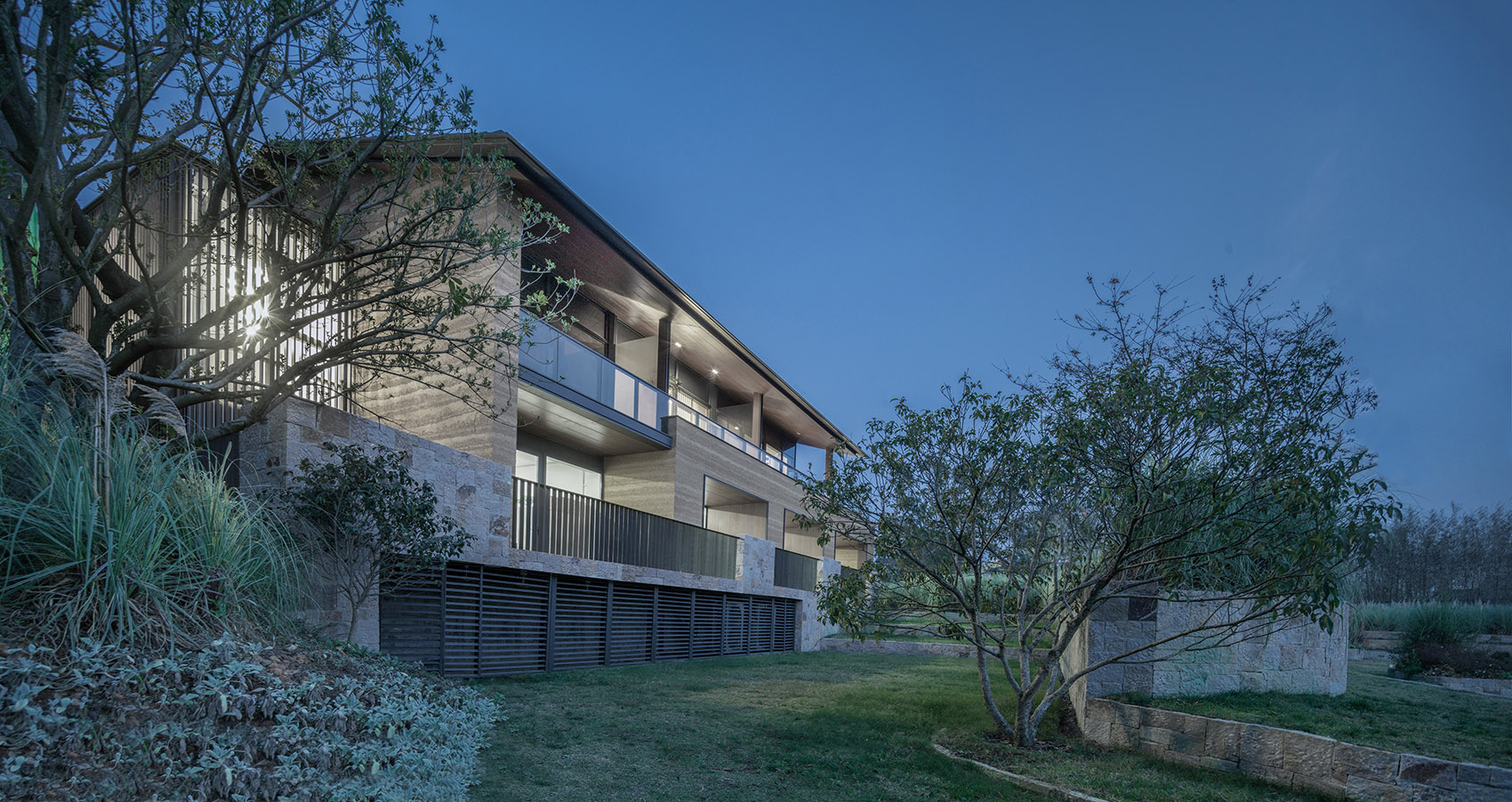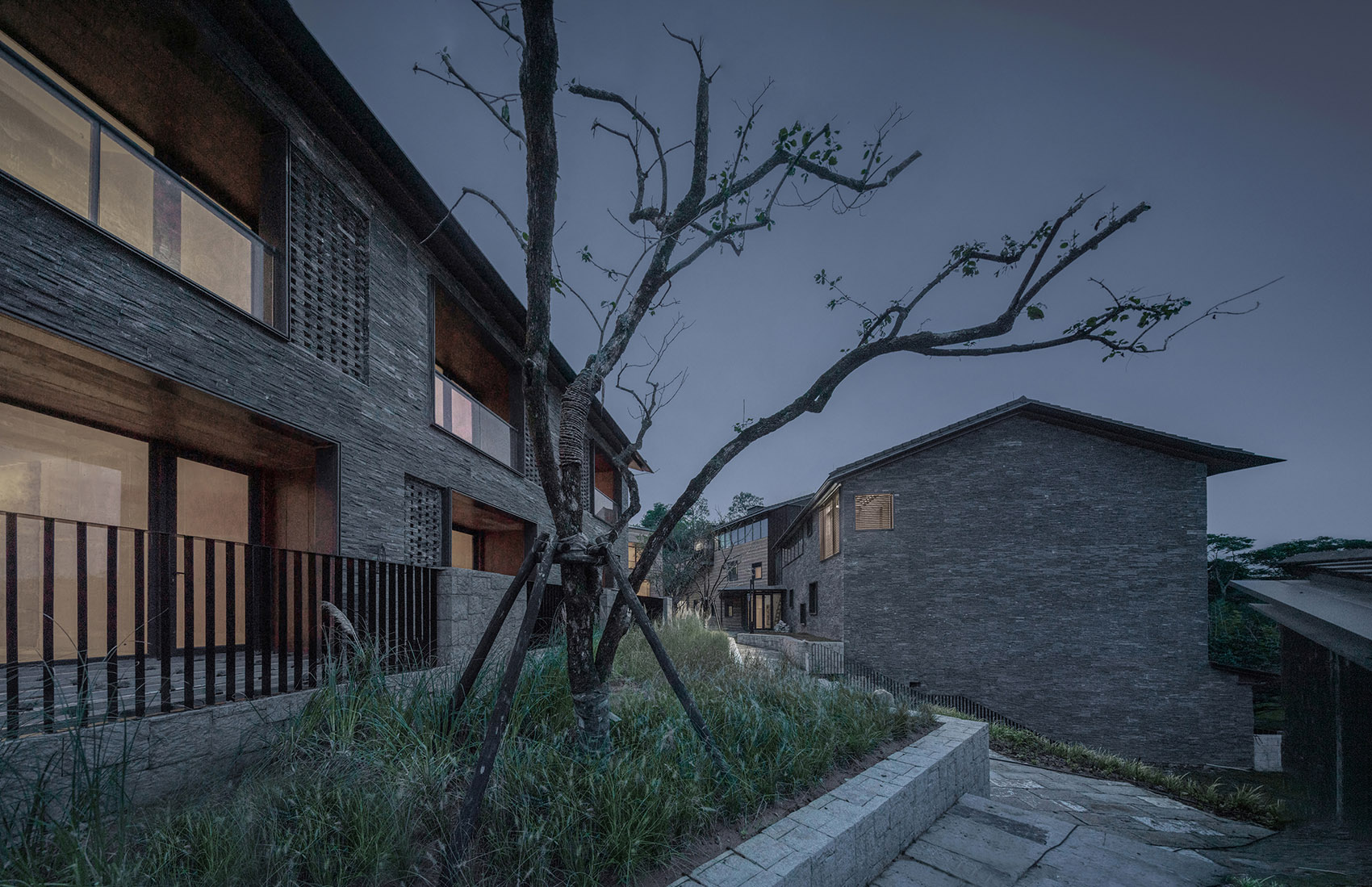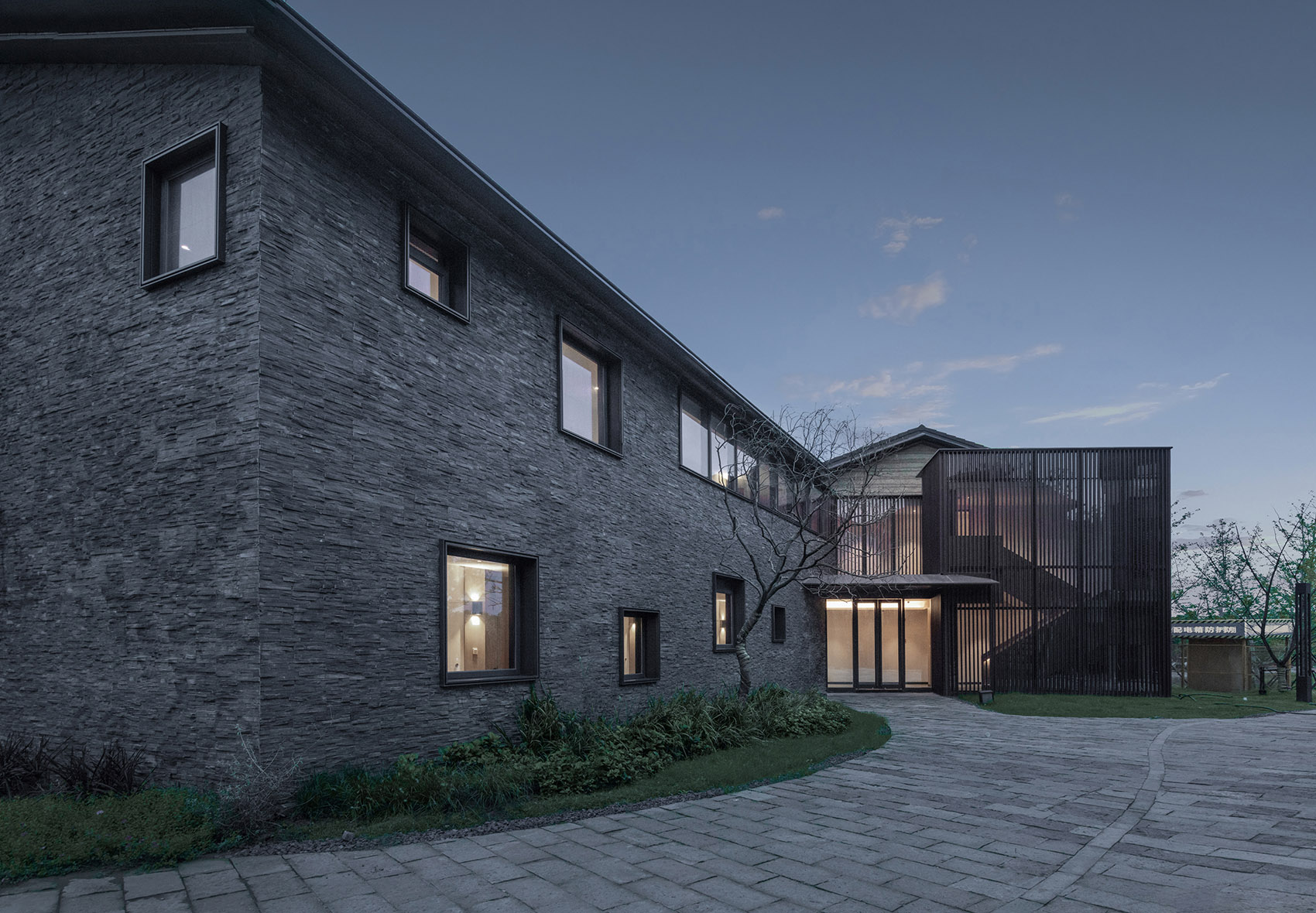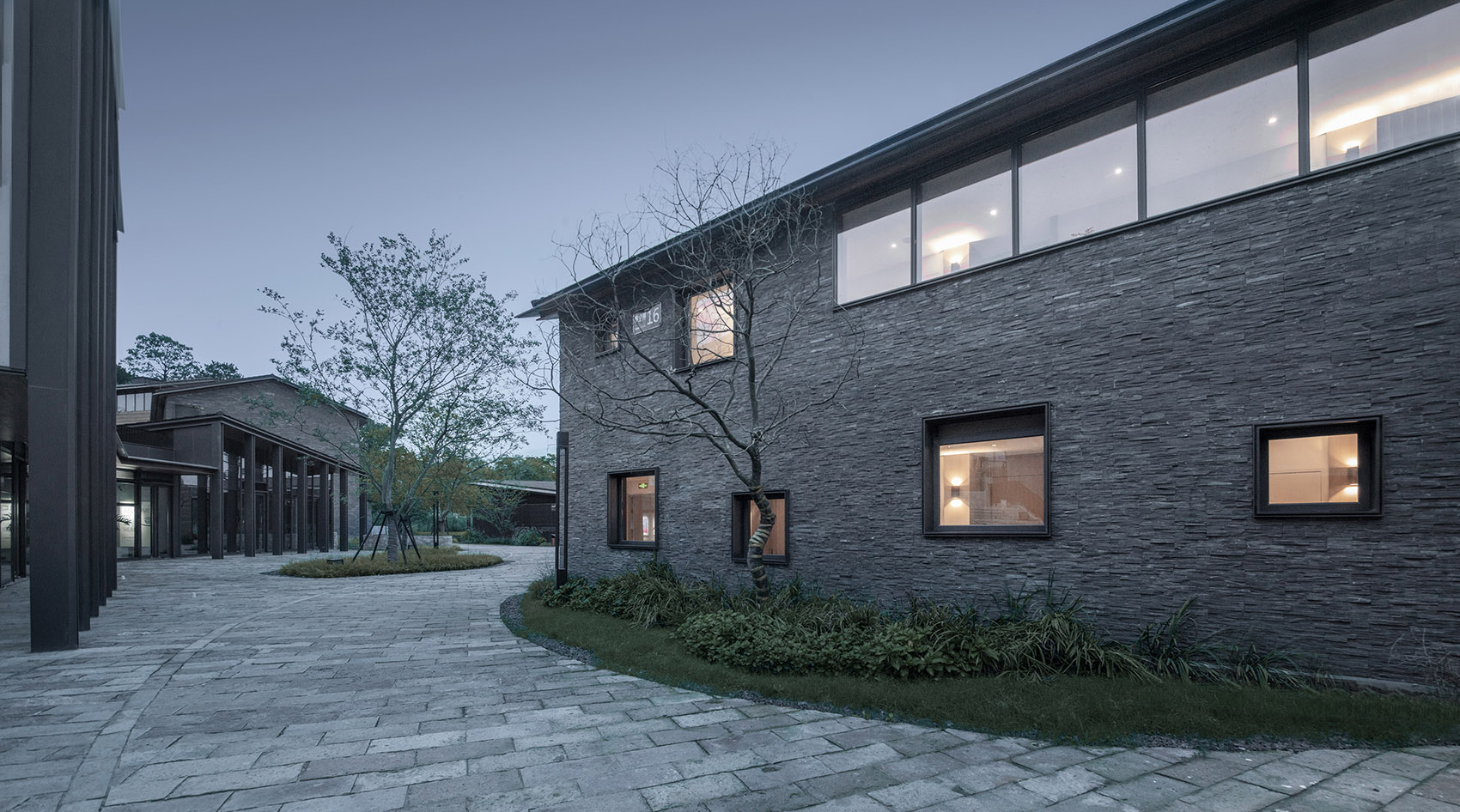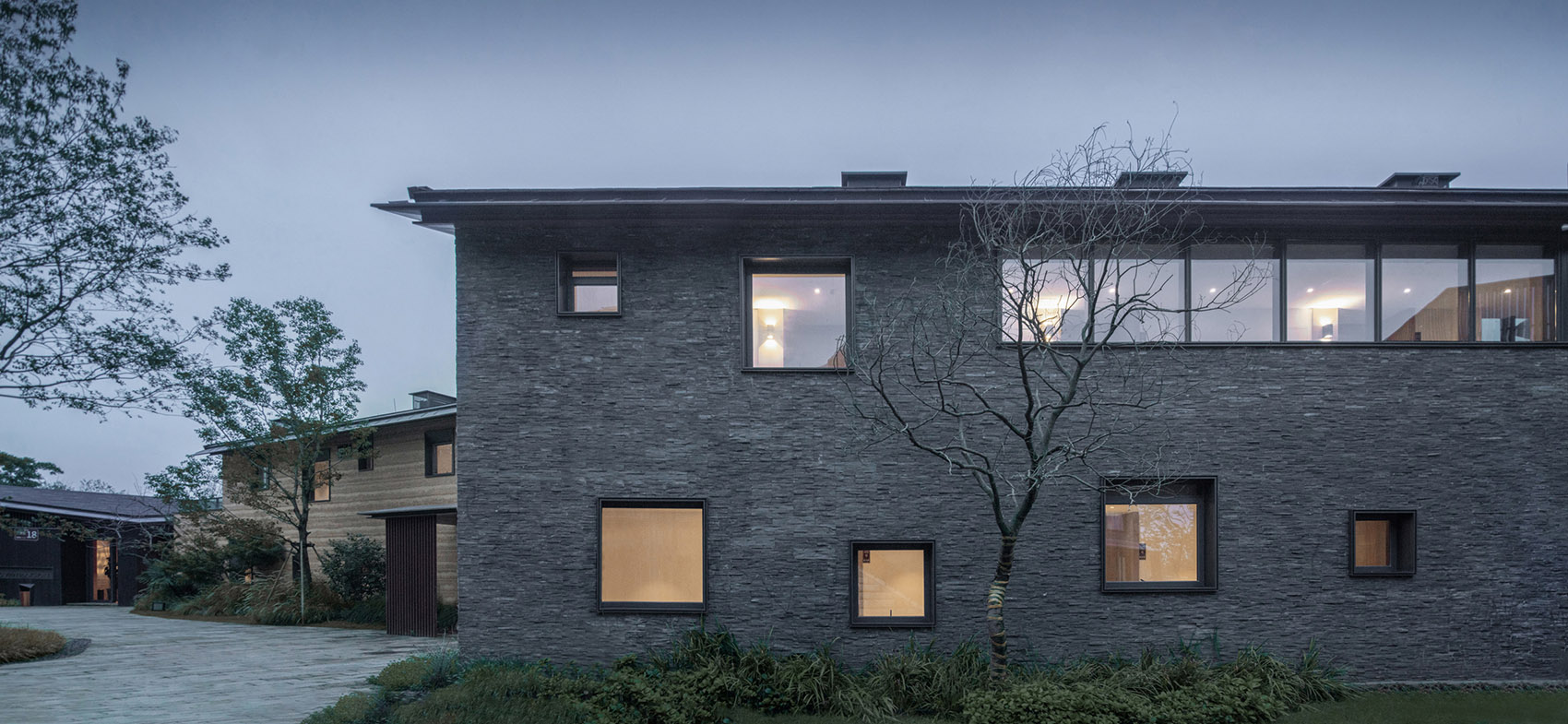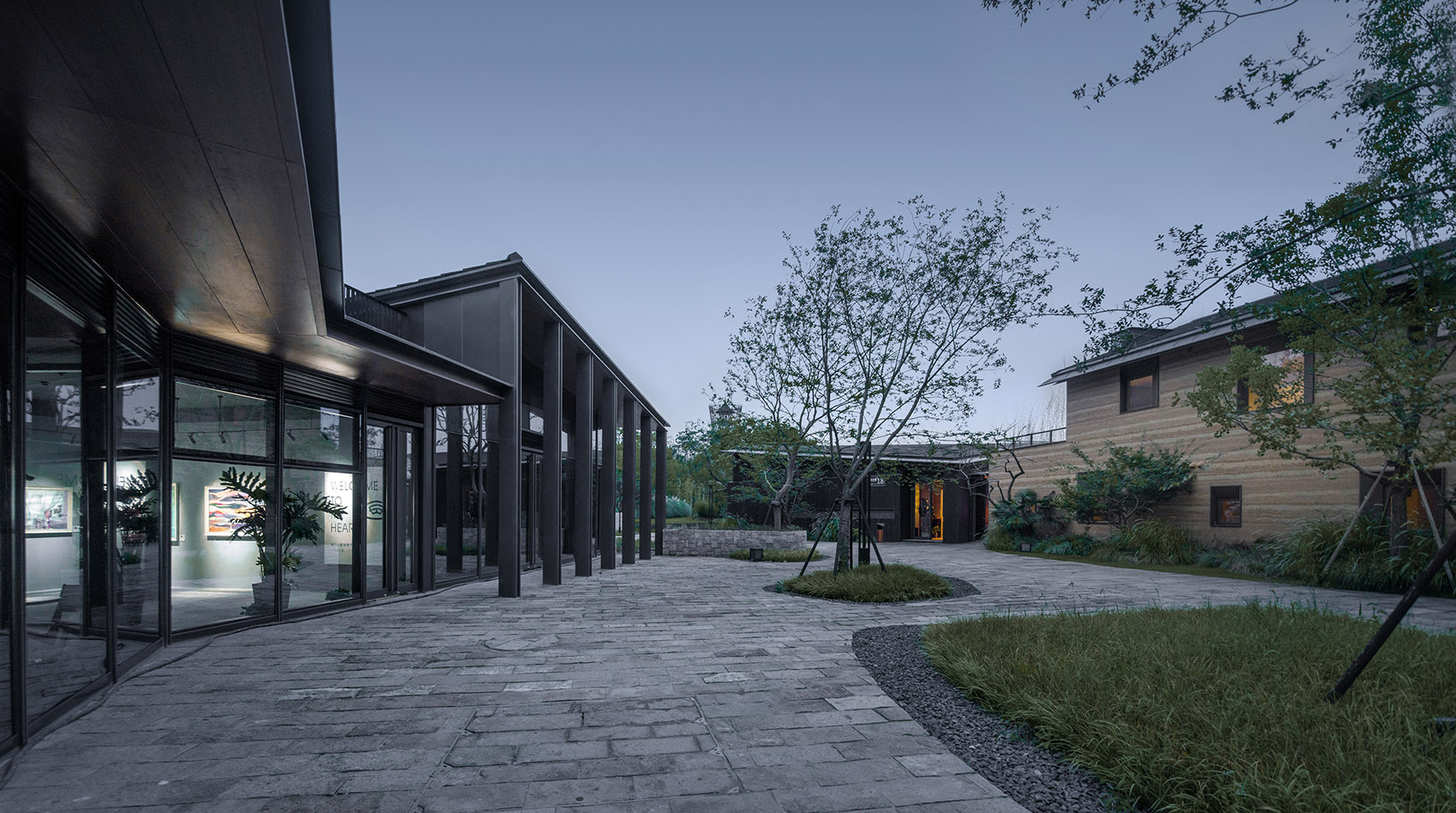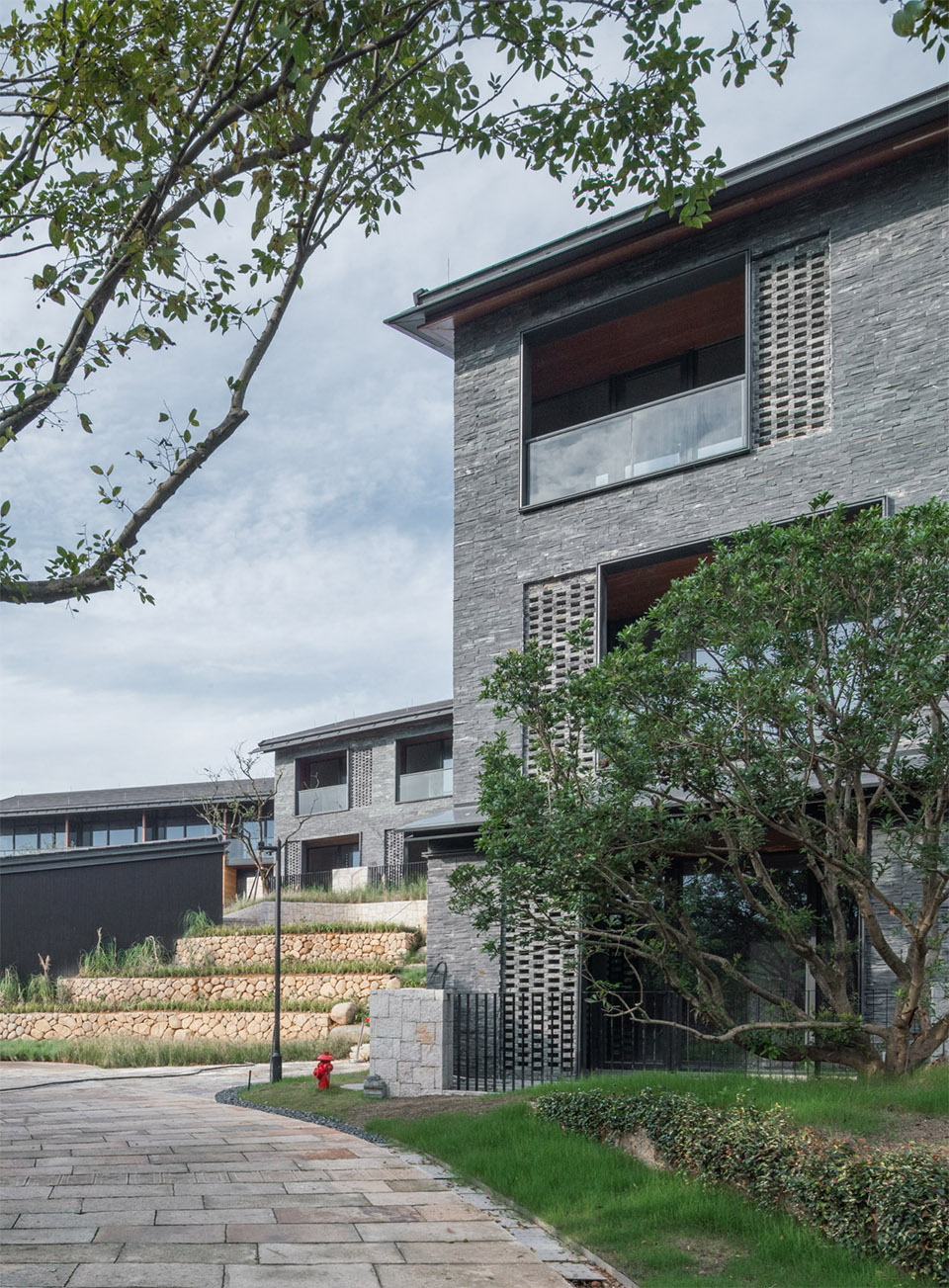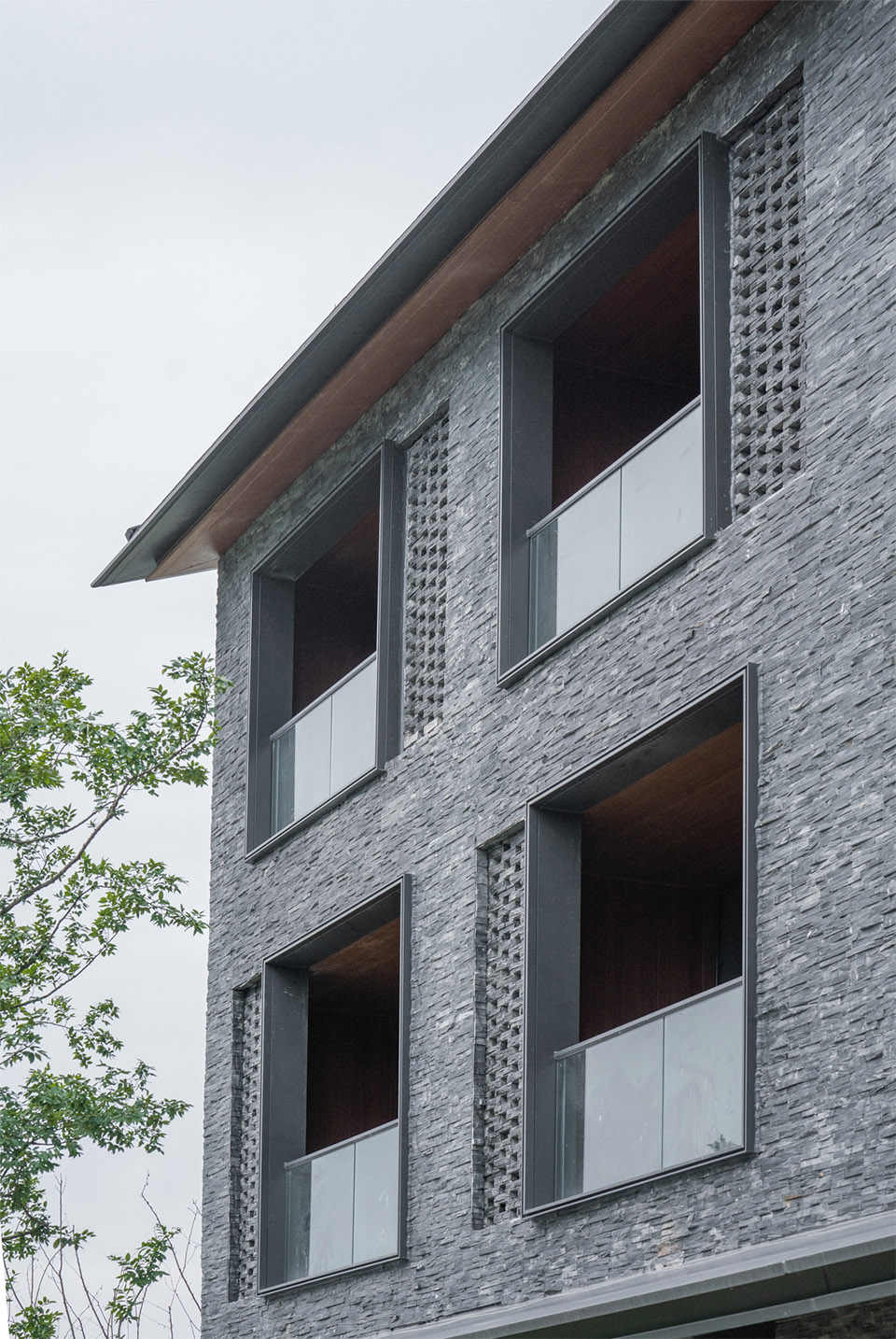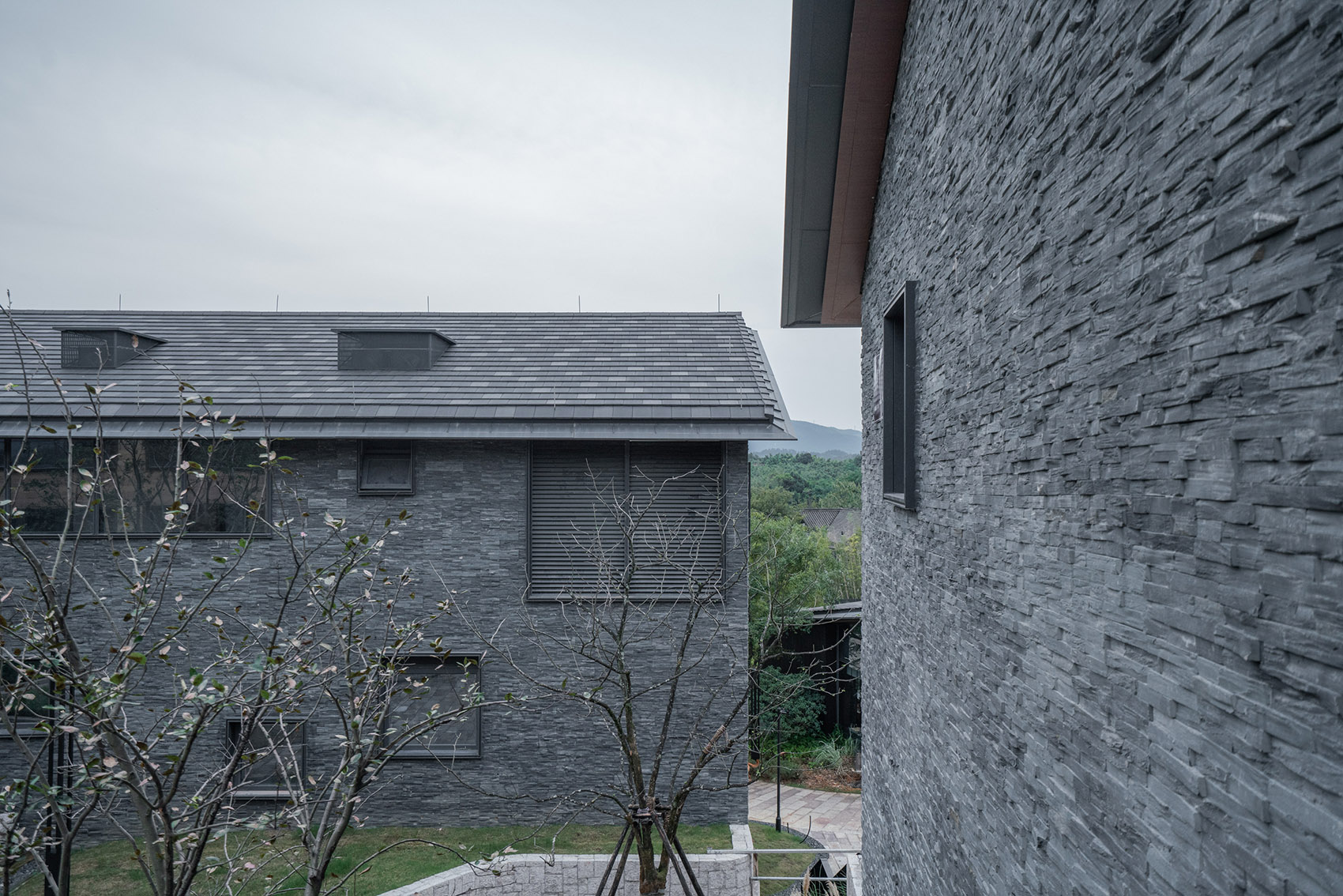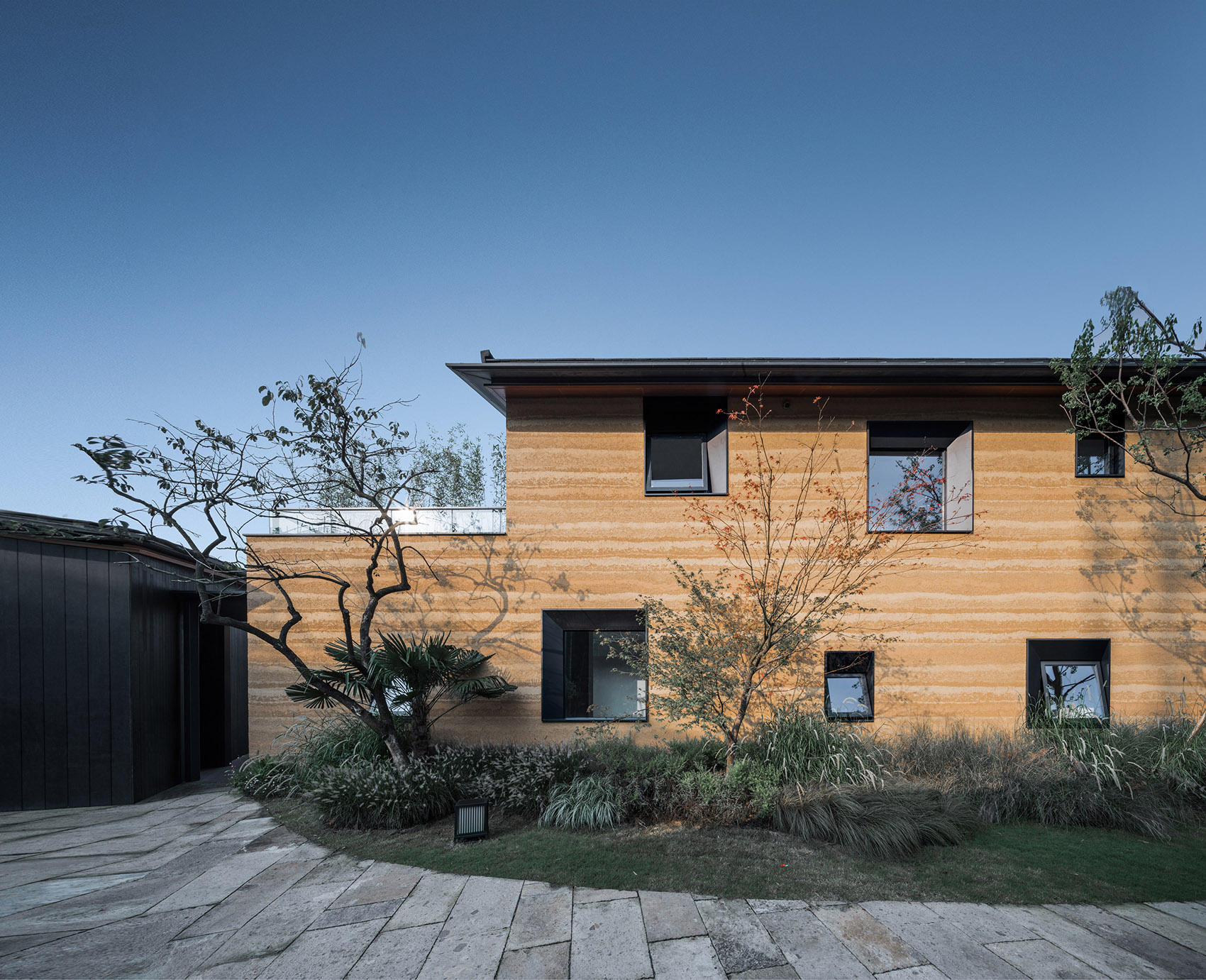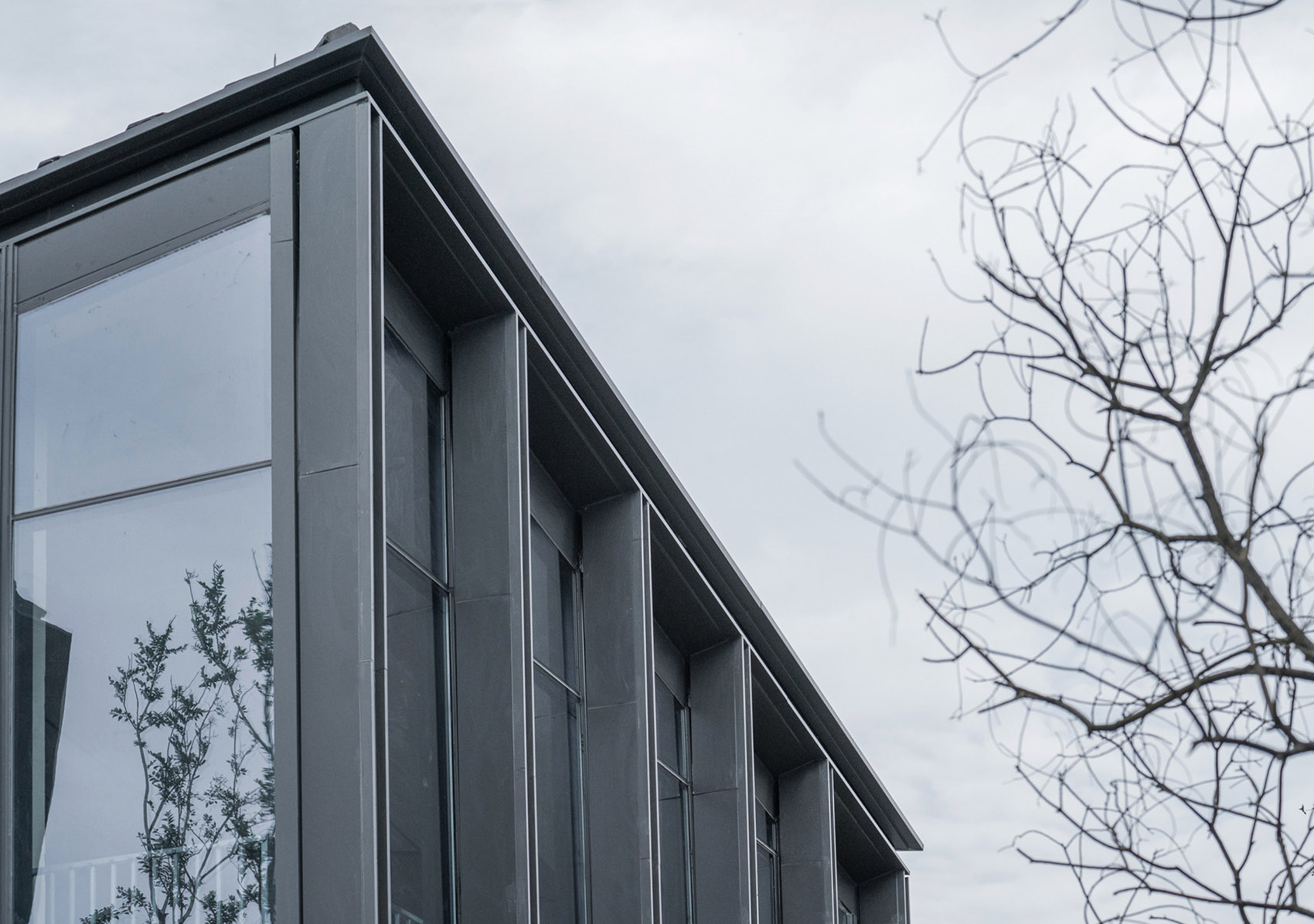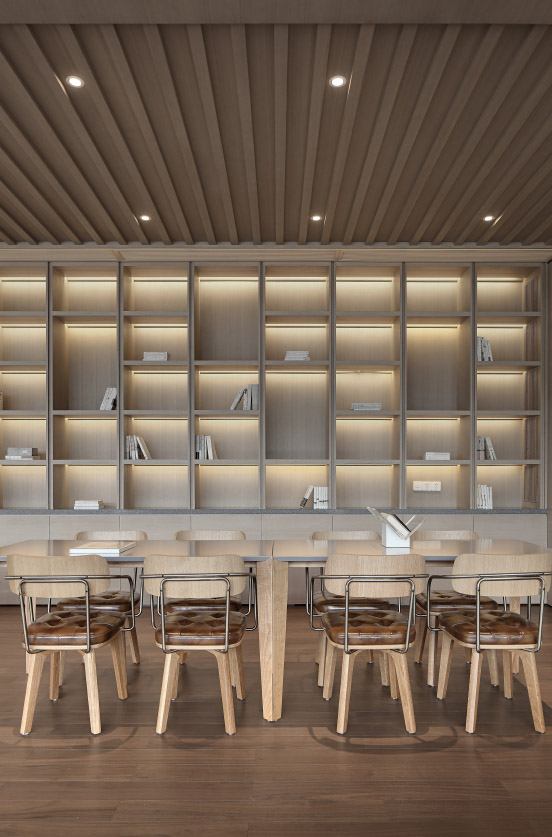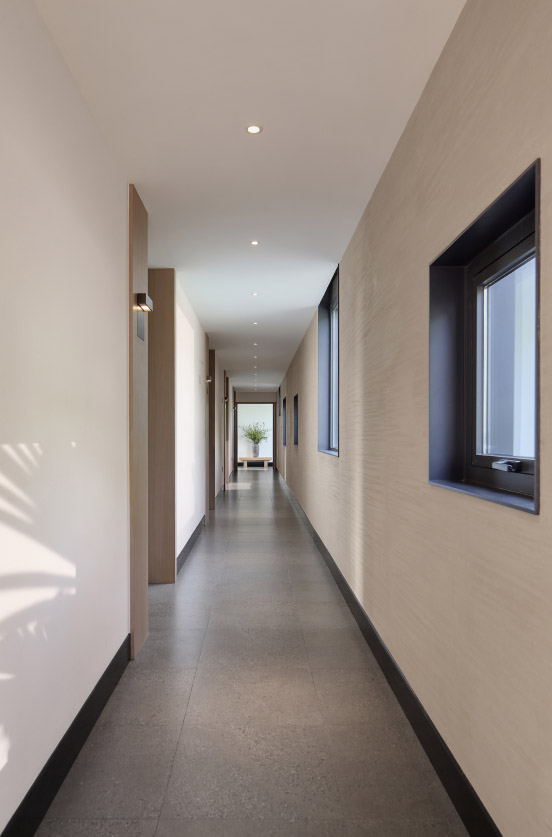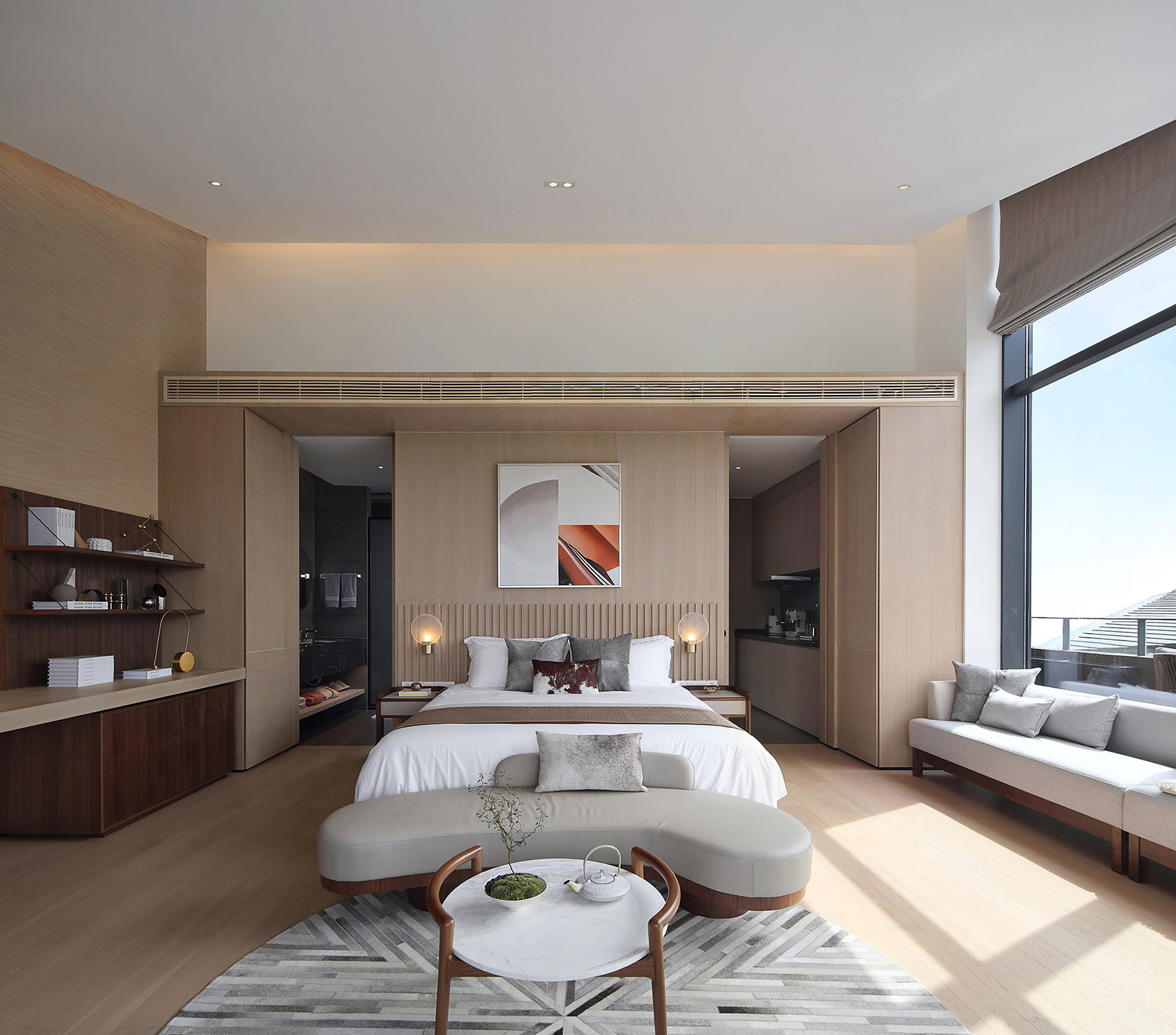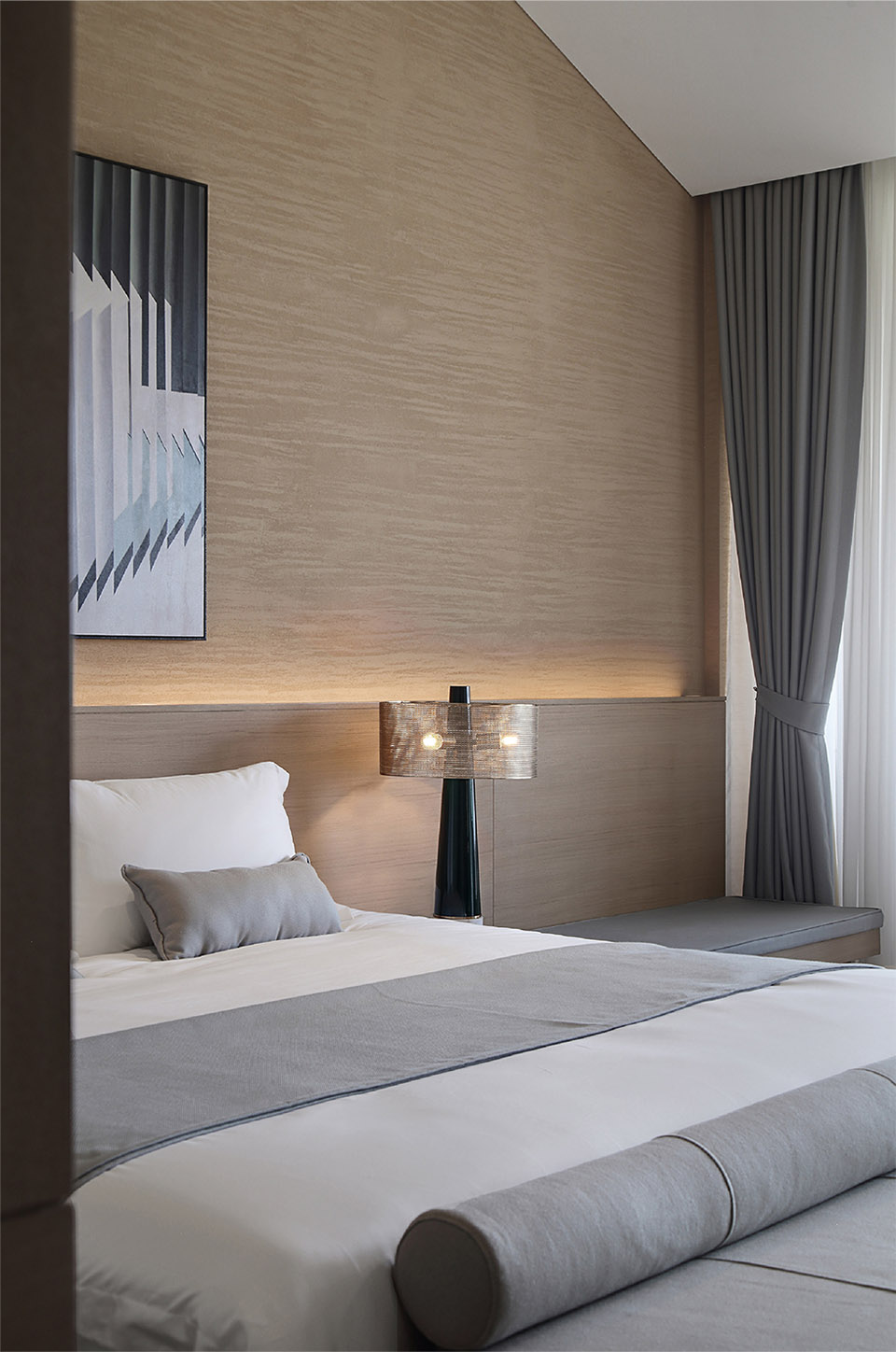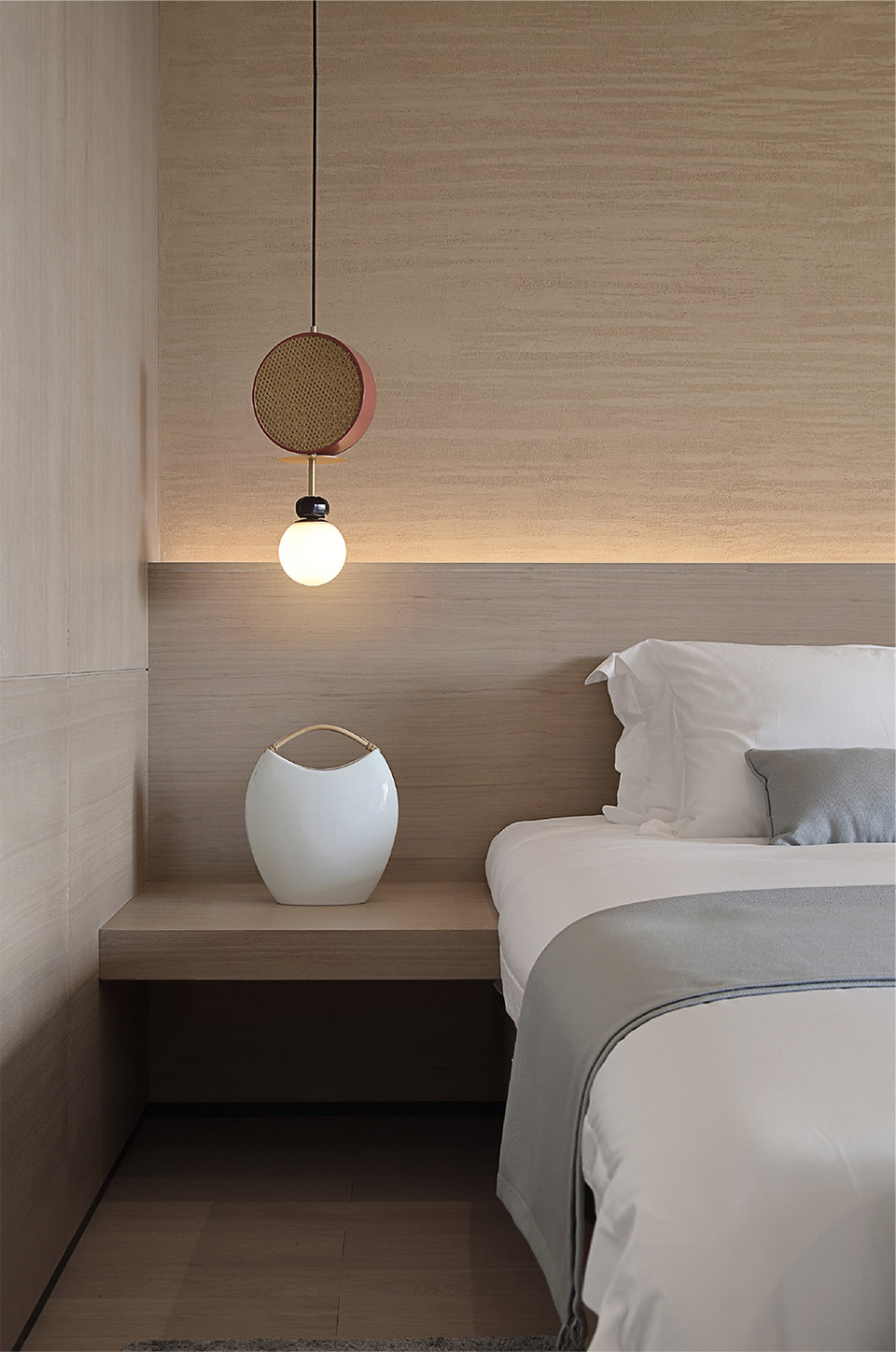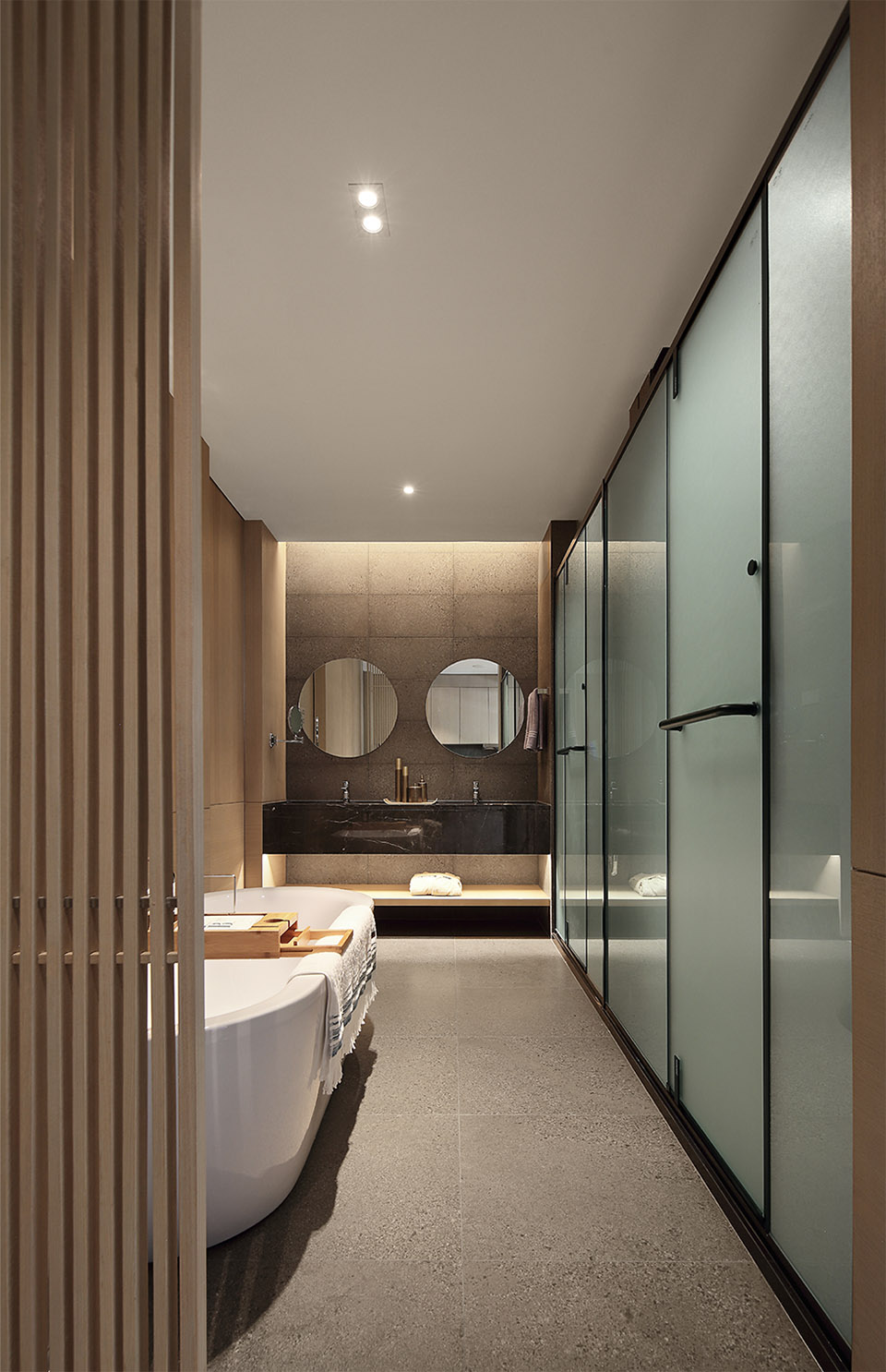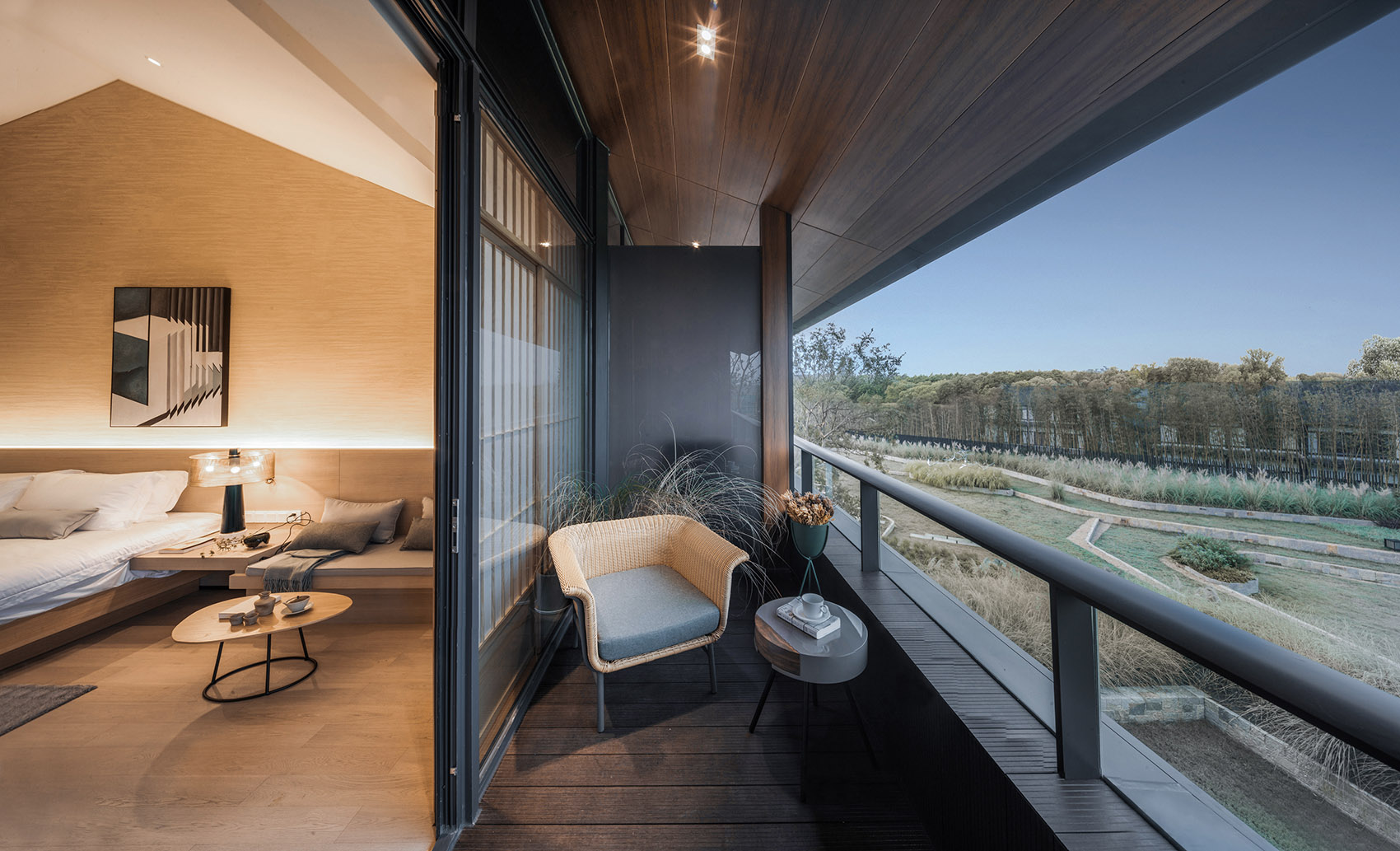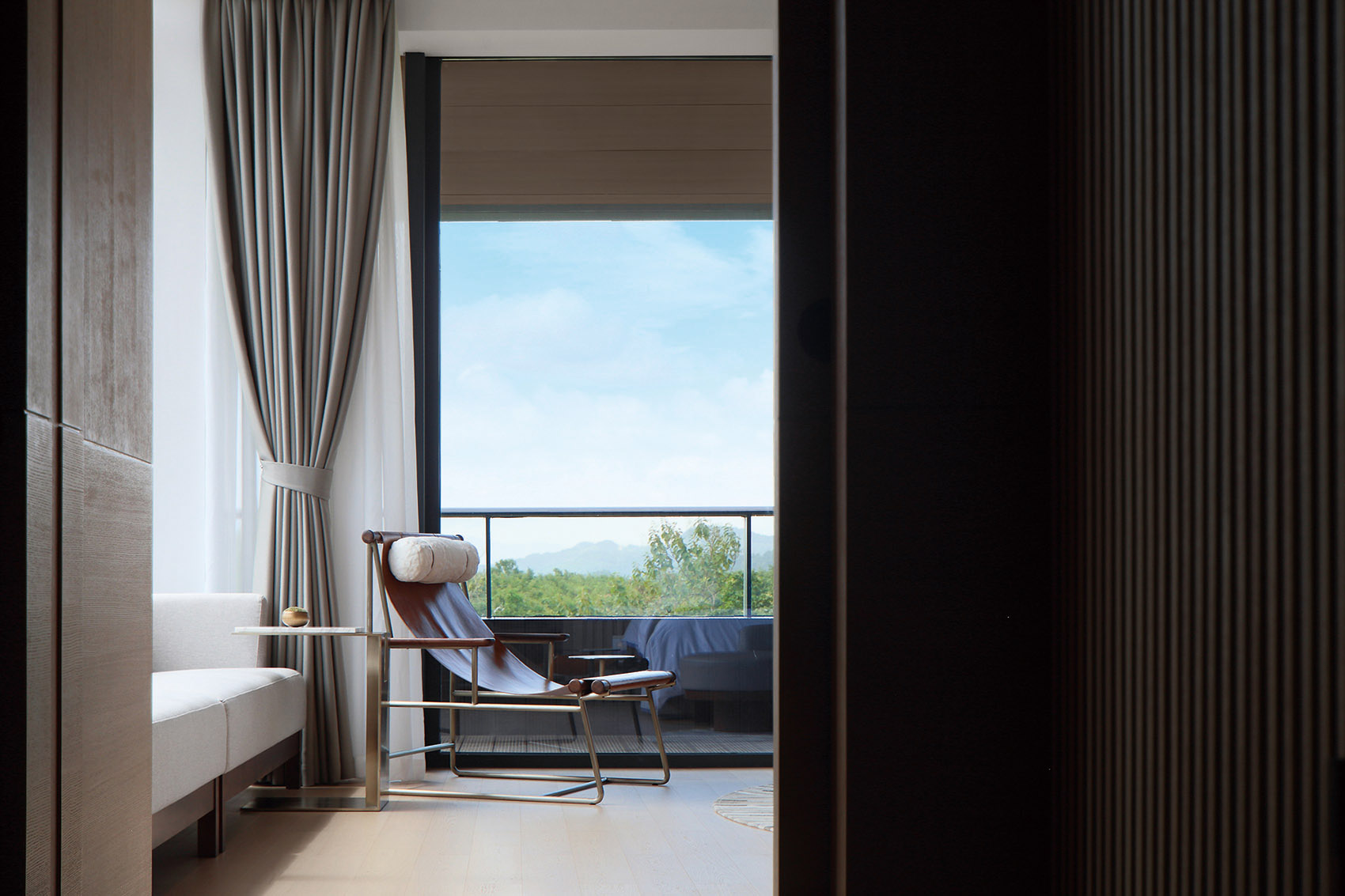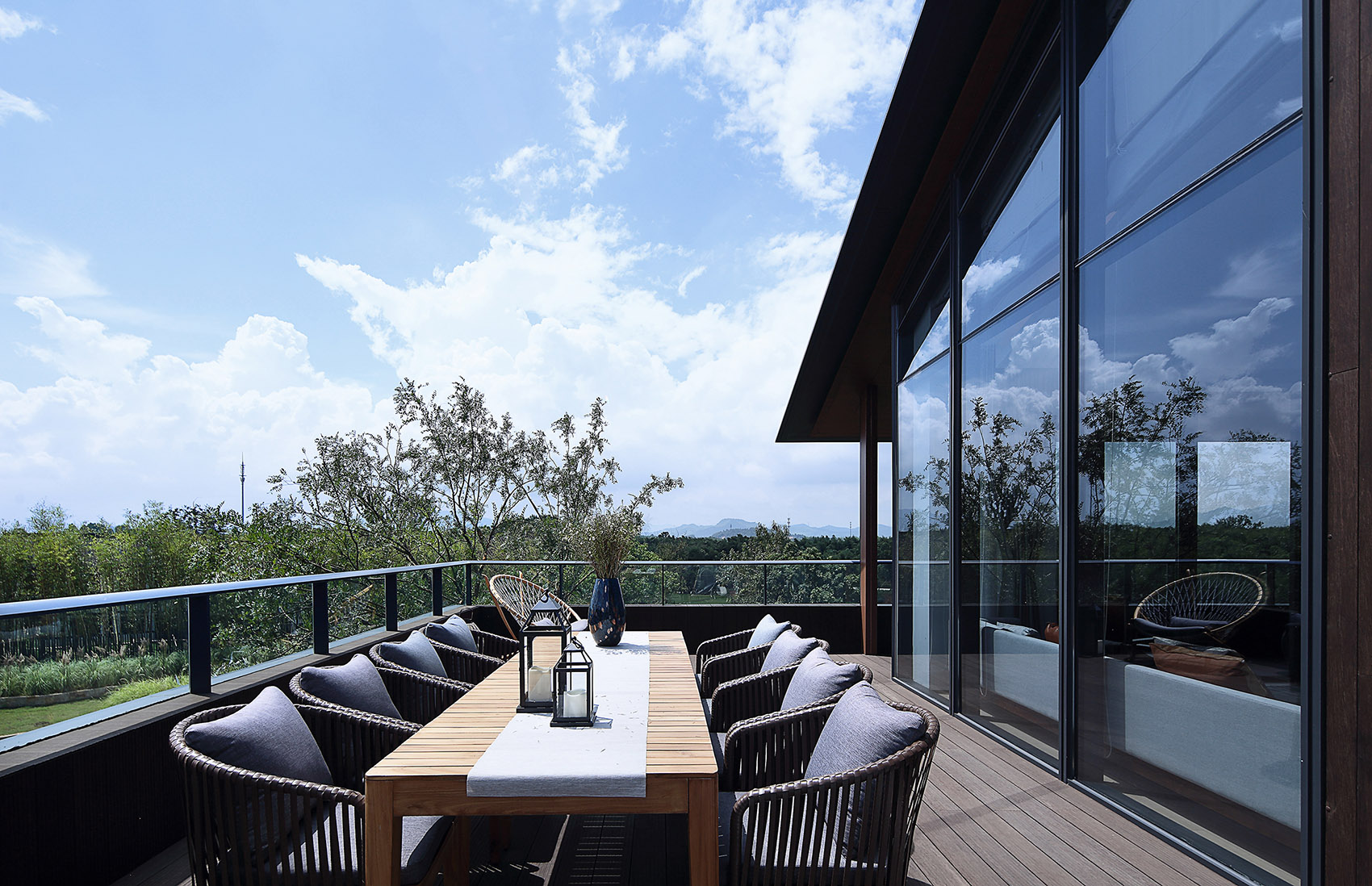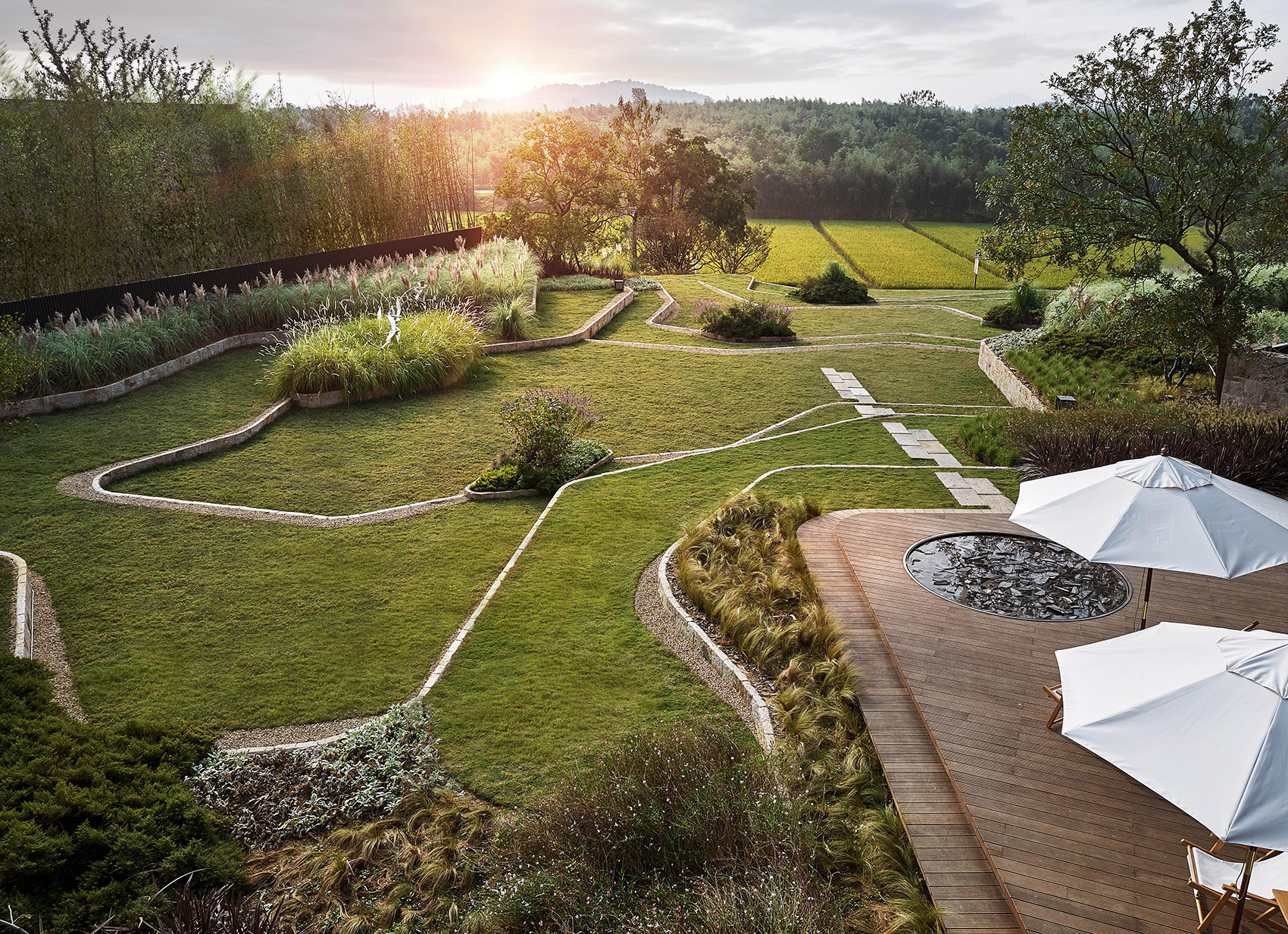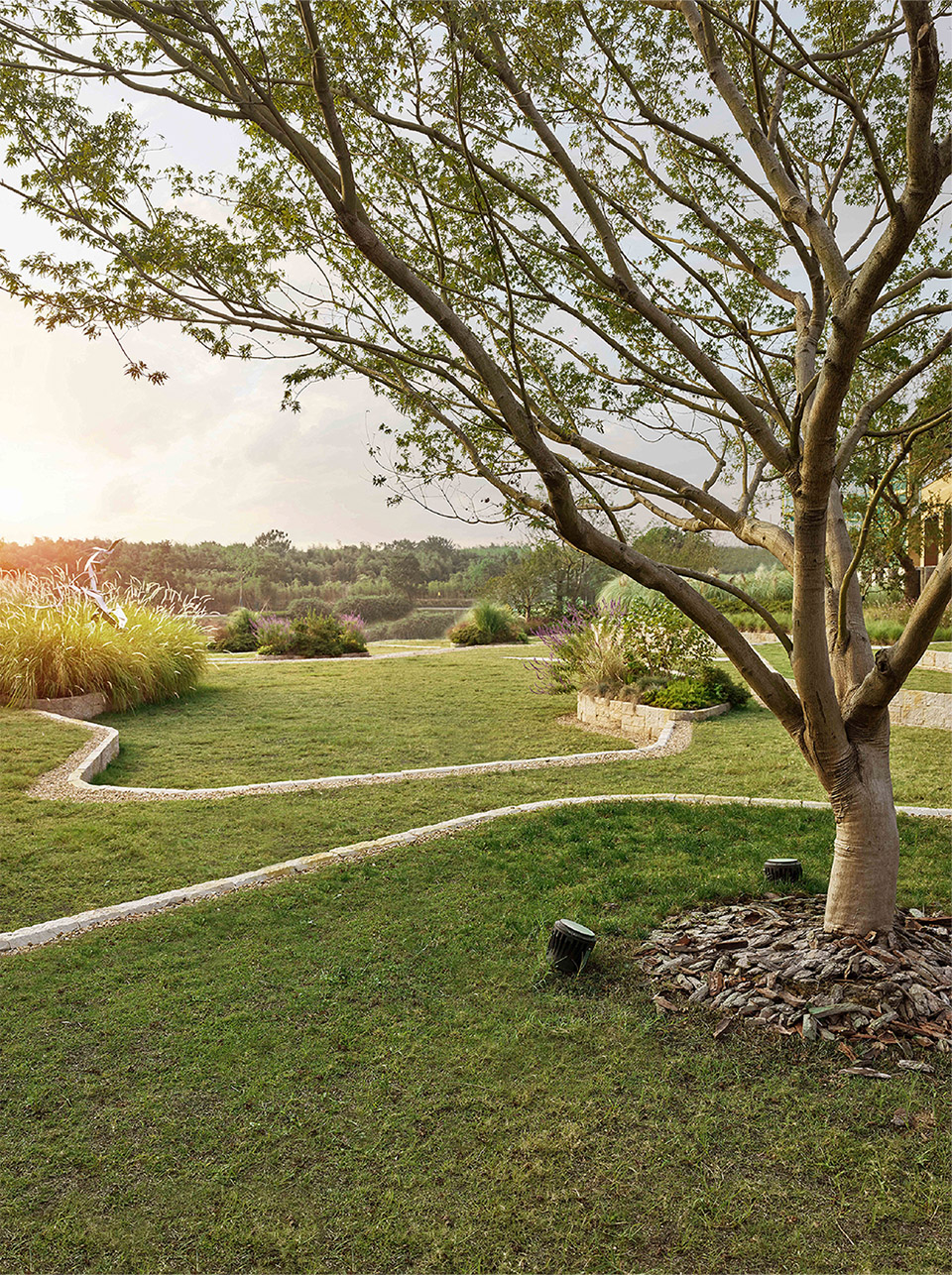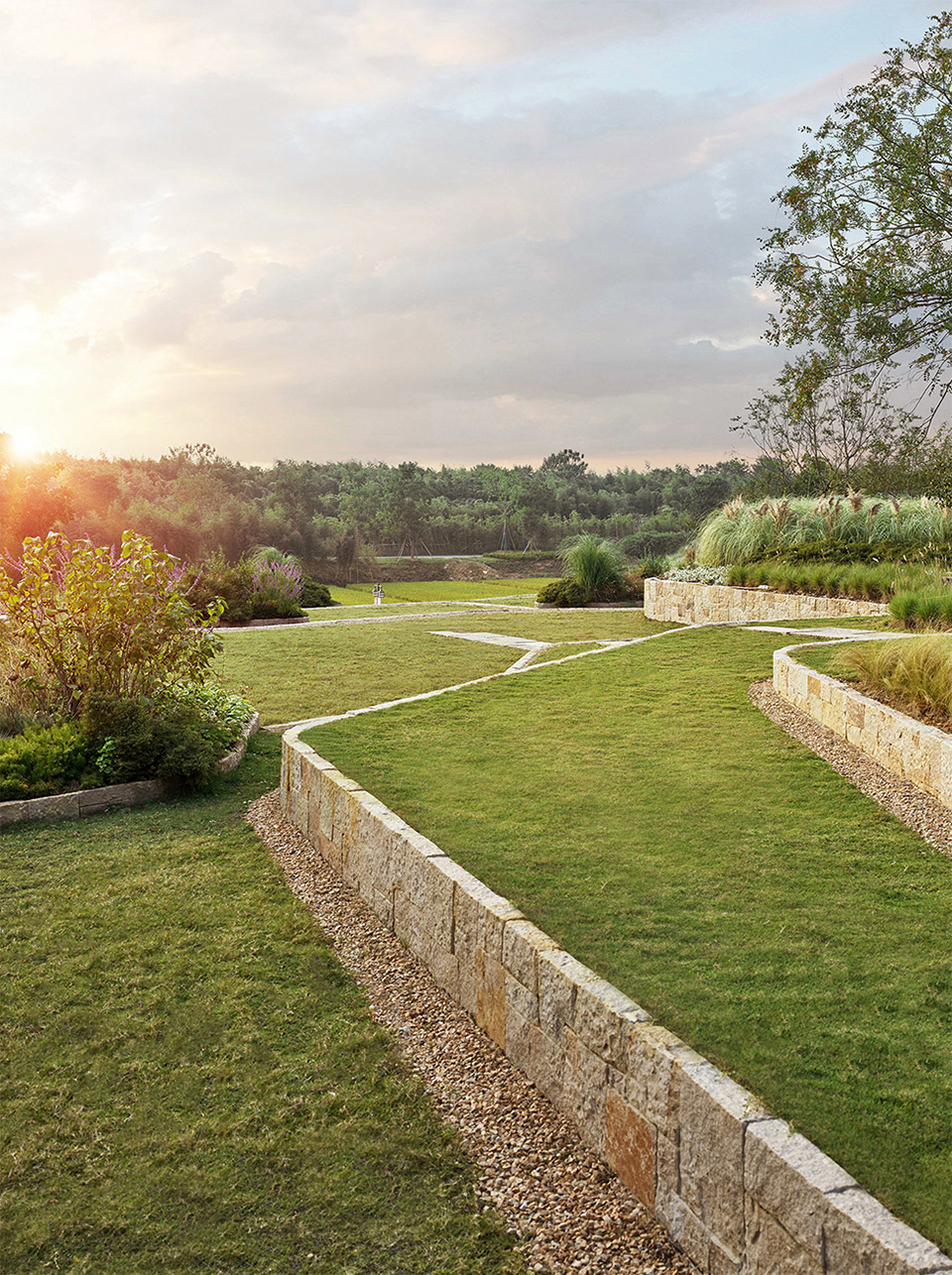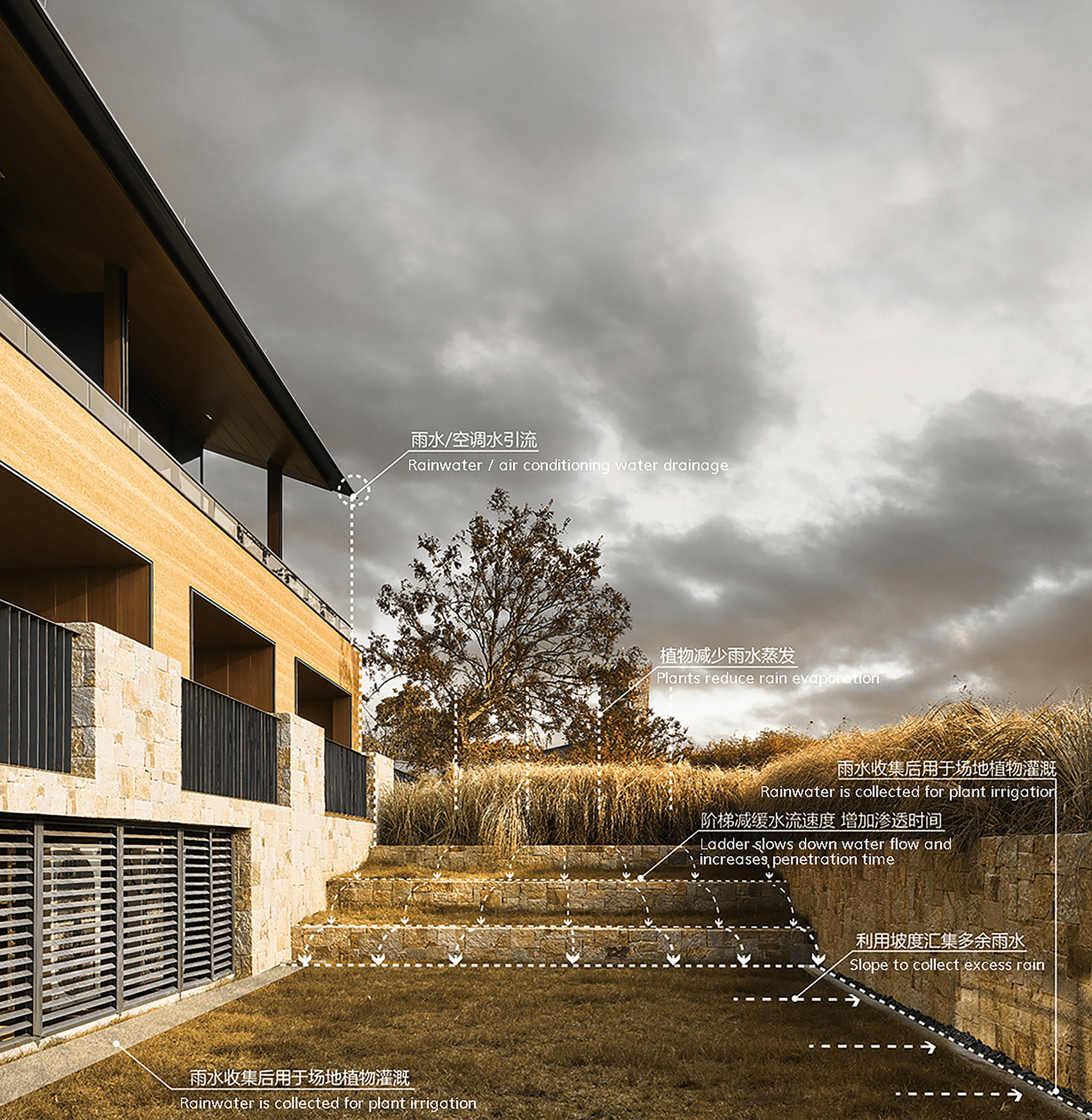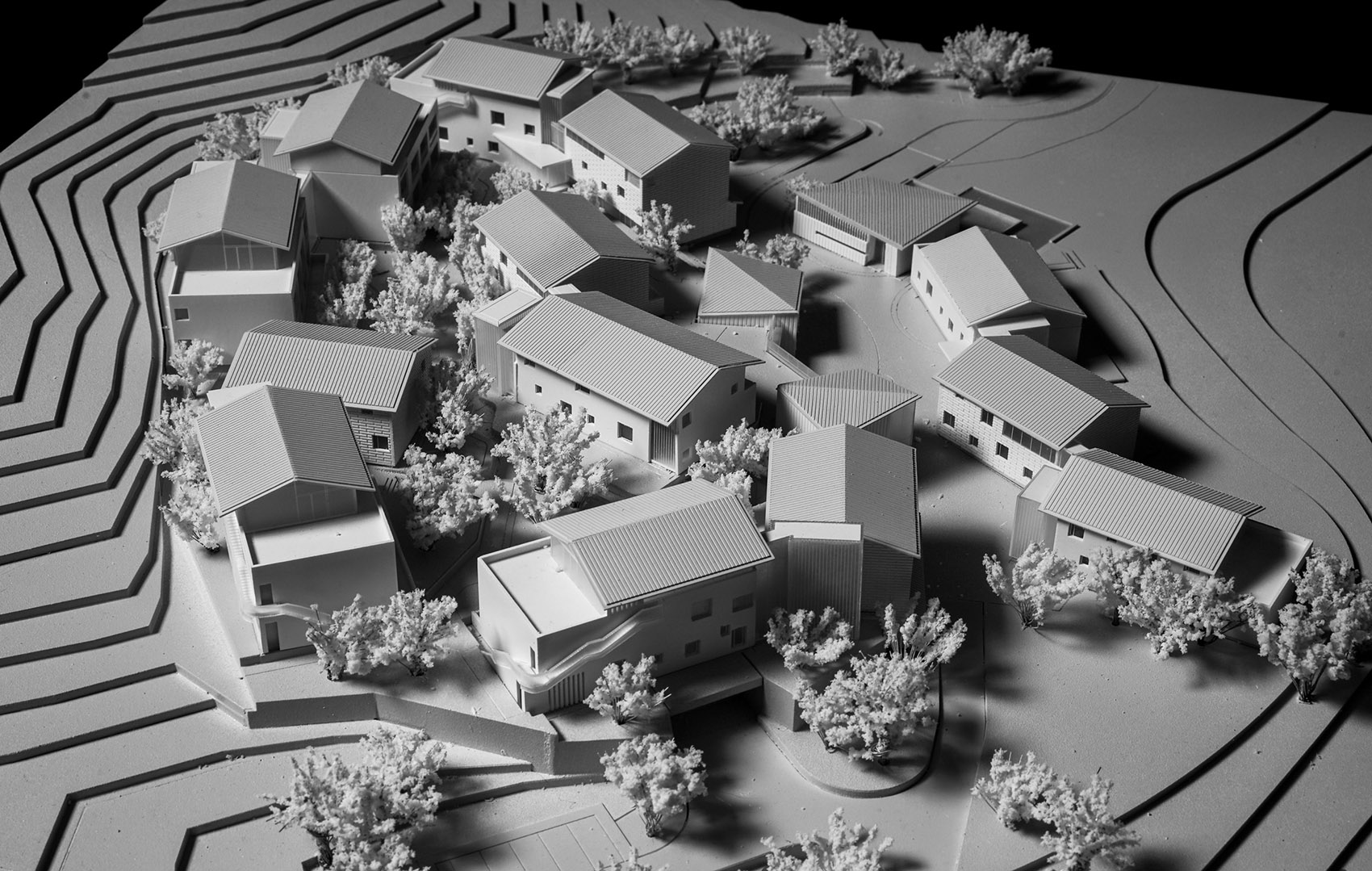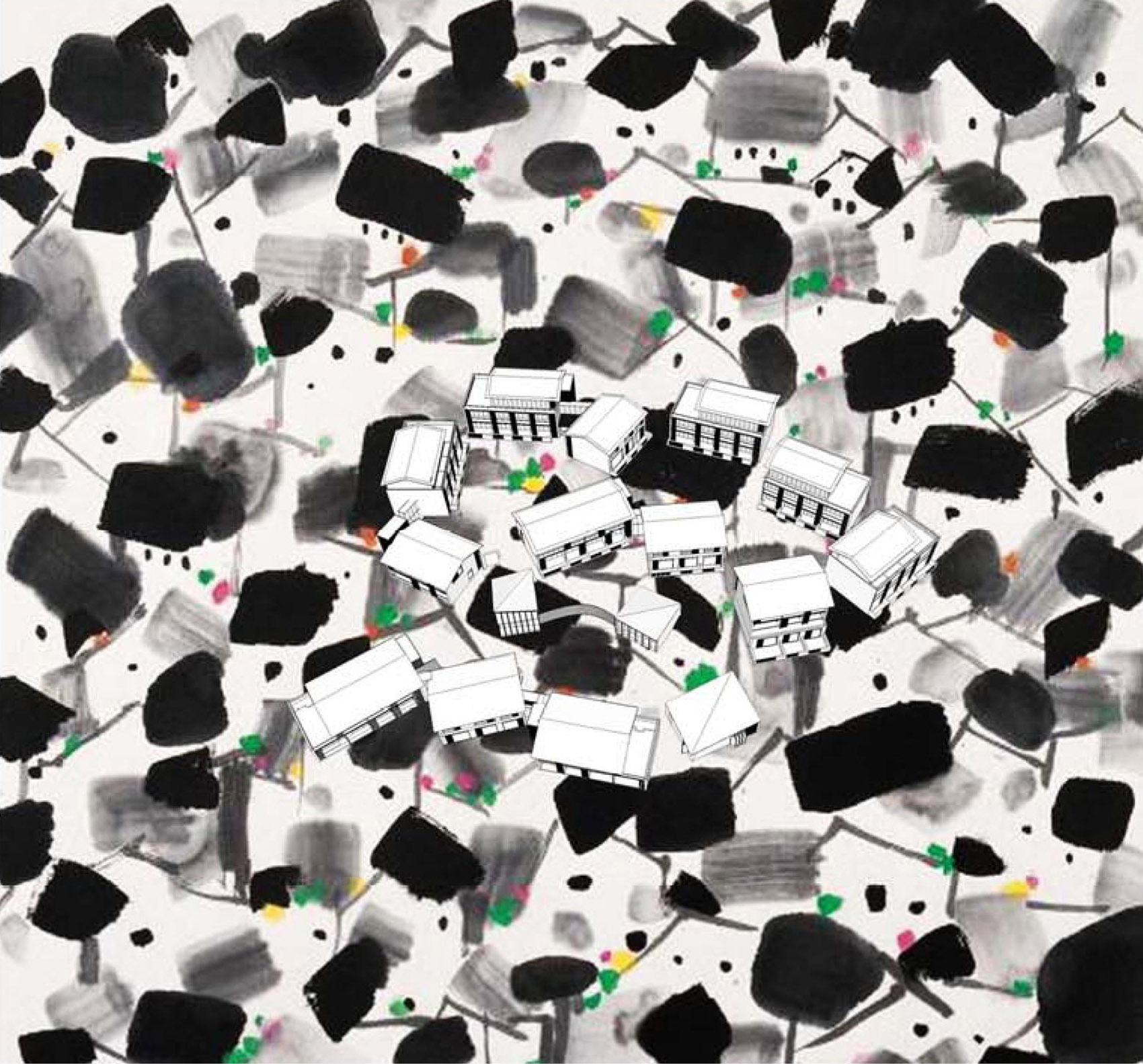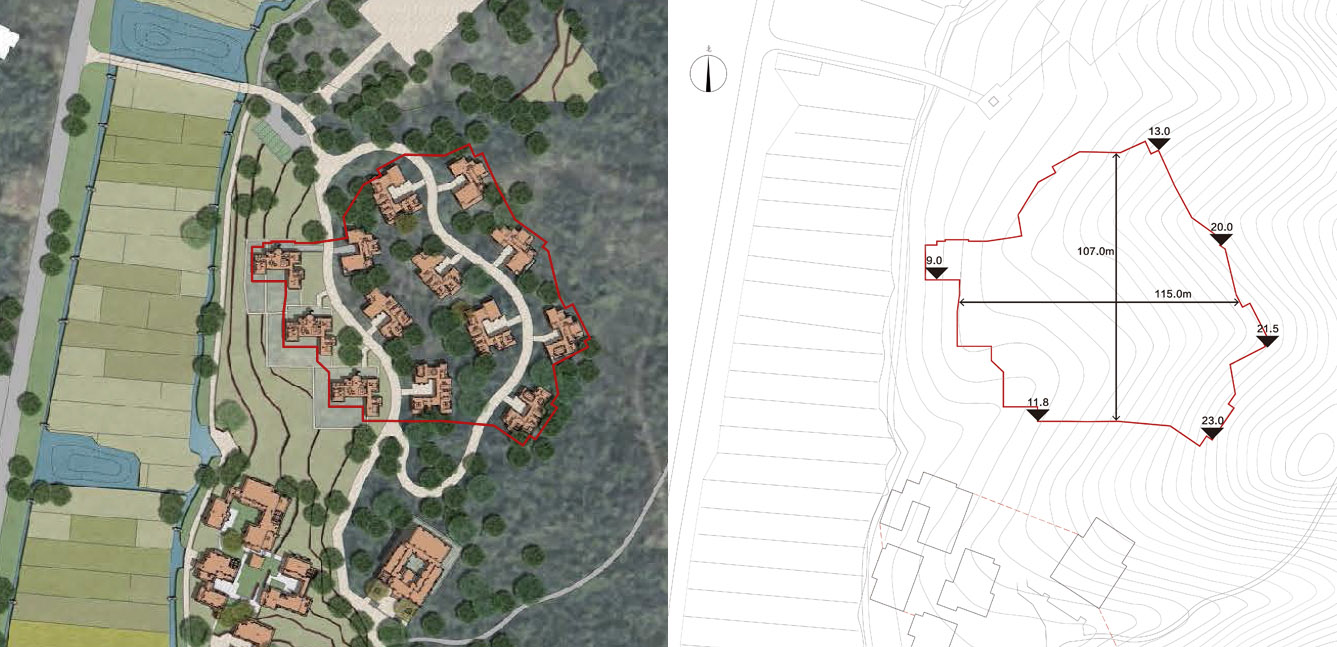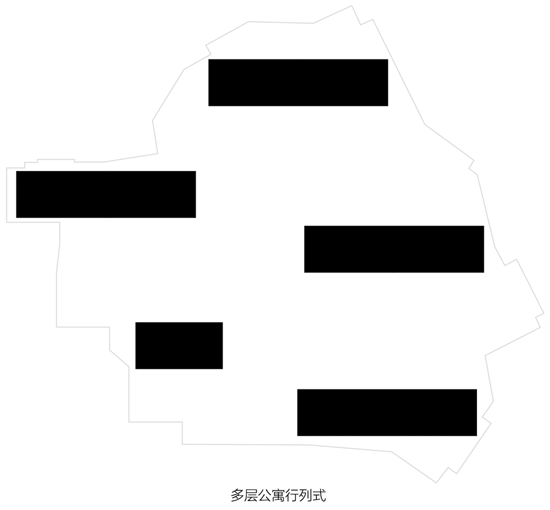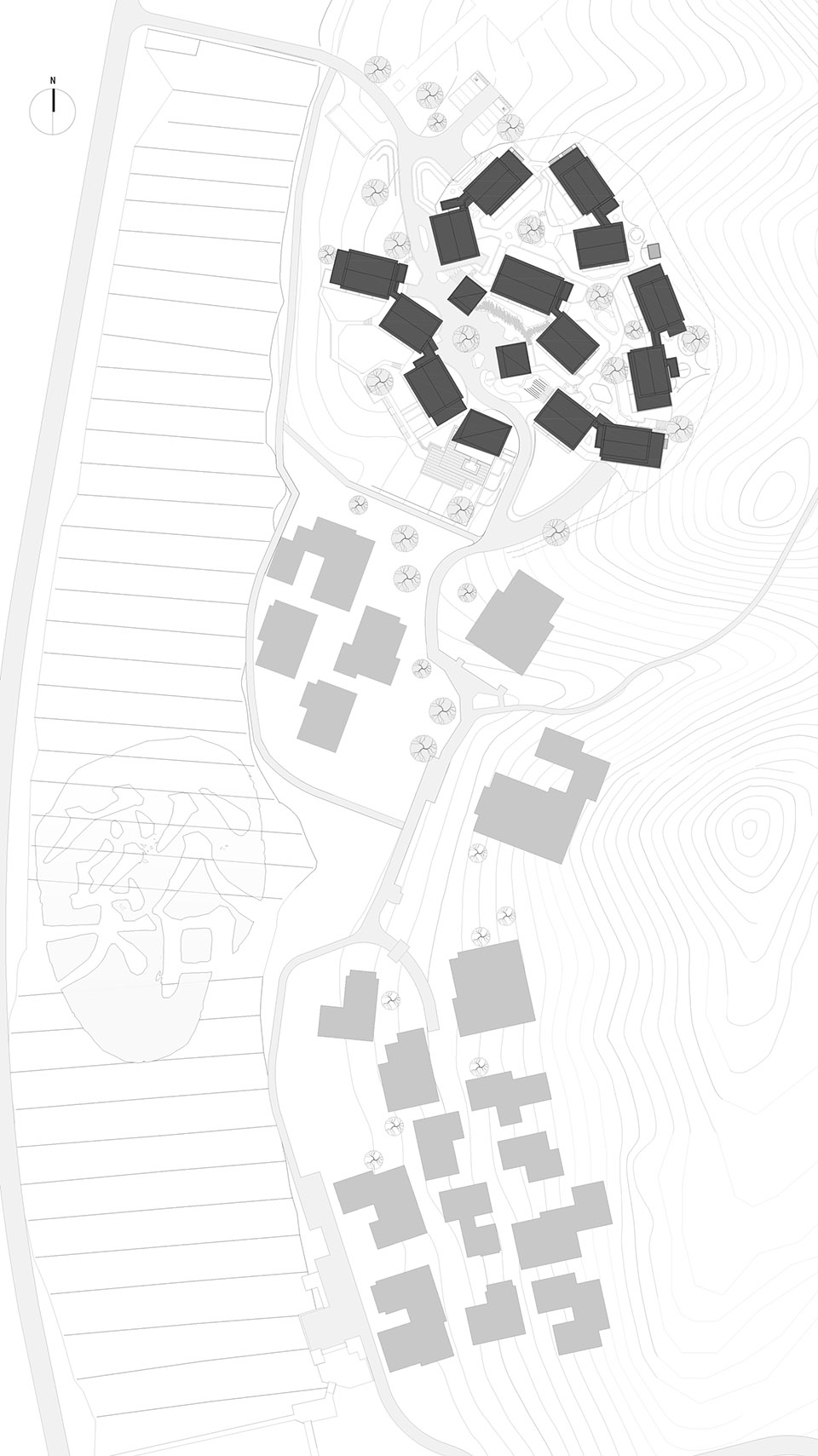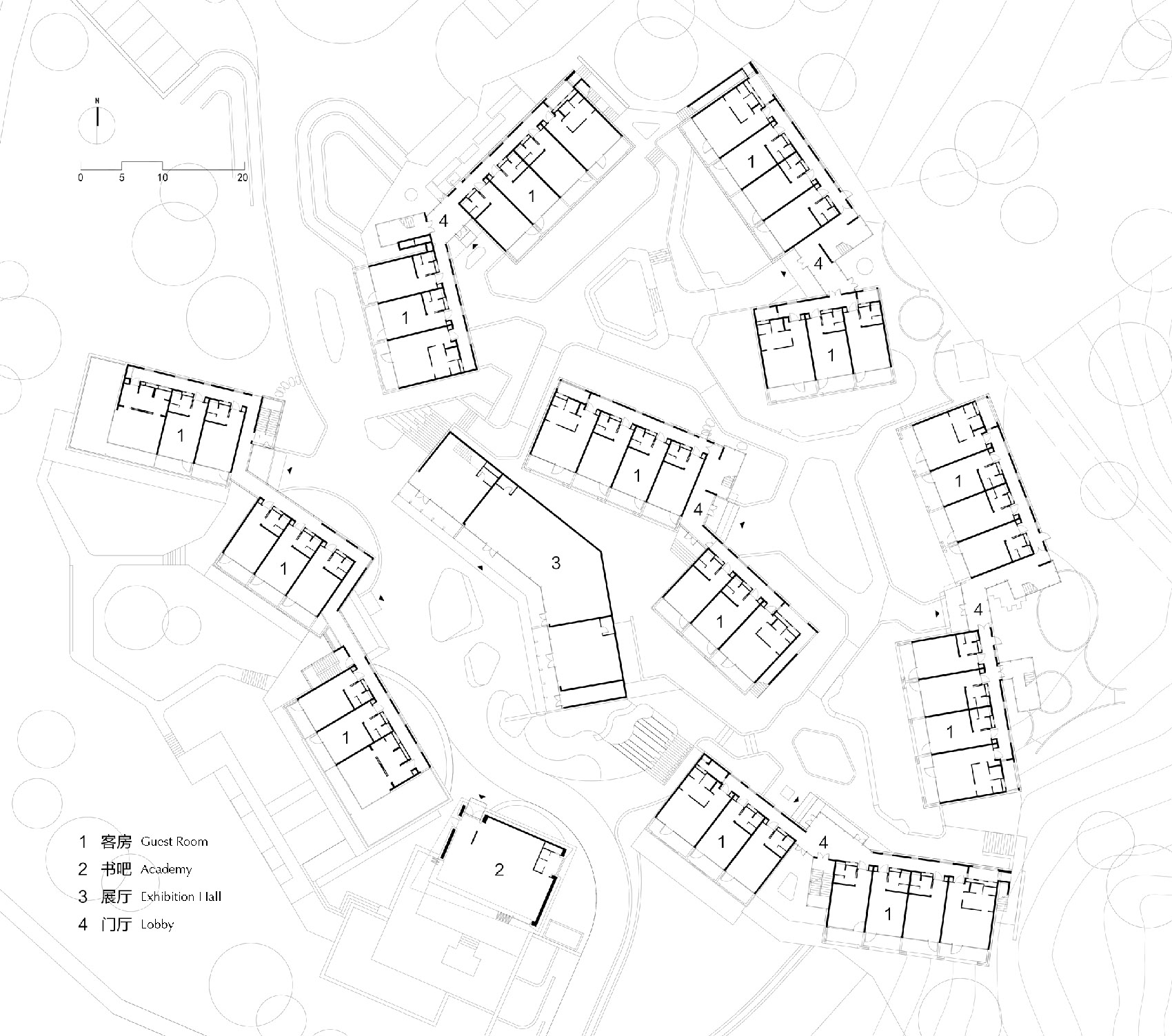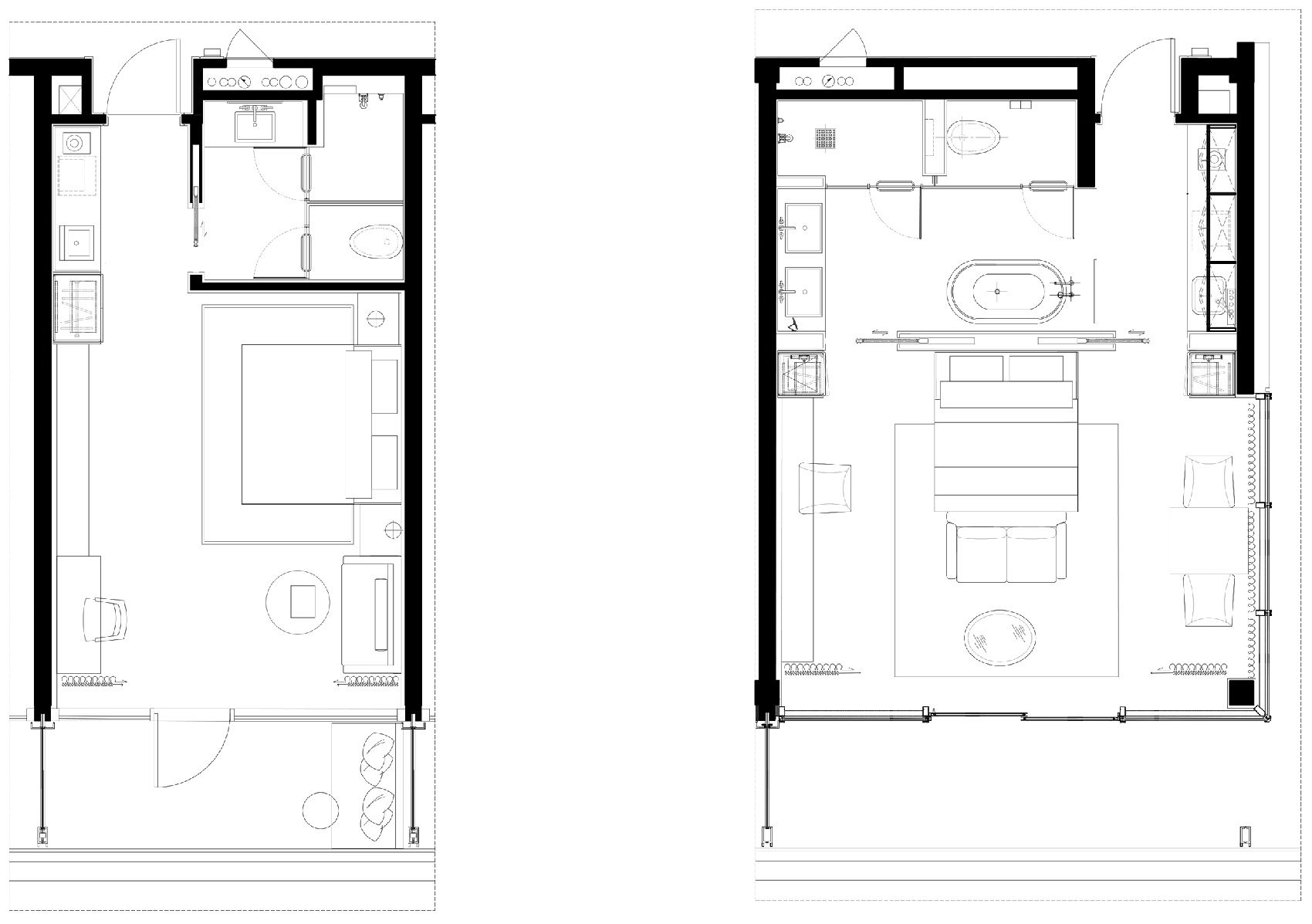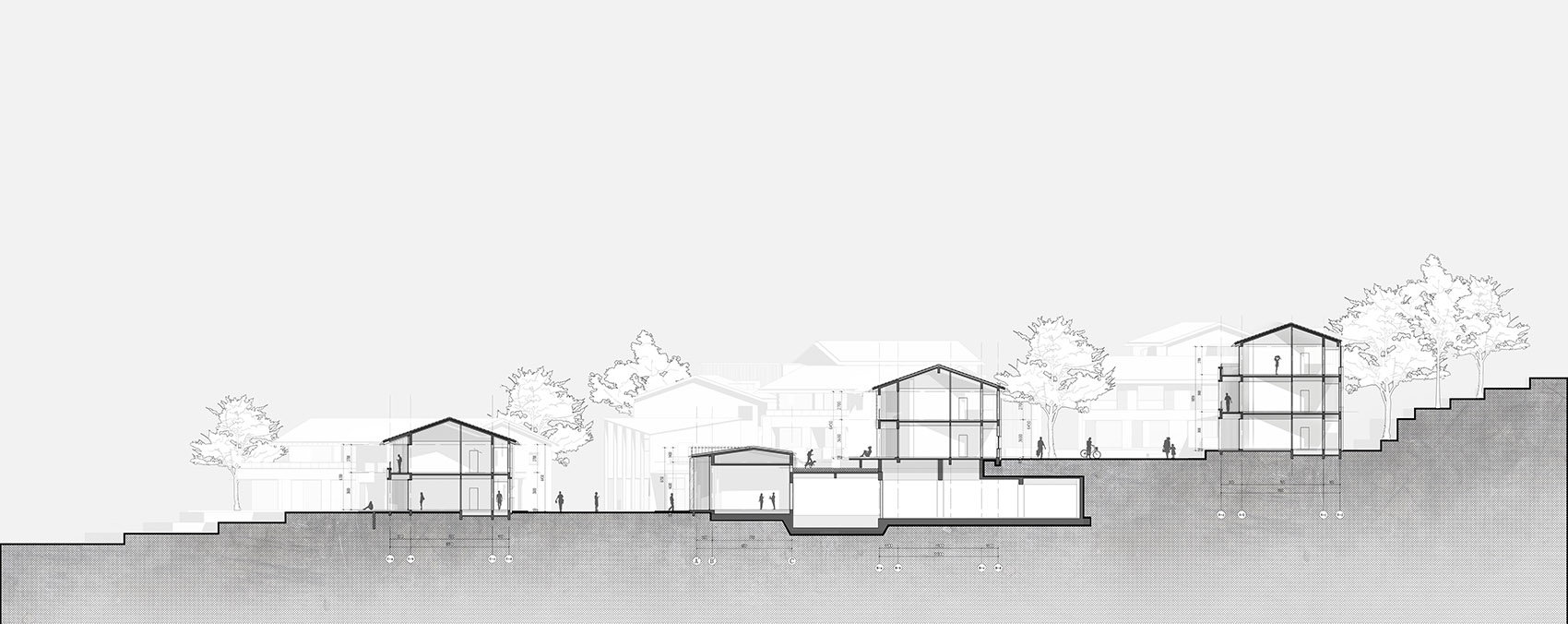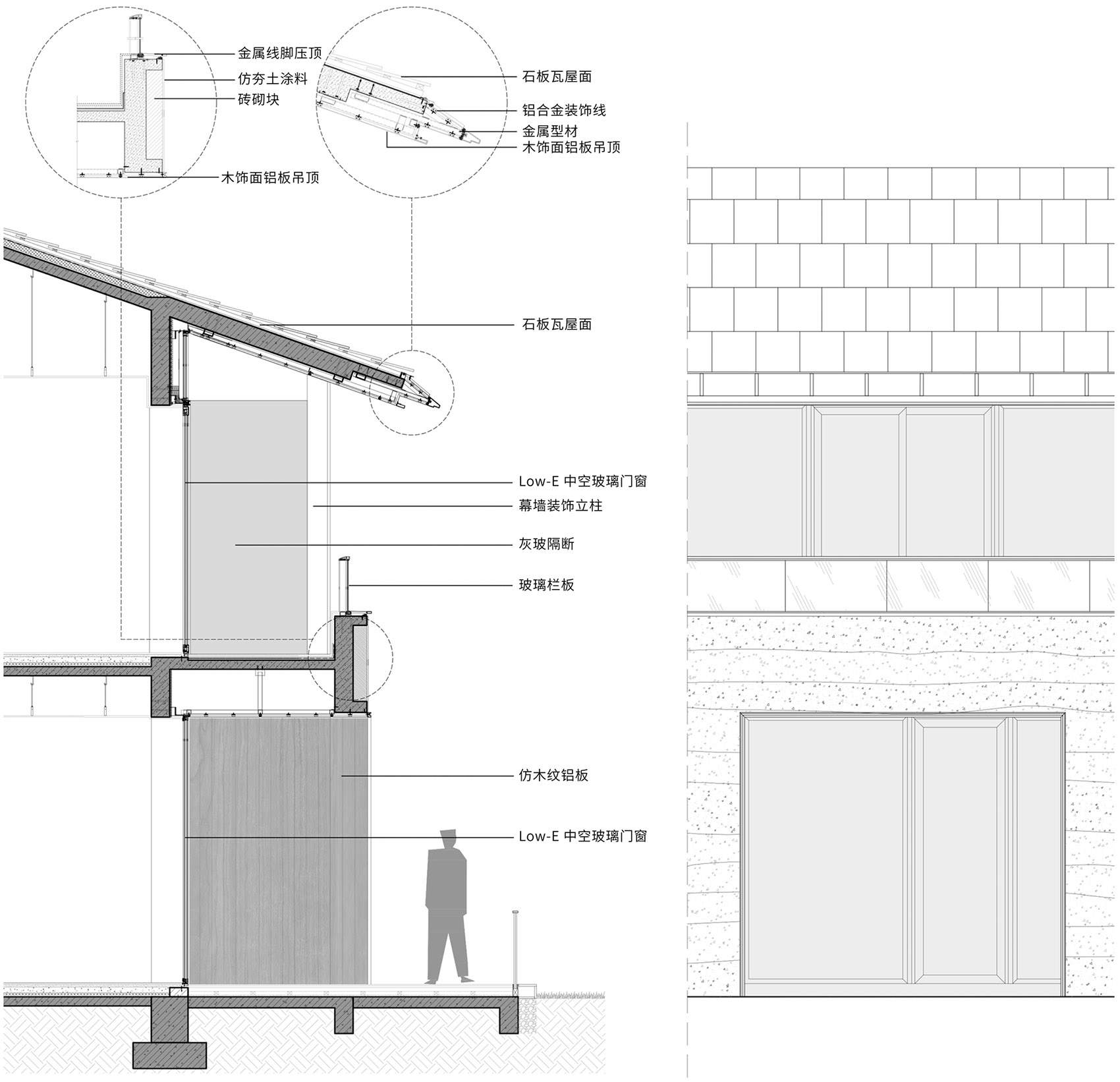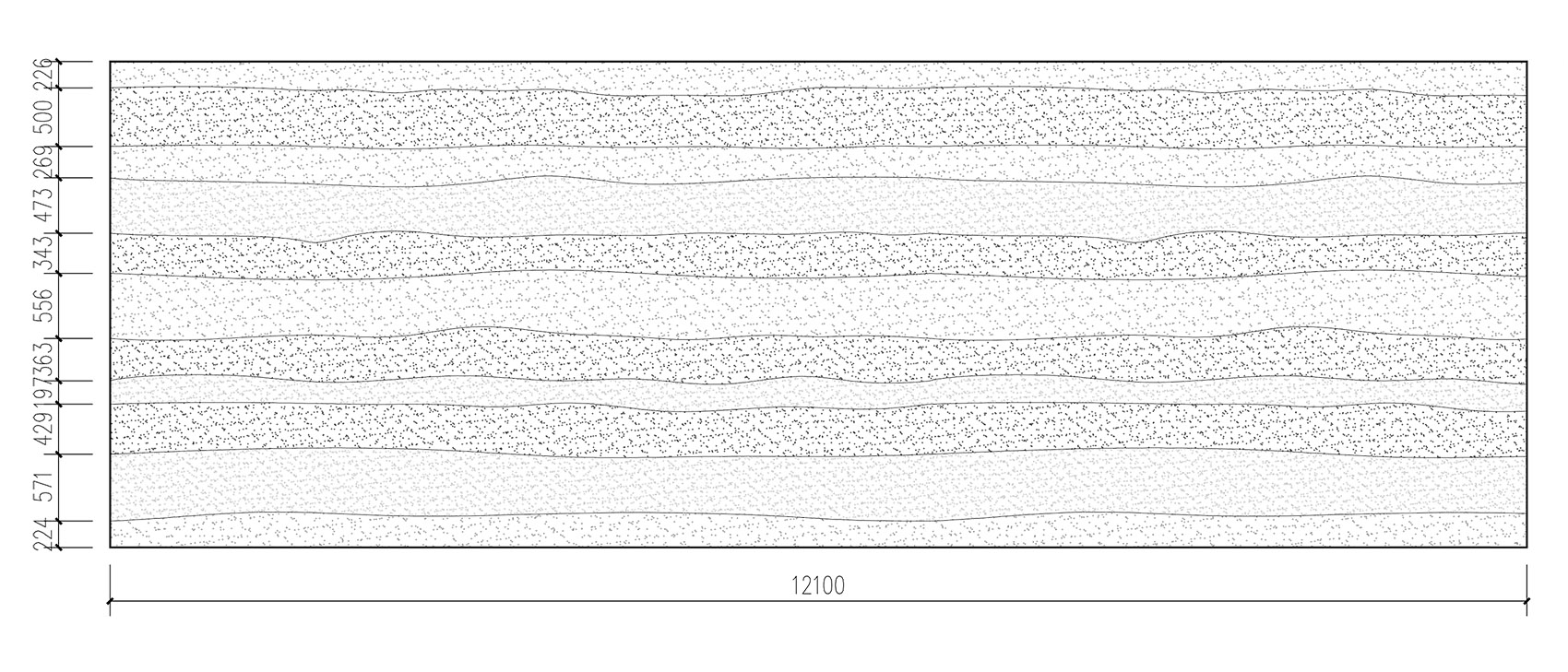无论是城市住宅还是度假小镇,中国的社区规划一直是以一种标准化同质化的风貌形态在蔓延,行列式布局、中央大花园貌似是日照规范下地产利益最大化的模式。我一直在思考,时代背景更迭、生活方式变迁以及度假社交等新型诉求的产生,传统南北向行列式是不是住区规划的唯一可能?度假产品和城市第一居所是否应该有所差异?是否有可能产生一个拥有自由界面和邻里交往场景的聚落式社区?——孟凡浩
For both urban residences and resort towns, China’s community planning has been spreading in a standardized and homogenized style. The parallel layout and the central great garden are a model that maximizes real estate benefits under the sunlight needs. I’ve been thinking about something. With the change of time background, the change of life style and the emergence of new demands for vacation and social intercourse, is only the traditional north-south parallel layout possible for residential planning? Should vacation products be essentially different from the first residence in the city? Is it possible to produce a settlement community with a free interface and neighborhood interaction scenes?——Meng Fanhao
▼项目鸟瞰,aerial view of the project ©孙磊

近年来,在人们对城市病的逃离行为和对都市人工环境的反思中,地产开发范式下的度假小镇类项目在各地掀起热潮。它们通常依托较优的自然环境、聚焦生活需求,作为度假产品或第二居所。理论上不同的居住产品类型理应对应不同的设计策略,但很显然,在中国的小镇社区设计中,依然是大量的城市规划设计策略的照搬,行列式的肌理、标准化的样式继续由城市蔓延到近郊甚至乡村。所谓的经验性默许和导致了没有人愿意打破常规,遵从经验成为惯常规则。
In recent years, given people’s behavior of escaping from urban and the reflection on the urban artificial environment, resort town projects under the paradigm of real estate development have set off an upsurge in various places. Relying on superior natural environment and focusing on life needs, they usually serve as vocation products or second residences. In theory, different types of residential products should have different design strategies, but it is clear that in the design of small town communities in China, a large number of urban planning and design strategies are still copied, and the parallel texture and standardized style continue to spread from the city to the suburbs and even the countryside. The so-called empiricism produces the tacit rule that no one is willing to break.
▼项目概览,overall view of the project ©孙磊
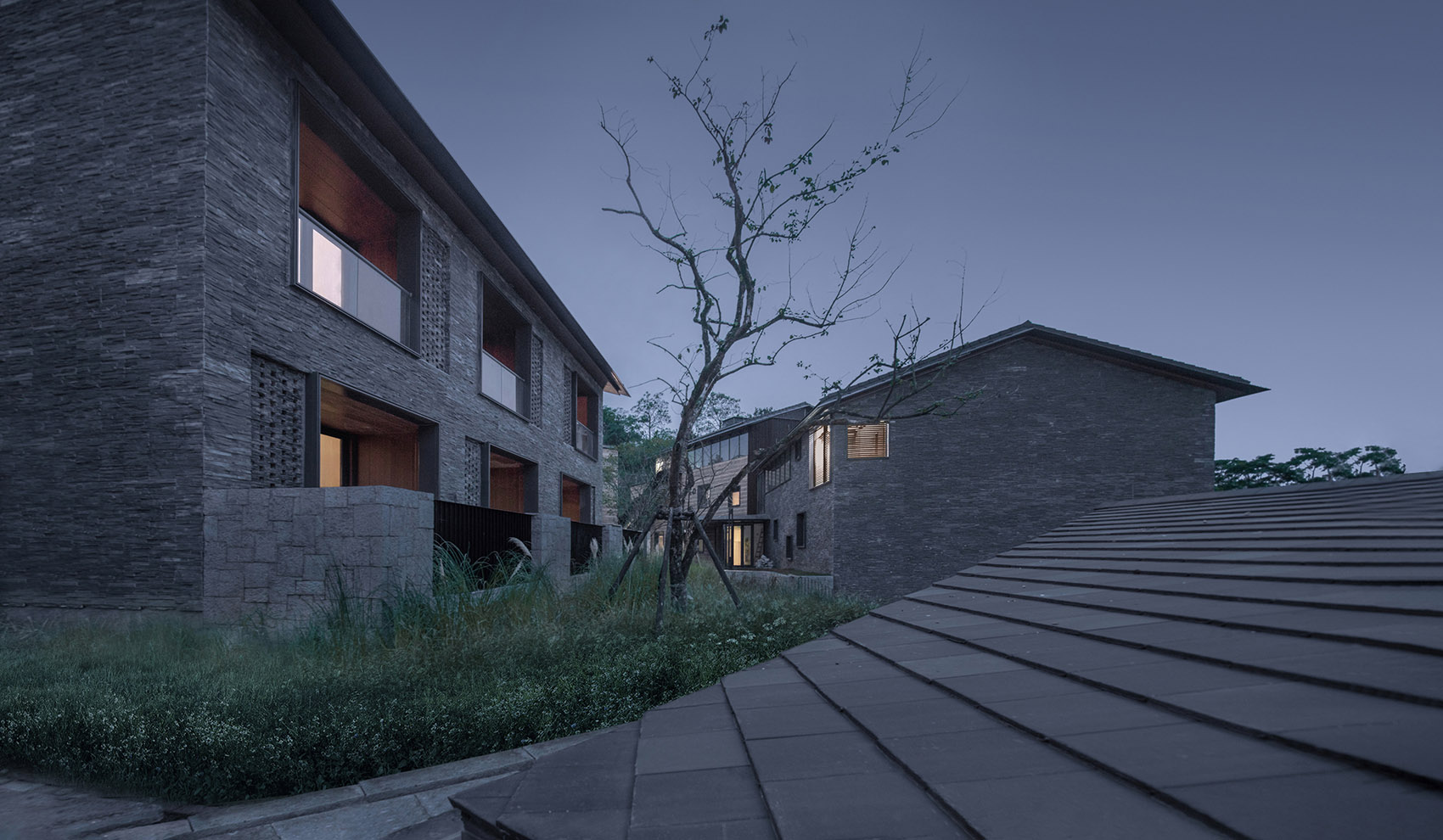
莫干溪谷 · 一亩田项目位于德清市莫干山东麓——历史悠久的度假高地。场地生于五个原生溪谷之间,基地保留了现有农田肌理及通透幽长的山谷视廊,以稻田原乡为特色,在溪谷中营造阡陌纵横的田野。基地的轮廓呈现不规则形状,南北长约 109 米,东西长约 112 米,总用地面积约一万平方米,坡地高度整体态势自西向东,自北向南递增。
Mogan Valley Yimutian Project is located at the eastern foot of Mogan Mountain in Deqing City, where it is a resort highland with a long history. Born between five native valleys, the site retains the texture of the existing farmland and the long valley tourist corridor. It is characterized by the hometown of rice fields and creates crisscrossed fields in the valley. The outline of the site takes on an irregular shape, measuring about 109 meters from north to south and 112 meters from east to west. The total land area is about 10,000 square meters. The overall height of the slope increases from west to east and from north to south.
▼轴测图,保留现有农田肌理,axonometric, remaining the existing texture of the farmland ©gad · line+ studio
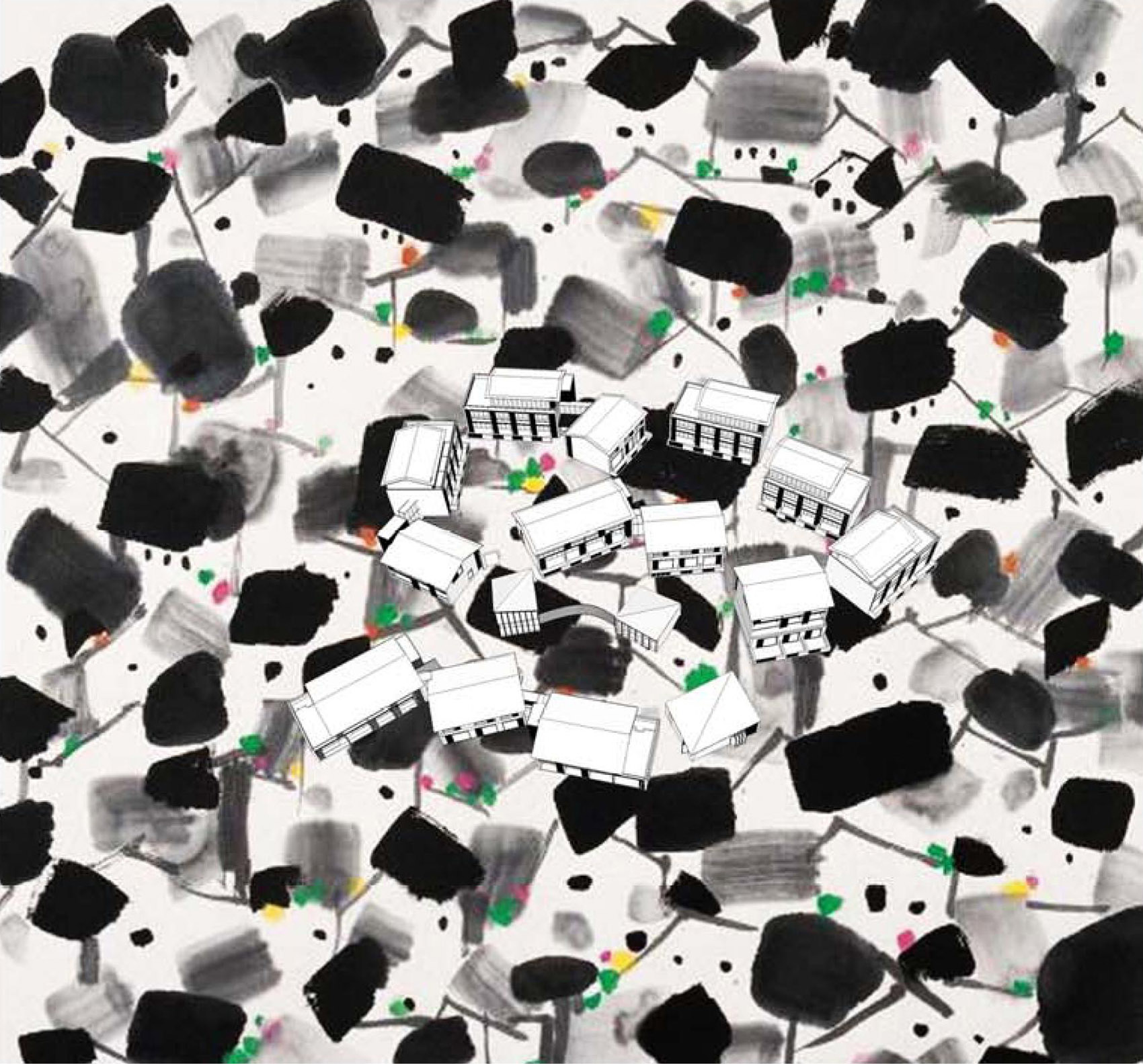
项目虽然处于背山面田、视野开阔的环境中,但性质依然是一次地产开发。业主对于项目的定位和诉求很清晰,整体大盘内已开发有大量的中式合院产品,因市场形势变化,决定废除本地块内原有的别墅方案,加入度假社区的业态,增加产品的多元性。我们作为融创高端产品系研发的战略合作团队,接受委托共同打造这一度假社区样本。
Although in an environment of mountains and fields with a wide field of vision, it is still a real estate development in nature and the owners have a clear appeal. There are a large number of popular traditional style residential products beside, in the change of the market trend; they decided to abandon the old villa scheme. It was repositioned as a resort community to make the residential products more diverse. As the cooperation team of Sunac’s high-end residential products, we are wished to do the innovation of this resorts product.
▼左:原别墅方案 右:场地分析 left: original villa scheme, right: site analysis ©gad · line+ studio
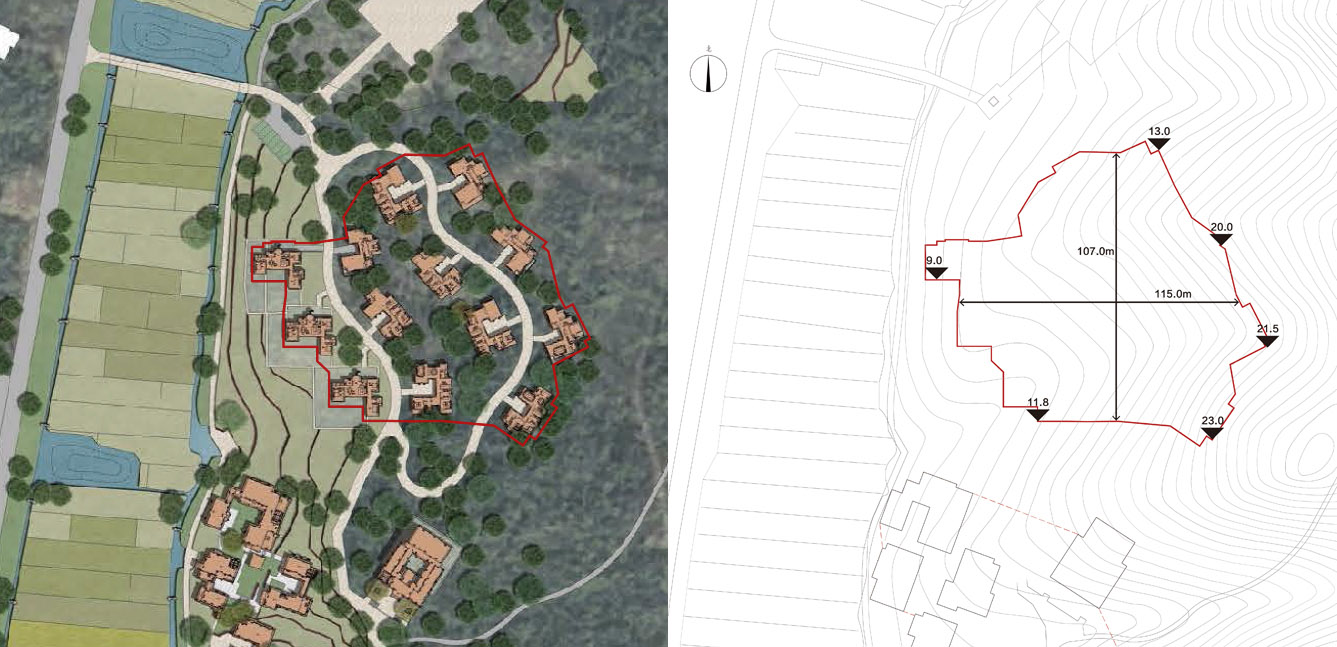
“聚落”是我们一直关注的建筑学本体课题,不论是城市中的集合住宅社区,还是有机生长的传统村落,我们的研究对象都是“聚落”——人的聚居和生活的场所。而落到每个项目,基础条件、终端使用者以及时代背景各有不同,需因势利导,对症下药。
Settlement has been the concerned subject of architectural discipline. For both a collective residential community in a city or a traditional village that grows organically, our research object is settlement-the place where people gather and live. The difference is that each project needs to consider the basic conditions, end users and the background of the times.
▼模型,model ©gad · line+ studio
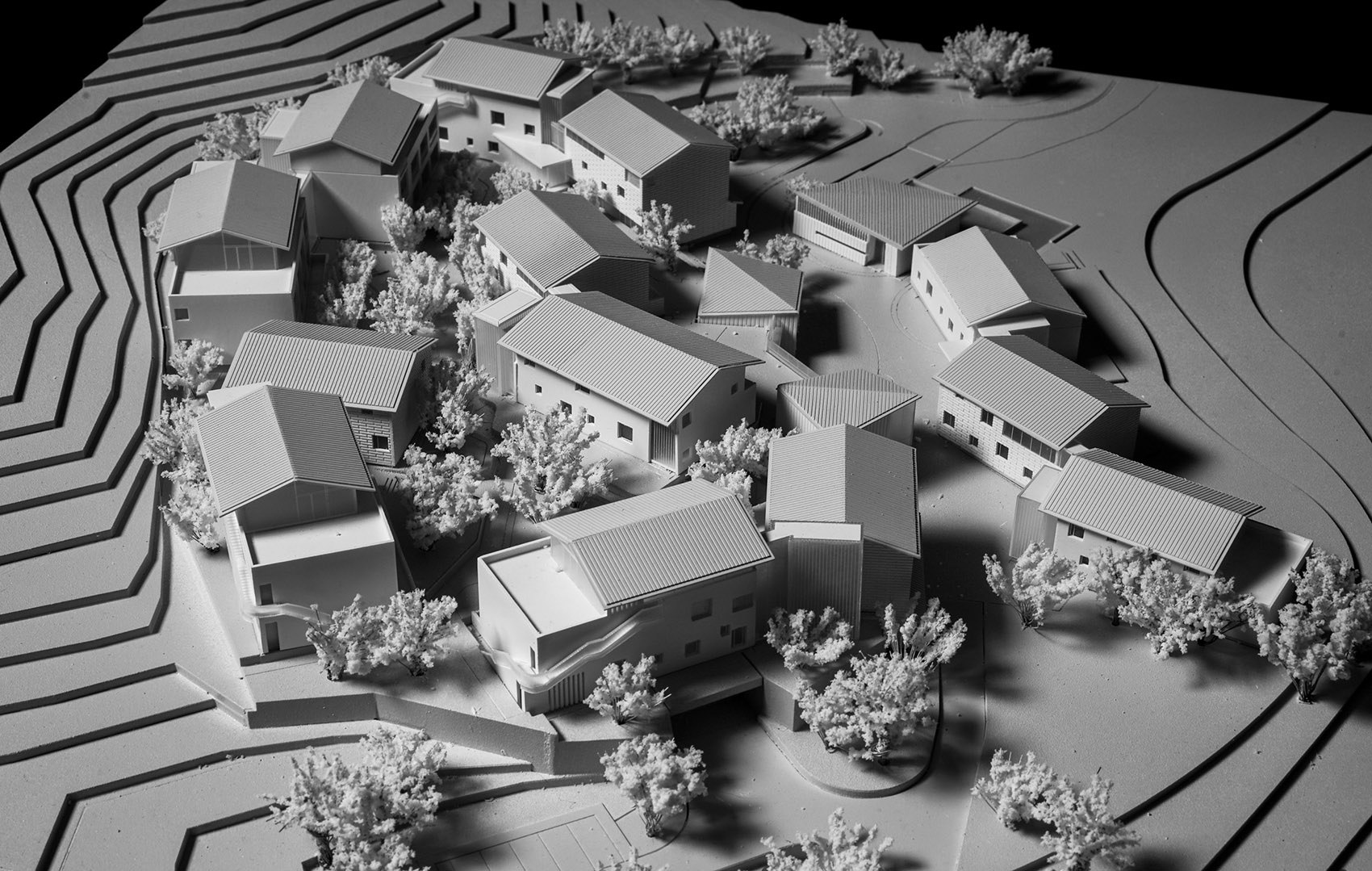
但“聚落”的思考路径往往与地产开发中的常规市场经验是有冲突的。常规的经验性规则都是基于所谓的市场客群调研的回应,很多的调研问题本身可能就缺乏引导性,大部分的客群也都是在既有认知下的一种选择,因此我一直在思考,地产模式下,传统行列式是不是当下社区规划的唯一可能?在山林自然环境中,社区的肌理有没有另外的可能性。
However, the thinking path of “settlement” often conflicts with the conventional market experience in real estate development. The conventional empirical rules are based on the so-called market customer survey. Many survey questions lack guidance. The survey from most customer groups is just a choice based on existing perceptions. Therefore, I have always been thinking, under the real estate model, whether only the traditional parallel layout is possible for community planning at the moment. Is there any other possibility of community texture in the natural environment of mountains and forests?
▼客房建筑与广场,guest room building and plaza ©孙磊
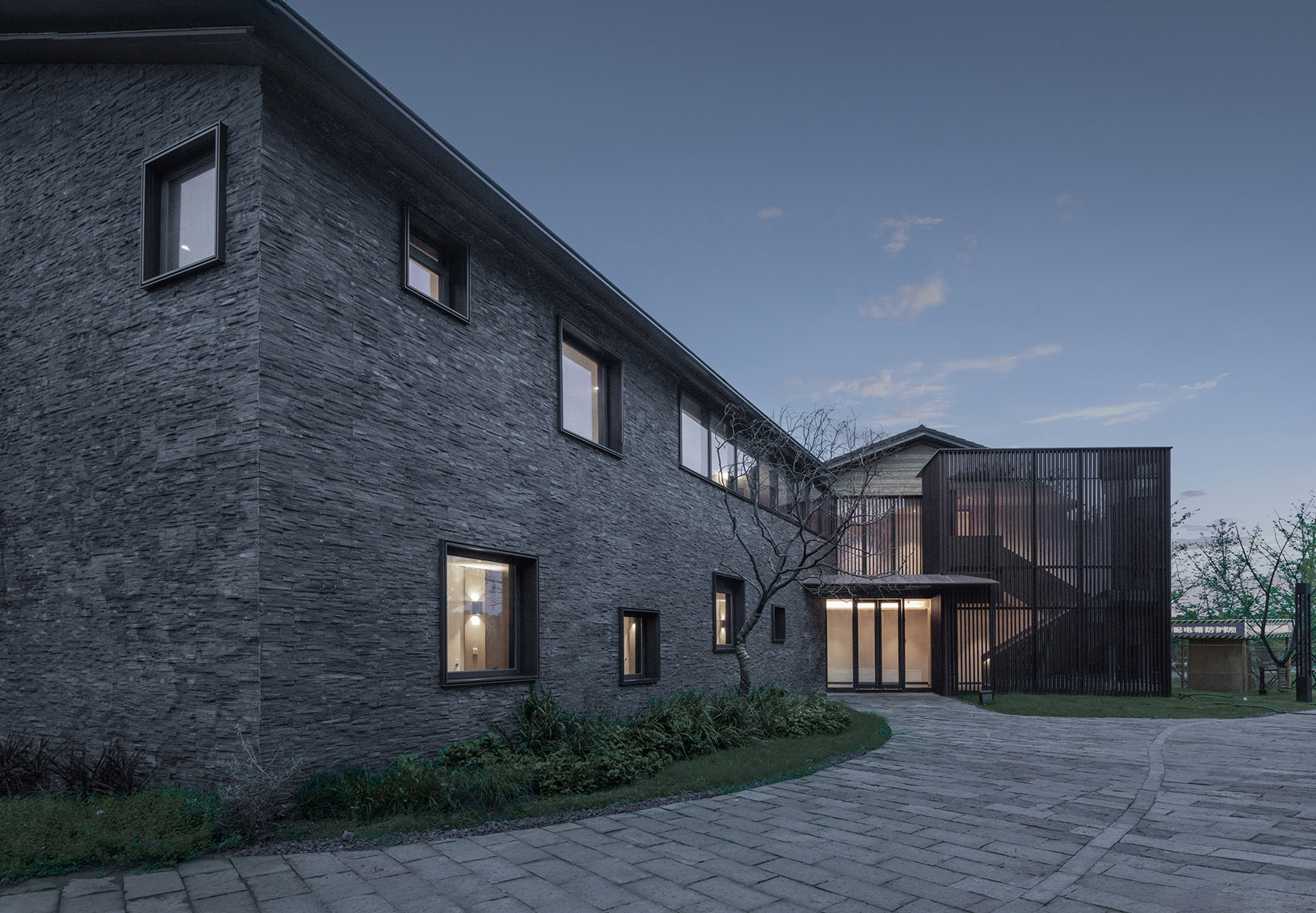
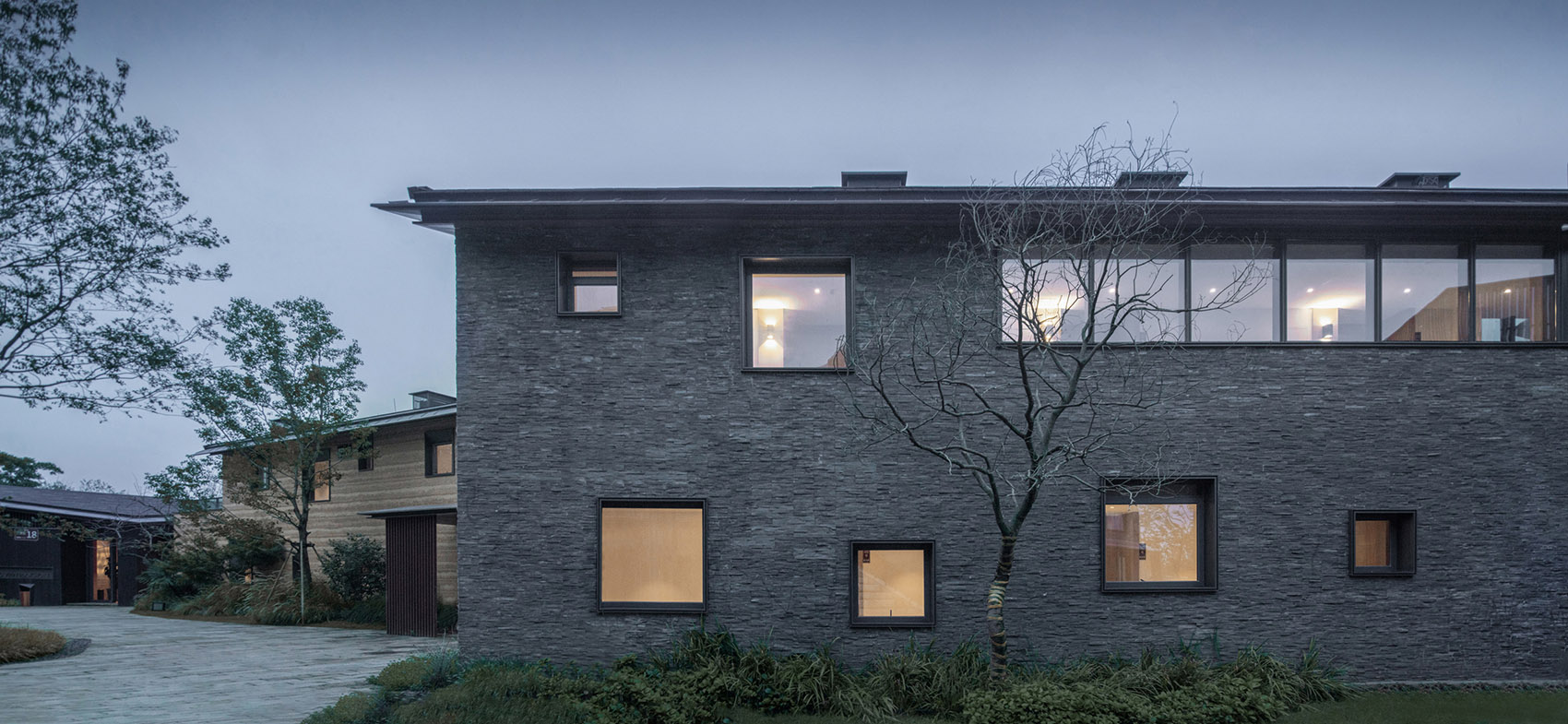
第一次到项目场地,强烈的感受到了不规则的自然边界和坡地高差,直觉告诉我,一亩田不应该是一个常规的度假公寓社区,而应该是一个融合了度假社交新型生活方式、以居住空间为载体的田园聚落社区。
When I visited the project site for the first time, I was deeply impressed by the irregular natural boundaries and the height difference of the slope. Intuitively, Yimutian should be a rural community that integrates the new life style of vacation and social activities and takes the living space as the carrier, rather than a multi-story vacation apartment community.
▼项目鸟瞰,田园聚落社区,aerial view of the project as a rural community ©孙磊

拿到任务书后经过测算,容量压力并不大,如果用足限高,多层公寓行列式是常规选择。但从地产销售维度看,一定是房子层数越少,单价越高,总货值越大。因此我们说服业主放弃多层公寓模式,选择小尺度、高密度、组团式的布局方案没有遇到任何障碍。但在总图进一步推进中我们发现,如果采用南北向行列式布局,受经验控制的空间构成所呈现的聚落形态过于几何化,与周边自然环境边界产生强烈的对立感,也失去了本身空间的场所特征。
After capacity calculations, multi-story apartment determinants are a regular choice if sufficient height is used. For the real estate sales, the lower the number of floors, the higher the unit price and the greater the total value. Therefore, it is easy to convince the owners to abandon the multi-story apartment and choose to build a small-scale, high-density, group-style building complex. However, in the design, in accordance with the north-south parallel layout of conventional residential planning, the spatial structure controlled by experience presents too geometric settlement pattern, which creates a strong sense of opposition to the boundary of the surrounding natural environment and also loses its own place characteristics.
▼肌理生成分析,texture generation diagram ©gad · line+ studio
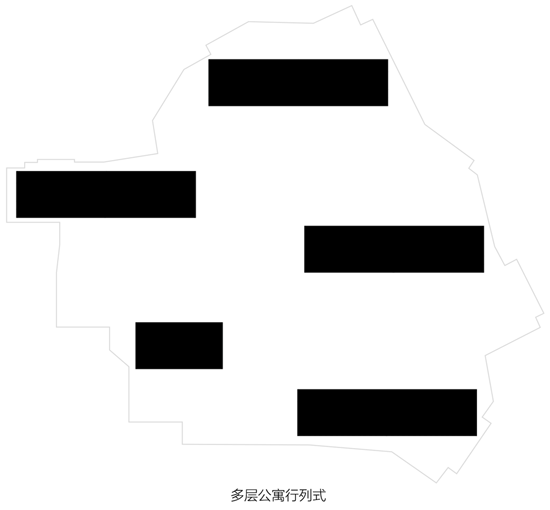
因此,我们还是坚持沿用传统聚落空间的构成逻辑,使其符合原始的肌理特征——因地制宜、依坡就势,以地形高差和田园景观建立聚落边界,以街巷空间、局部家庭群体的公共空间来联系邻里关系,以景观平台构建人群交往空间,以文化空间构建核心公共空间。在自然起伏的山地上,我们大胆地将建筑单体自由布局,顺势顺地而为,在保留了四个主要院落的基础上,通过建筑的扭转变化,创造出次级的室外空间,大大丰富了整体群落的空间层次。功能上,我们将公共空间置于第一、第二排之间,围合形成广场,产生公共界面。同时结合台地,在剖面上尽可能实现景观视野的互不遮挡,完成聚落的重构。
Therefore, we still adhere to the composition logic of the traditional settlement space, so that it can conform to the original texture characteristics, namely, the settlement boundary is established by the terrain height difference and the idyllic landscape, neighborhood relations are connected by the street space and the public space of local family groups, the landscape platform constructs a space for communication among people, and the core public space is constructed with cultural space. On the naturally undulating mountain, we boldly lay out the individual building freely according to the terrain. While retaining the four main courtyards, change the building orientations to create secondary outdoor spaces, which greatly enrich the spatial level of the community. In terms of function, we put the public space between the first row and the second row to form a square and create a public interface. At the same time, combined with the platform, we try our best to achieve the non-blocking of the landscape view on the section, to complete the reconstruction of the settlement.
▼场地剖面,因地制宜,section following the topography of the site ©gad · line+ studio
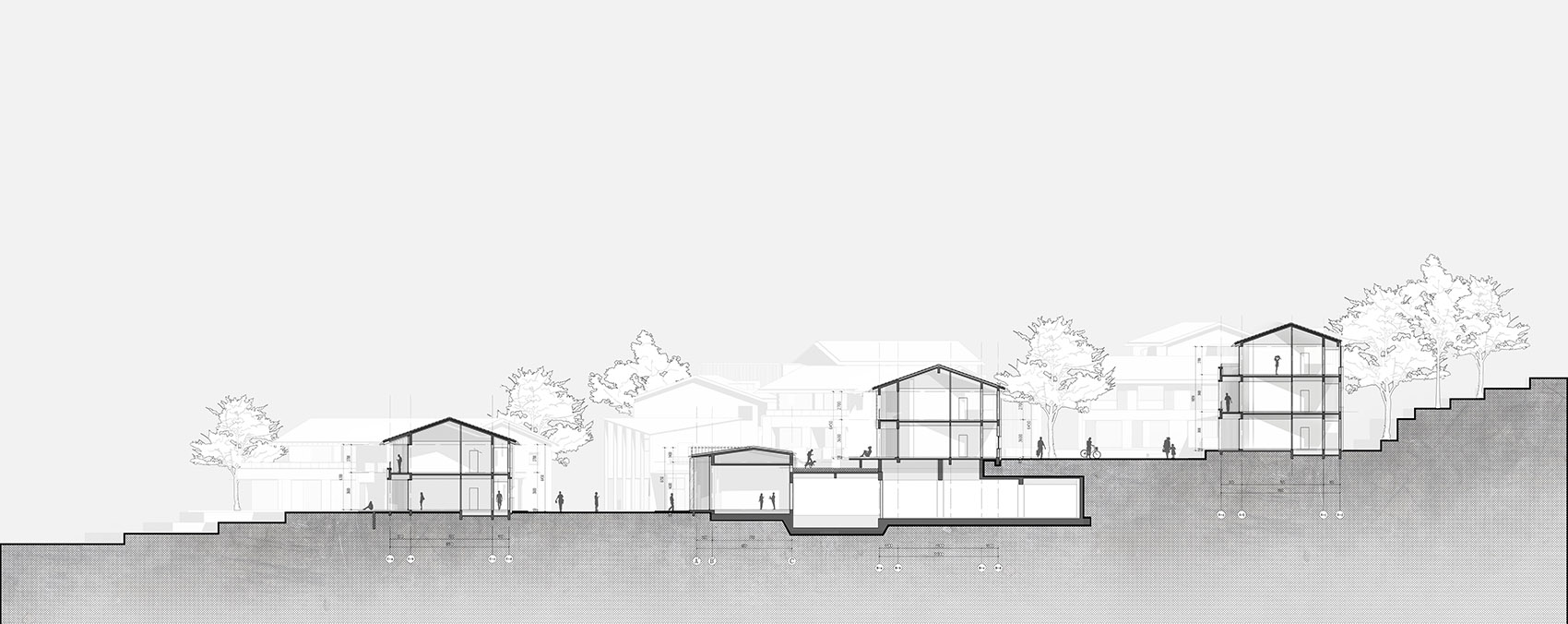
首轮汇报后,业主营销端针对建筑布局的市场接受度提出了置疑。他们认为角对角的非常规布局对几乎标准化的市场来说可能是一场冒险, 希望回归到稳妥的南北向正交网格方案。
After the first round of reporting, the marketing department questioned the marketability of the building layout. They believe that the diagonally unconventional layout is a risk for the nearly standardized market, and hope to restore a stable orthogonal grid scheme.
▼顶视图,top view ©孙磊
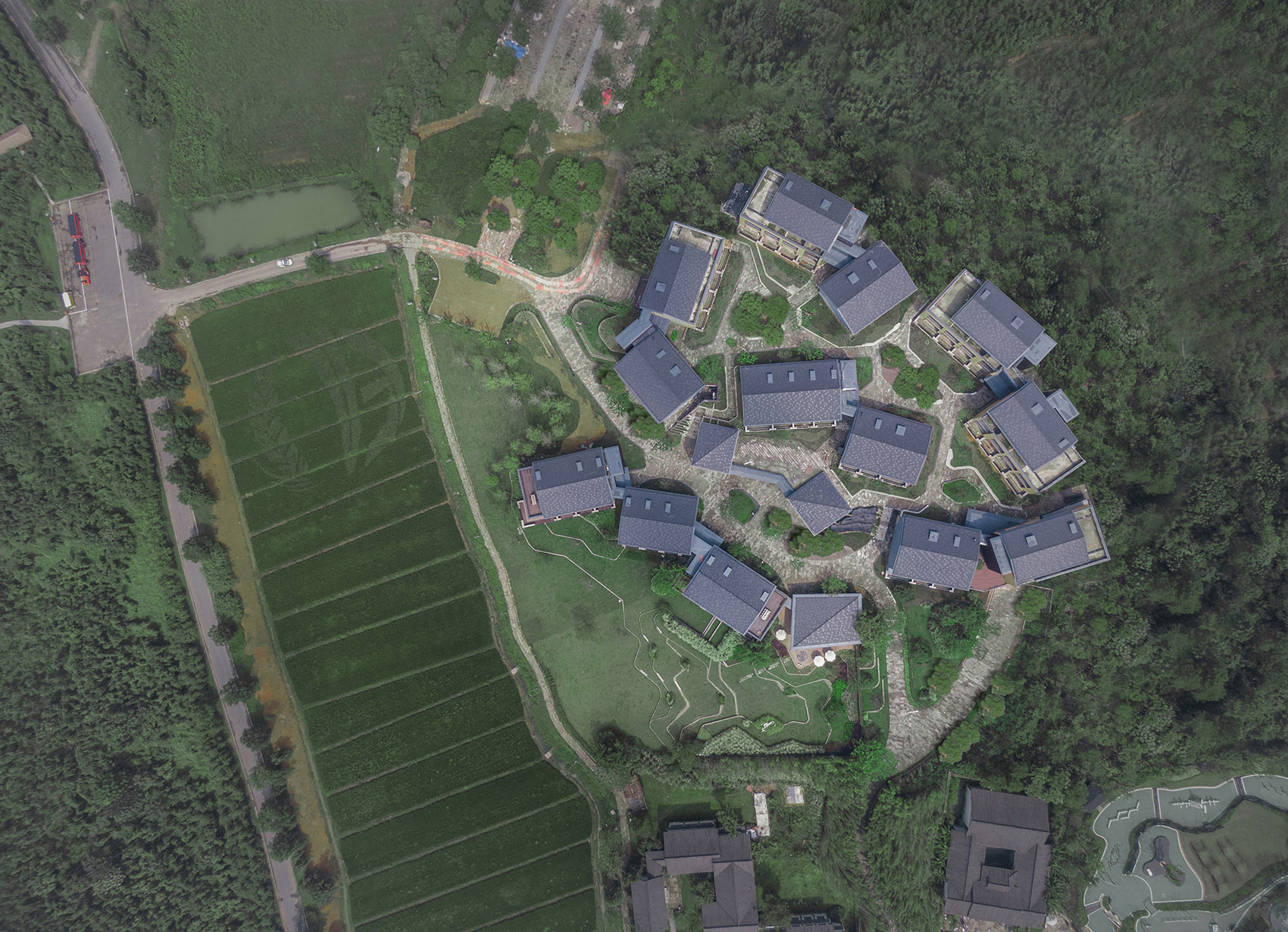
▼鸟瞰图,aerial view ©孙磊
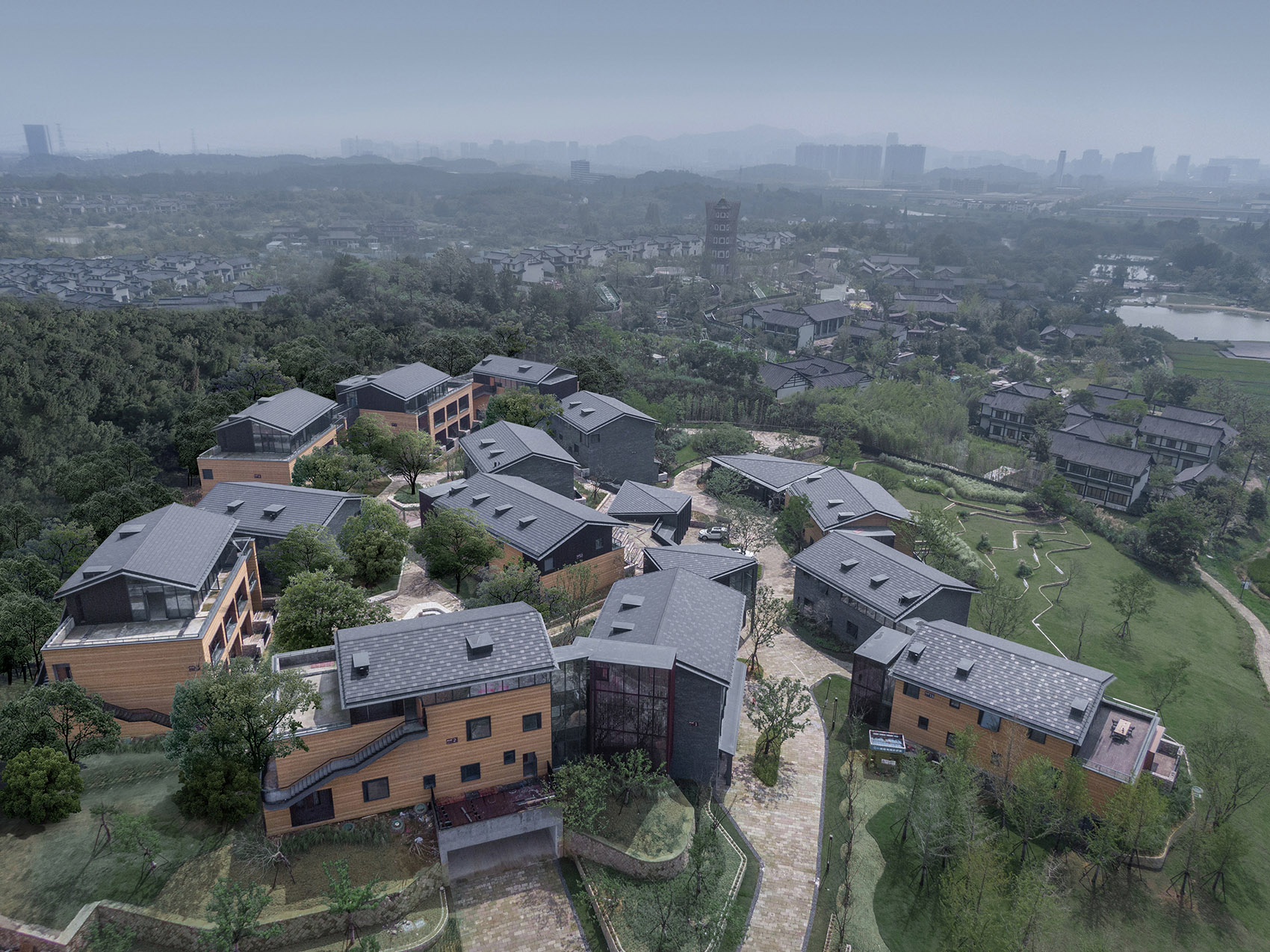
但我认为,产品的迭代突破一定是基于使用方式和定位的变化而驱动的,在解决基本居住空间需求后,居住者还会有哪些进一步诉求?面积更大?房间更多?很显然都不是。在我看来对于度假产品,更注重的是与自然风景的互动关系,是新的生活方式引领下所创造的体验感。其次,作为度假产品,第二居所的评价纬度是否应该和城市中的第一居所有差异?以刚需、改善以及收藏等为目的的人群是否有不同产品诉求? 而我们提供的产品是否过于单一,过于依赖现实经验?
In my opinion, the innovation strategy is driven by changes in functions and positioning. After solving the basic residential needs, does the dweller have any other requirement? Large area? More rooms? Obviously neither. For most of them, they prefer for the real natural view and the living experience guided by the new lifestyle. Secondly, as the resort space, should the evaluation latitude of the second residence be different from the first residence in the city? Do people with the purpose of just need, improvement, and collection have different product demands? And is the product we provide too single?
▼居住体块和依地势设计的阶梯状景观,residential volumes and terraced landscape ©孙磊
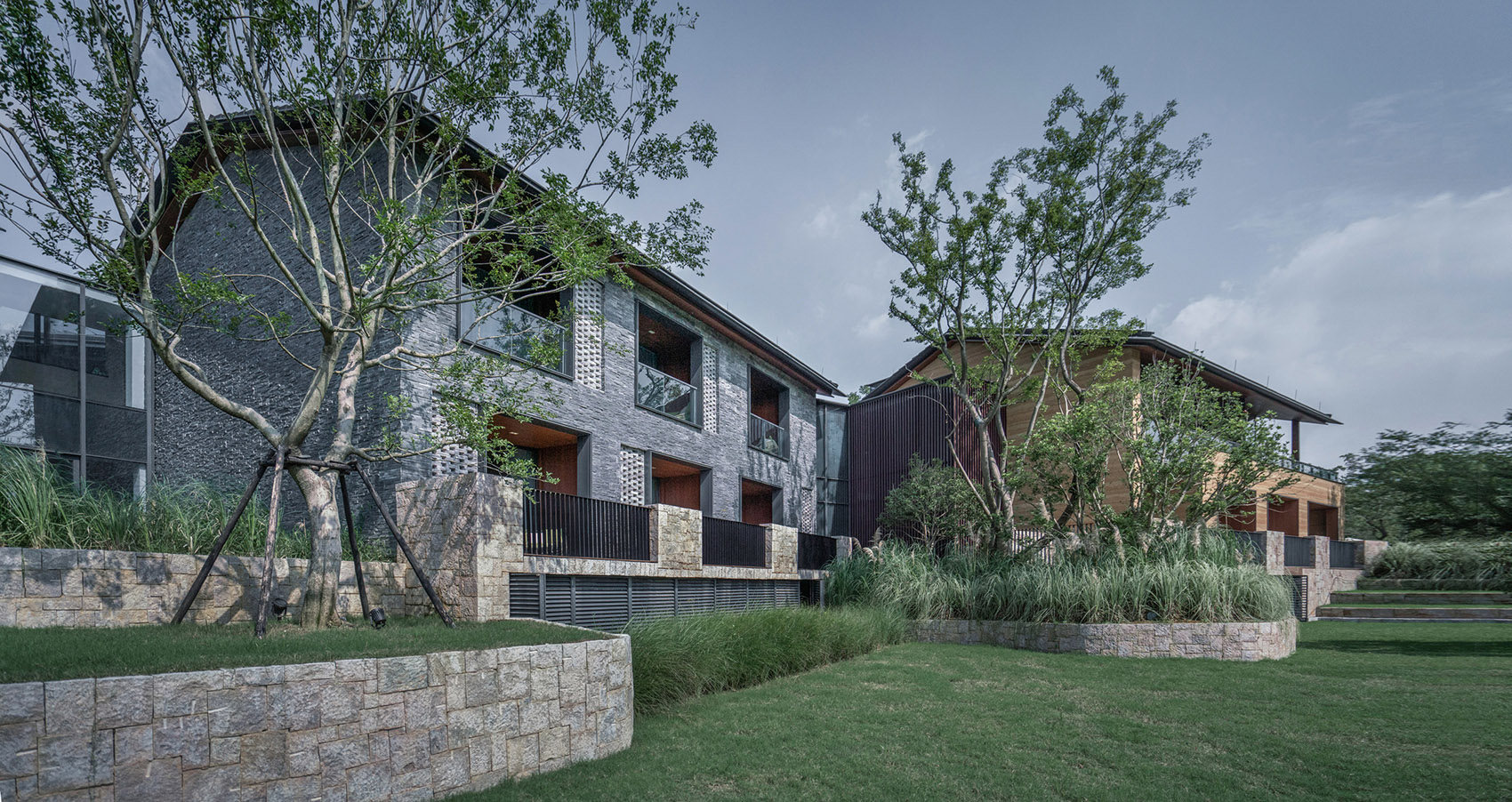
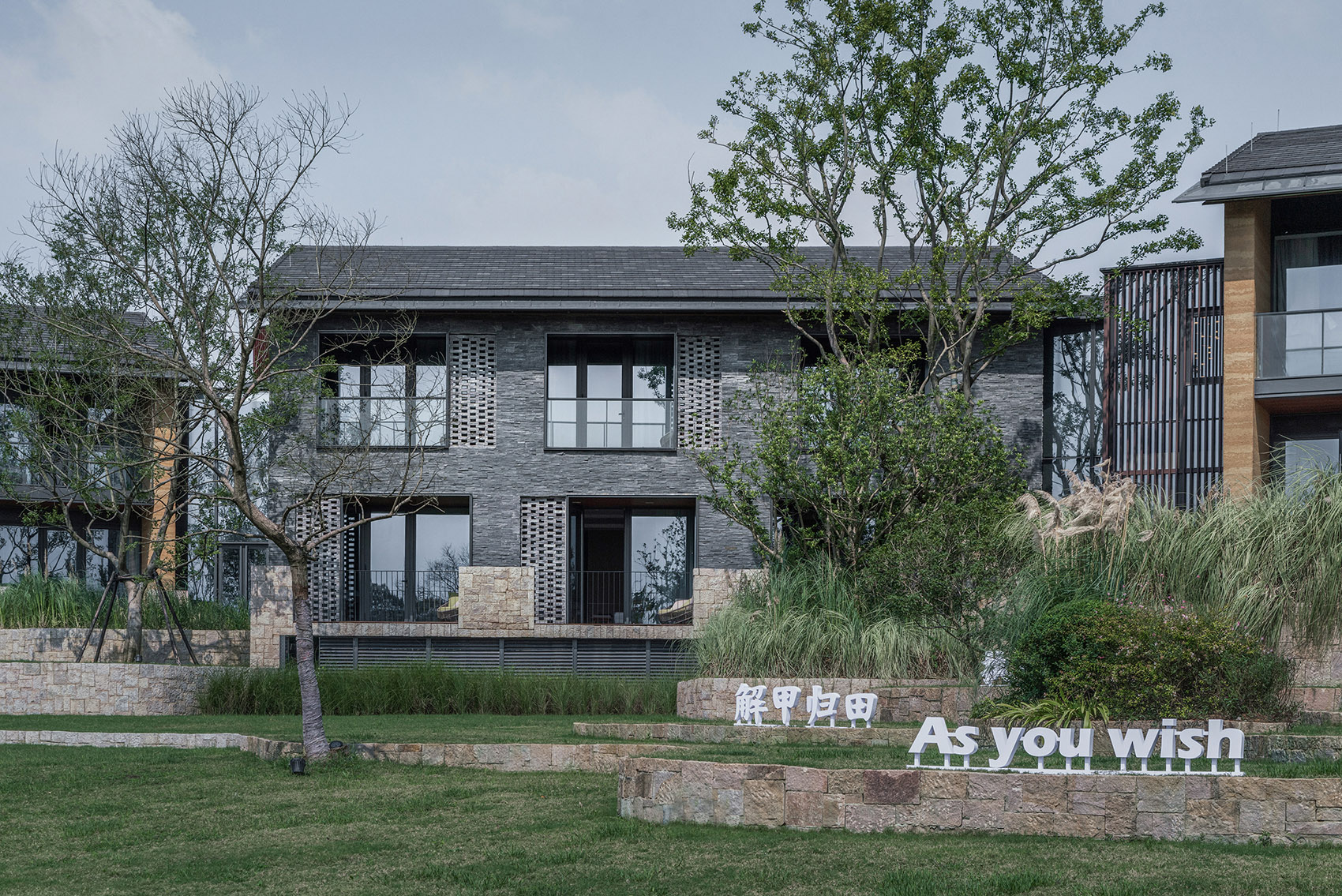
经过大家的充分讨论,业主也认同了我们的观点,同时我们也退让一步,尽可能让每一户朝南的角度更大。为了平衡多方利益需要的是建筑师不断的尝试和实验,兼顾基地、朝向、视线、密度等等。我们以0.1米为单位调整建筑之间的关系,几乎穷尽了设计的可能性,最终所呈现出的“聚落”看似是随机的结果,实则是在三十余次修改后的精密测算。
After the discussion, the owners did agree with us. At the same time, we also make a concession and make each house face south as much as possible. In order to balance the interests of various parties, the architect needs to keep trying and experimenting, taking into account the base, orientation, viewable range, density and so on. The relationship between buildings is adjusted with the unit of 0.1 meter, almost exhausting the design possibilities. The resulting “settlement” appears to be a random result, but is actually a precise calculation after more than 30 revisions.
▼较高处的建筑体块,相互之间互成角度,获得最好的居住质量,buildings on the upper level slightly rotated in different angles, approaching best living quality ©孙磊
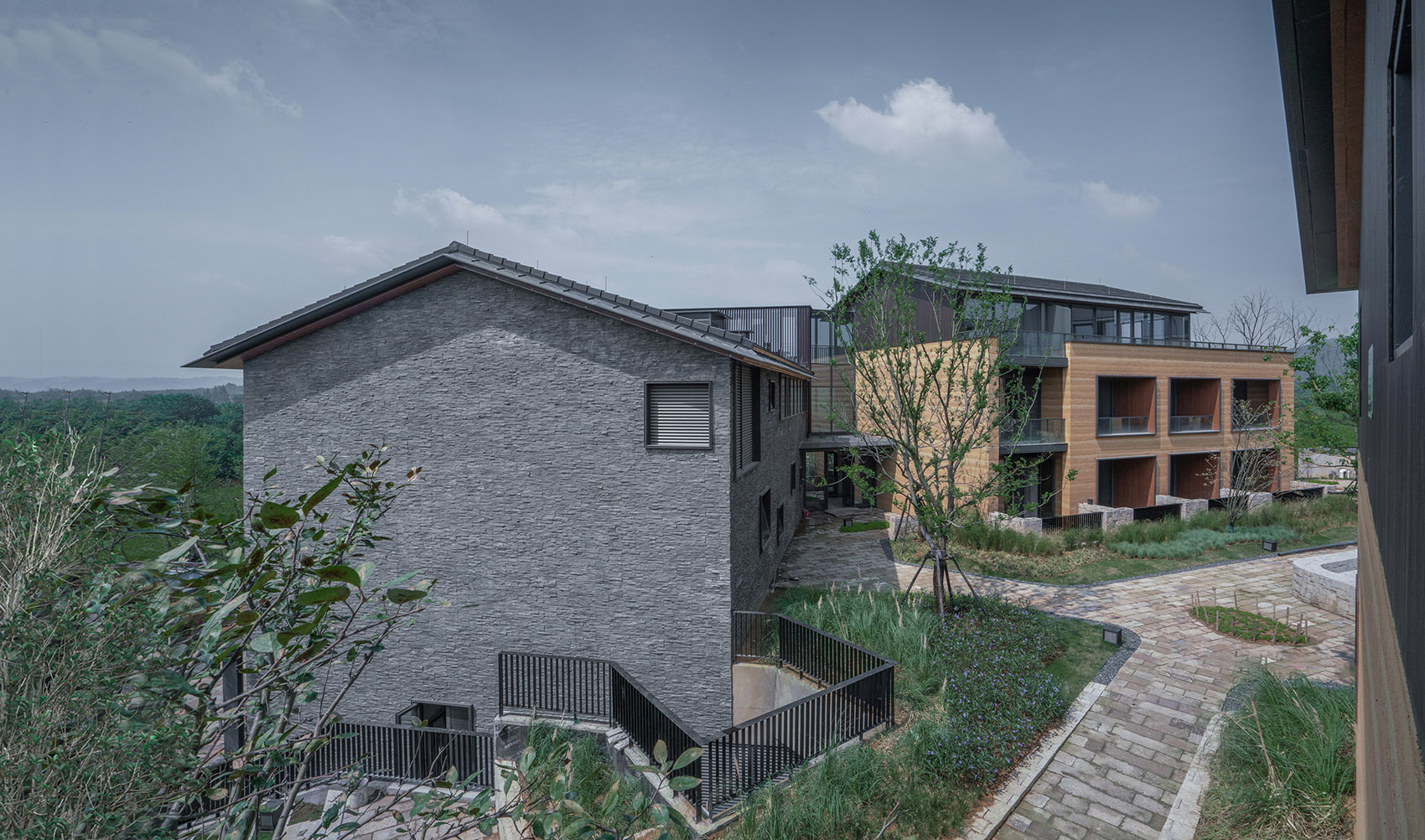
随着中国经济与文化的崛起,大众对于建筑风格的喜好,已由法式、西班牙式、地中海式等西方建筑风格,转向中式风格,中式建筑的意向与中式构件的精致感使其在市场的接受度极高。中式建筑在一众欧美风下重建话语权,也昭示中国民众日益回归和觉醒的文化自信。
With the rise of China’s economy and culture, the public’s preference for architectural styles has shifted from French, Spanish, Mediterranean and other Western architectural styles to Chinese styles. The intention of Chinese architecture and the exquisite sense of Chinese components have made it accepted in the market. The reconstruction of Chinese-style architecture under the European and American winds also shows that the Chinese people are increasingly returning and awakening cultural confidence.
▼建筑外观,external view of the buildings ©孙磊
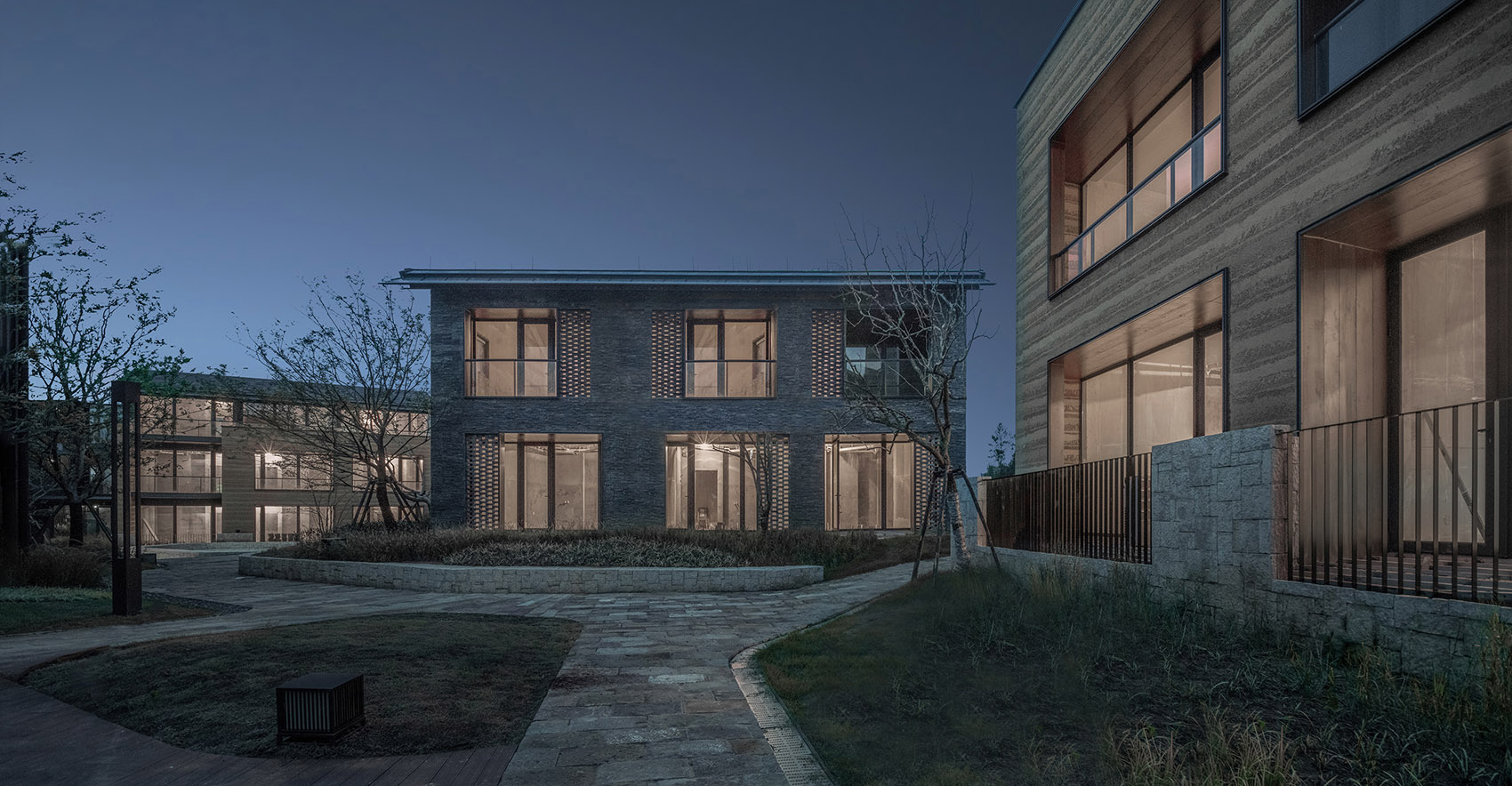
新田园社区中有许多是城市精英对生活本源的回溯和对“诗意的栖居”的向往,我们所认为的“诗意”是不局限于田园风光和传统意蕴,也包括现代居住的审美、舒适度和安全感。因此,在单体层面,我们不希望以风格层面的复古怀旧为主导,尝试由当代的和在地的建筑材料、建造手段、建筑细节相结合的手法来转译传统聚落,以此回应当下的诗意性栖居。
Urban elites’ recollection of the origin of life and their yearning for “poetic dwelling” are included in the new rural community. In our opinion, the “poetry” is not limited to the idyllic scenery and traditional connotations, but also includes the aesthetics, comfort and security of modern living. Therefore, we do not hope to focus on the retro nostalgia at the style level. Instead, we try to translate the traditional settlement by combining the contemporary and local building materials, construction methods and architectural details, so as to respond to the current poetic dwelling.
▼建筑使用不同的材料与建造手段,buildings using different materials and construction methods ©孙磊
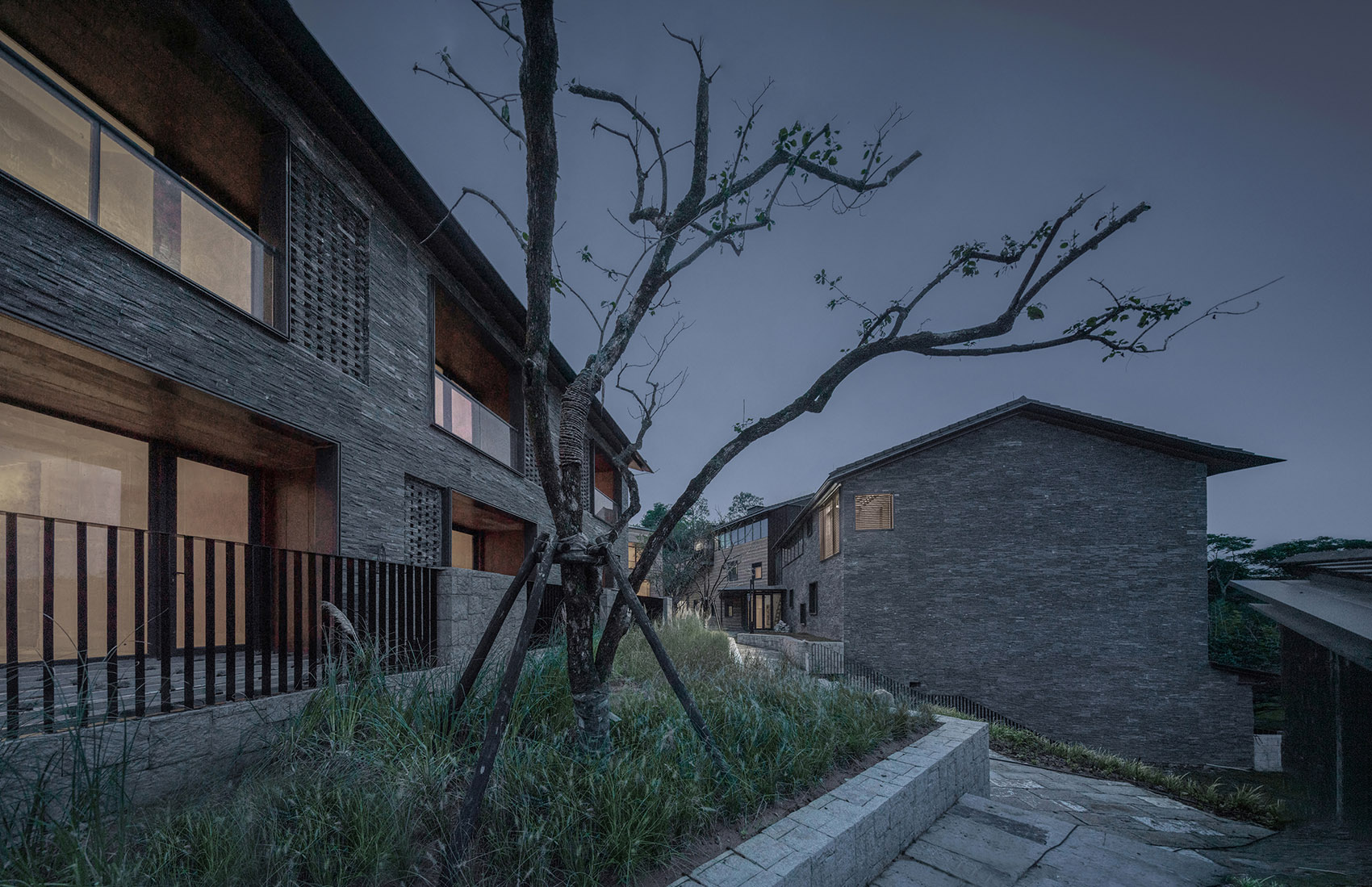
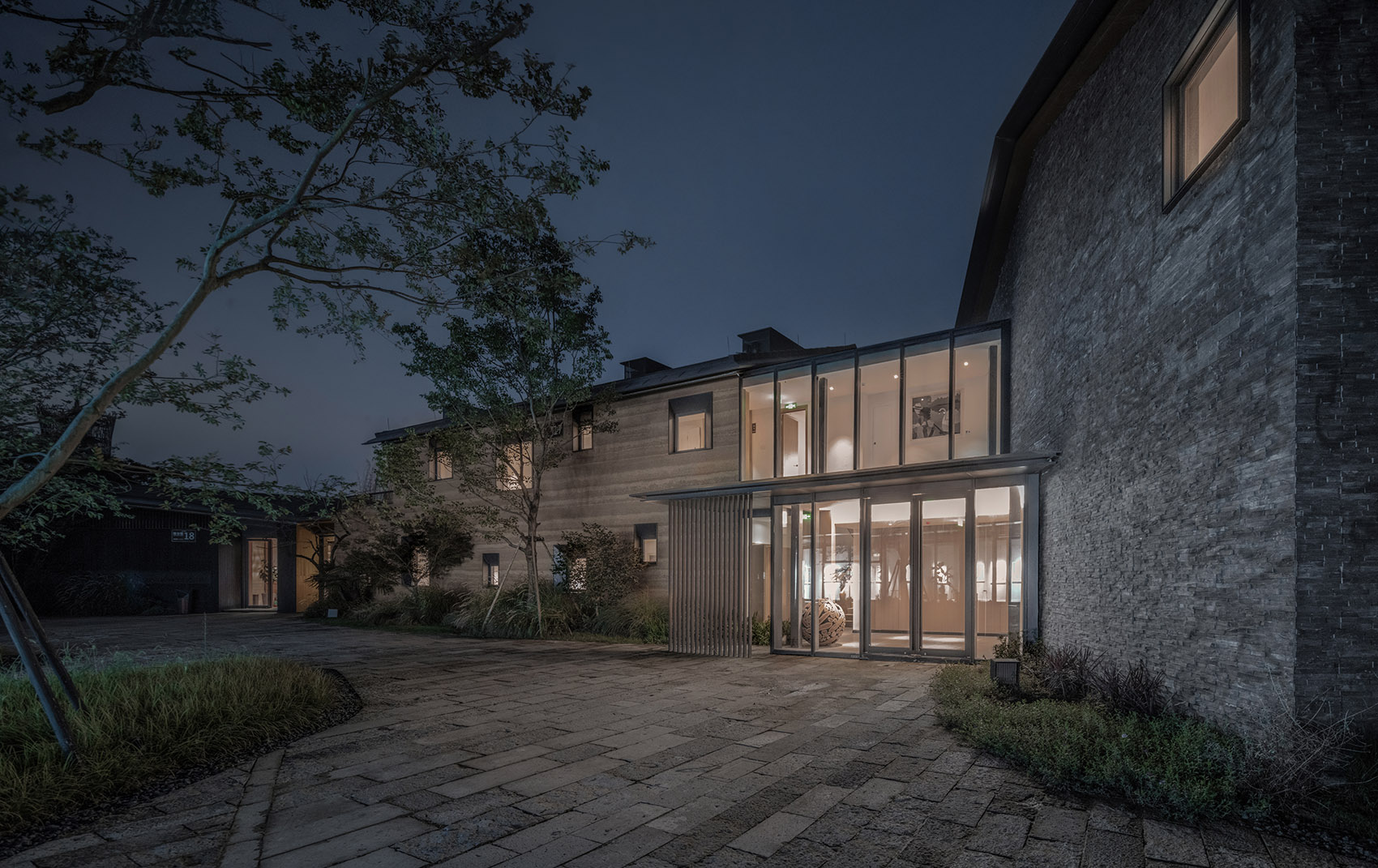
建筑单体均为坡屋顶覆盖的长方体体量,屋顶采用传统双坡屋顶的直线形制,而非传统中式的曲线屋顶。屋顶形式共分两种,对坡屋顶与对角折面屋顶,分别对应客房与公共空间两种不同功能,丰富聚落内的建筑形体。
The individual building is a rectangular volume covered by a pitched roof. The roof adopts the linear shape of a traditional double pitch roof instead of a traditional Chinese curved roof. There are two types of roofs, the double pitch roof and the diagonally folded roof, which correspond to two different functions of guest rooms and public spaces, enriching the architectural form in the settlement.
▼双坡直线坡屋顶,double pitch roof ©孙磊

为了加强单体的市场销售竞争力,设计还考虑如何减少公摊面积、增加使用面积。在经过多方案比较后,最终确定了两幢公用三楼梯的方式,同时在中间段增设门厅公共空间。独立竖向交通体系更有利于建筑形体塑造,连廊也实现了公共与私密的连接。
In order to strengthen the marketability of the individual building, we also consider how to reduce the shared area and increase the usable area. After comparing multiple schemes, the scheme of two public buildings with three staircases was finally determined, and the public space of the foyer was added in the middle section. The independent vertical transportation system is more conducive to the shape of the building, and the corridor can also realize the connection between public and private.
▼两栋建筑之间设置公共门厅,public porch shared by two buildings ©孙磊
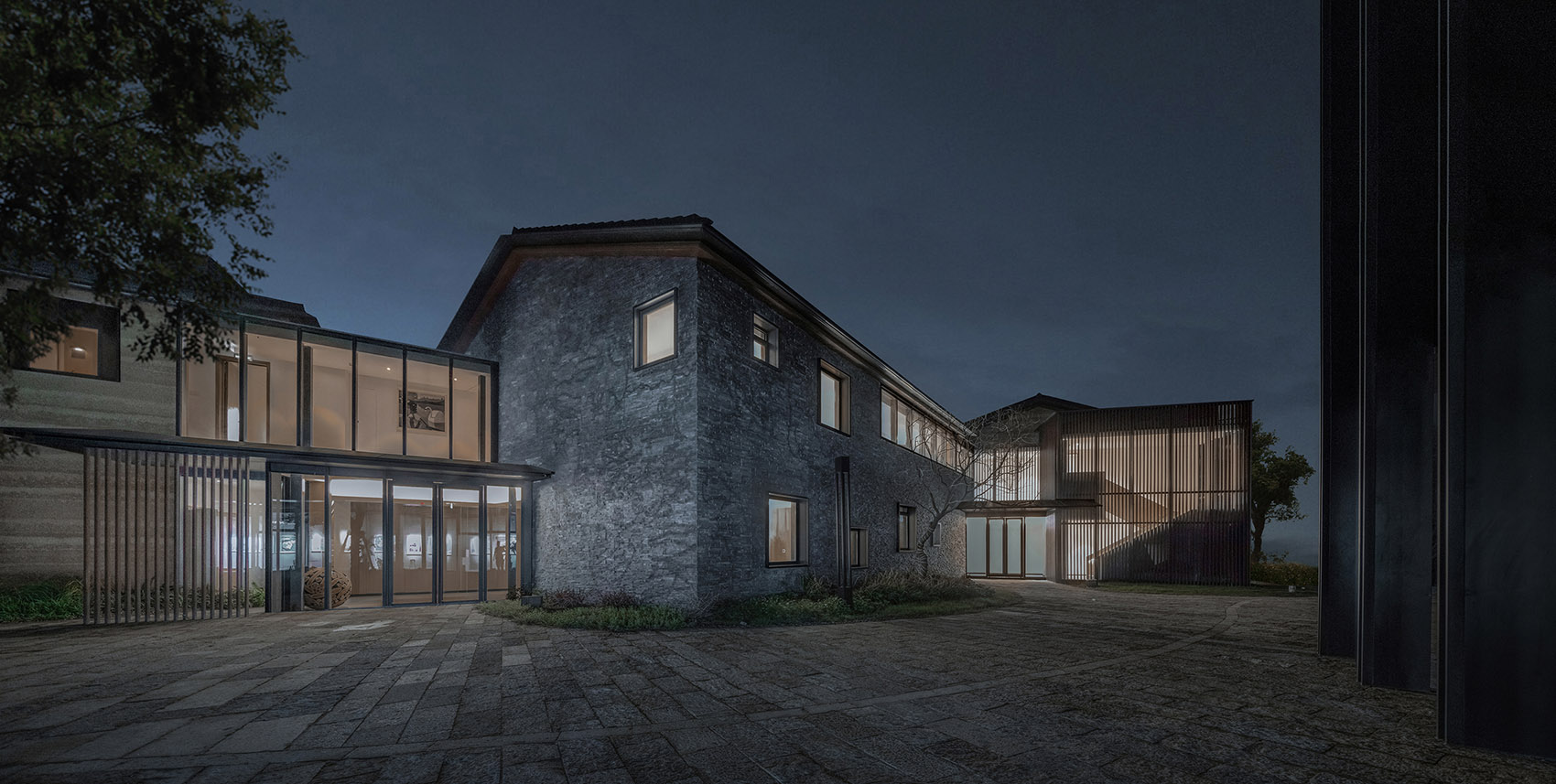
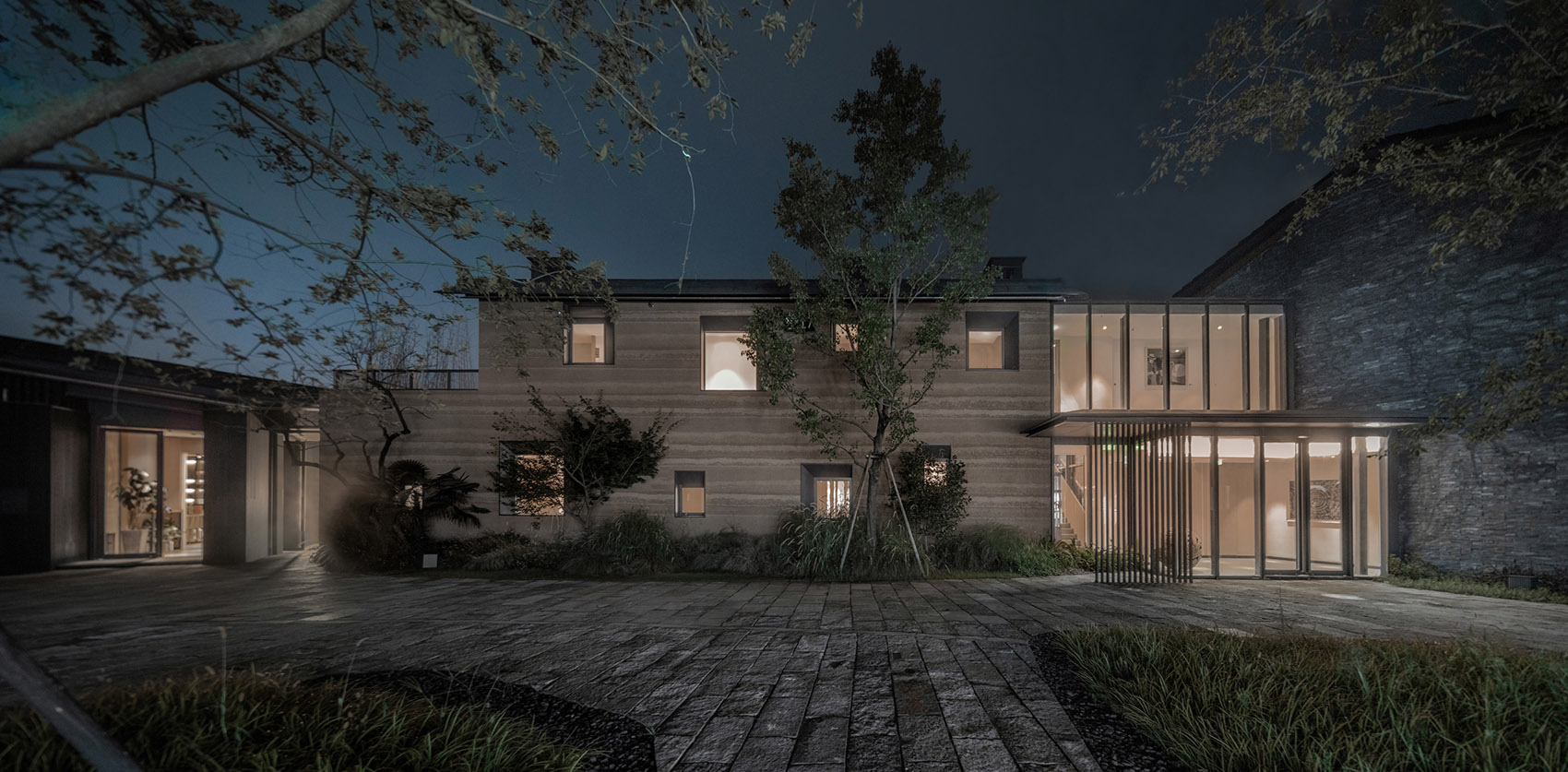
针对各个建筑节点的构成部分,我们做了详细的研究,想要强调建筑的生长感和在地性。屋面平铺平板水泥瓦,与檐口的交接处采用标准化截面的铝板折边收口,一定程度上缓和混凝土屋面的厚重感,提升设计的精致感,也减少各种瓦屋面的装饰配件,降低成本。
We made a detailed study of each building component to emphasize the sense of growth and locality of the new building. The roof is paved with plane cement tiles, and the junction with the cornice adopts the standardized cross-section aluminum plate folding and closing, which to a certain extent alleviates the heavy feeling of the concrete roof, enhances the delicate sense of design, and also reduces the decorative accessories of various tile roofs, thus reducing the cost.
▼墙身剖面,wall detail ©gad · line+ studio
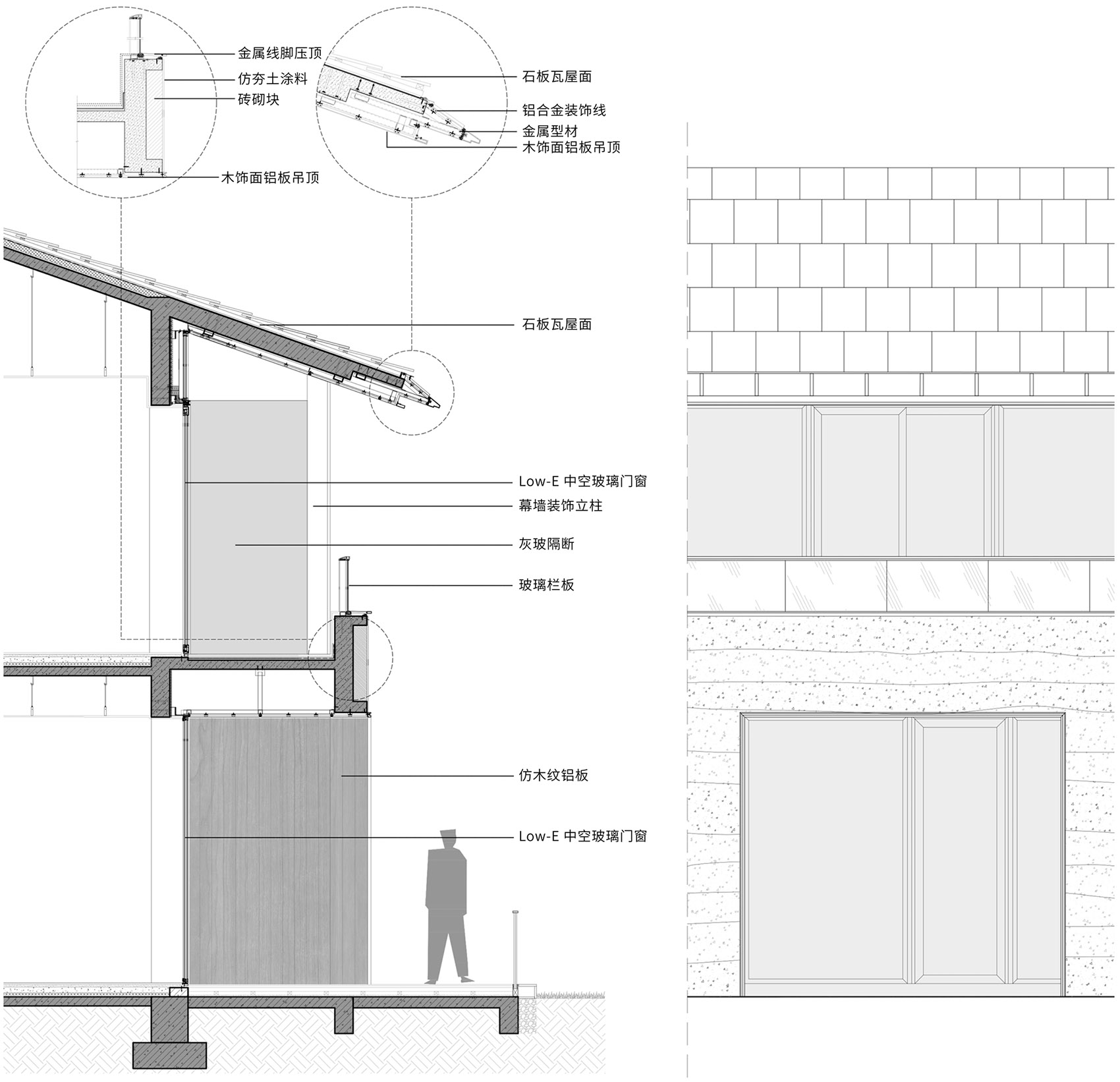
▼墙面细部,details of the wall ©孙磊

墙面材料主要选择自然本土化的材料,以夯土、条石与竹材墙板为主,这三种材料的质感也最常见于传统聚落建筑中。
夯土——在设计中我们先后尝试了原始夯土、夯土挂板、夯土涂料三种做法,结合成本控制及施工条件,最终采用了夯土涂料。构造上,我们在墙体保温外侧增设了一道120厚的墙体作为夯土涂料的基层,既能解决外保温外侧的施工难题,同时增加了窗洞的深度,还原夯土墙的厚重感。
The wall materials are mainly natural and localized, including rammed earth, strip stone and bamboo-wood wall panels, which are also the most commonly used basic elements in traditional architecture.
Rammed earth-In the design, we tried three ways of original rammed earth, rammed earth hanging board, and rammed earth coating. Based on cost control and construction conditions, we finally adopted rammed earth coating. In terms of structure, we added a 120mm wall on the outside of the wall insulation as the base layer of the rammed earth coating, which not only solves the construction problems on the outside of the external insulation, but also increases the depth of the window holes and restores the heavy sense of the rammed earth wall.
▼夯土墙图纸控制,drawing of rammed earth ©gad · line+ studio
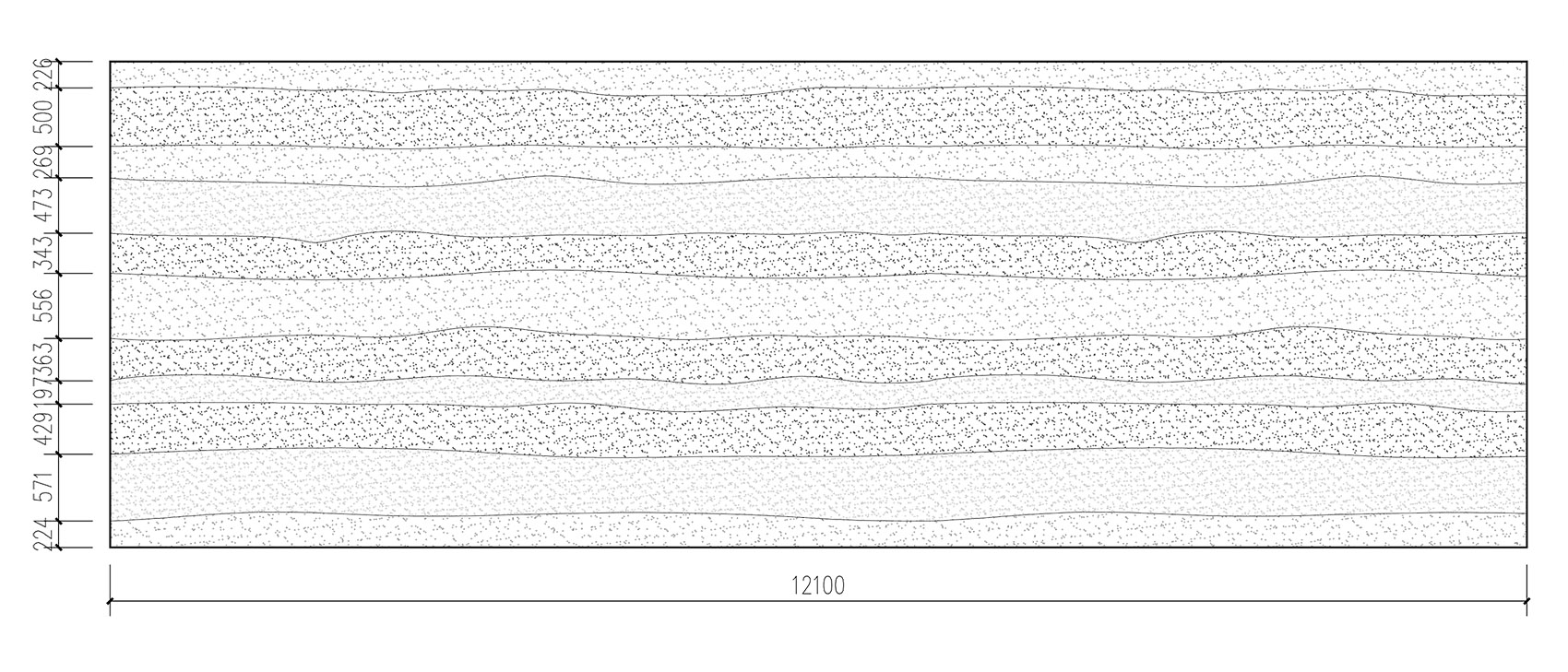
在现场实施过程中,夯土的自然肌理感成为操作难点。为此我们提供了图纸用于控制尺寸,现场依据设计图纸用不同颜色层次的仿夯土涂料上墙,再根据墙体效果调整细节尺度,前后反复二十余次,直至呈现出真实生态的夯土纹理。
In the construction process, the natural texture of rammed earth is difficult to handle. For this reason, we provided the detail drawing. According to the design drawing, different color levels of imitation rammed earth were coated on the wall, and then adjusted the detail scale according to the real wall effect. More than 20 times were repeated, until the real ecological rammed earth texture was presented.
▼夯土建筑,rammed earth building ©孙磊
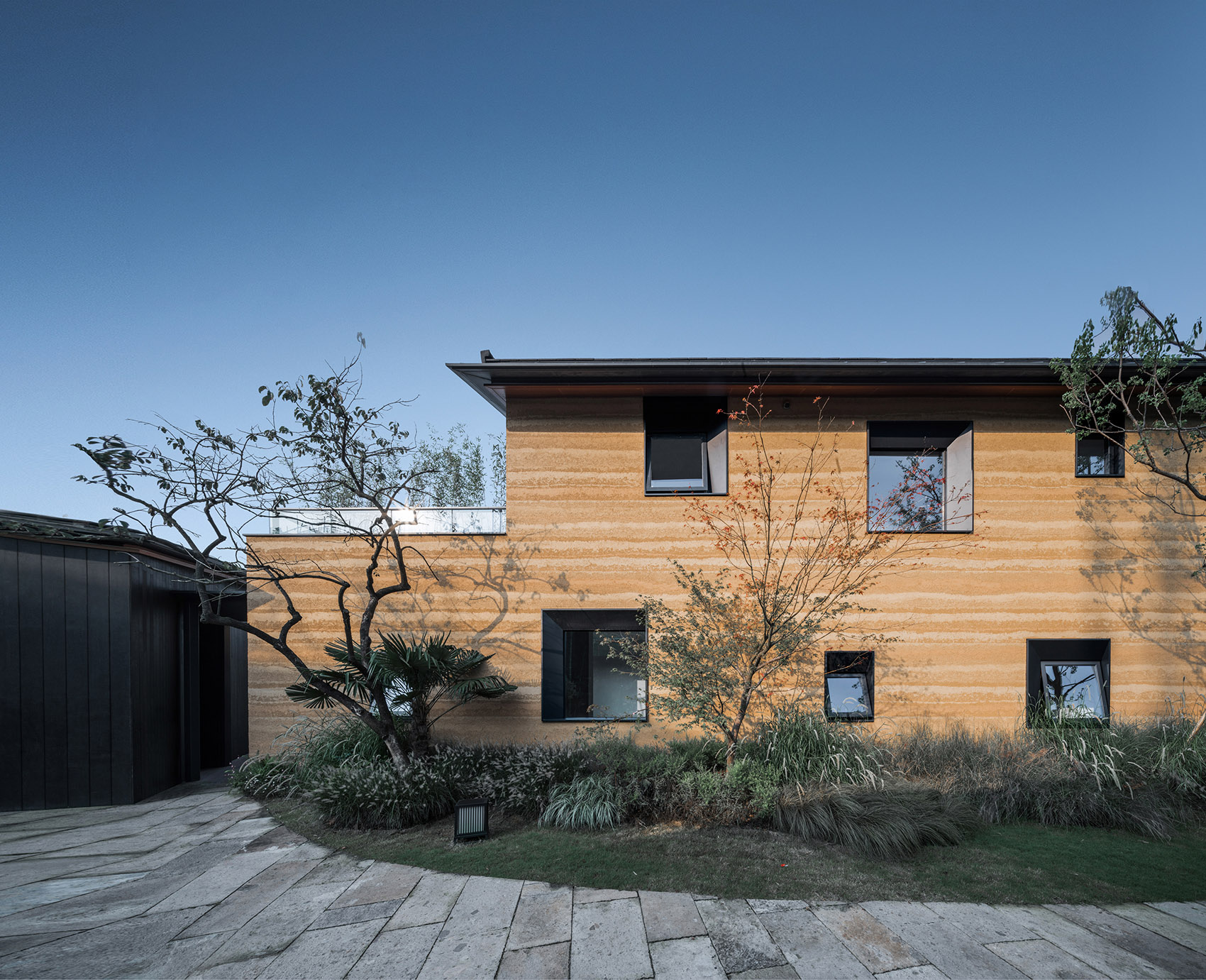
▼夯土墙细部,details of the rammed earth wall ©简直建筑-空间摄影
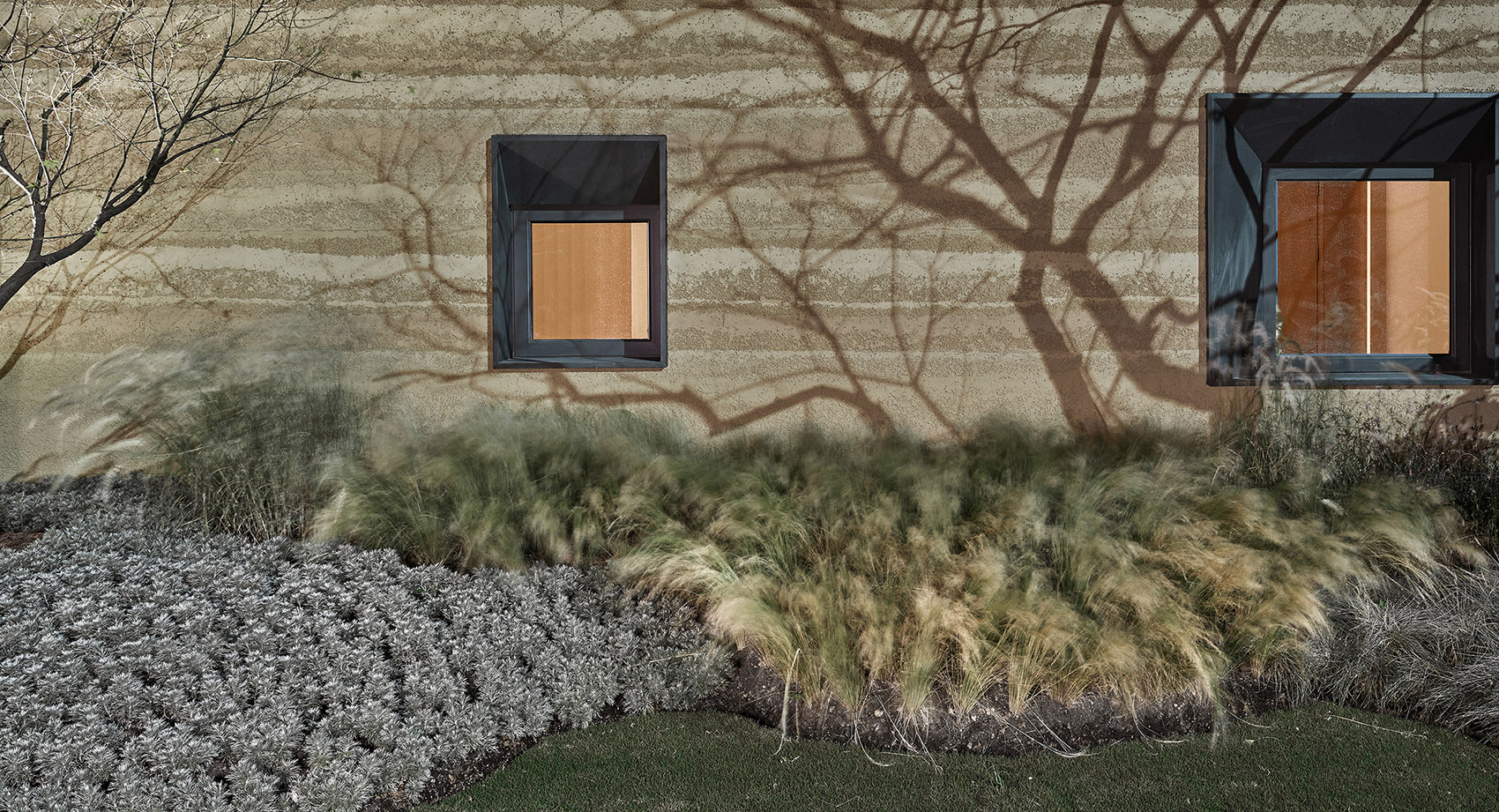
石——以片岩挂板的形式表现,同样在建筑的正面和北面的防水保温层外侧增设120厚的装饰墙体,最后以“湿贴”的方式来解决外保温层外贴石片的牢固性问题。
Stone-In the form of schist hanging boards, a 120mm decorative wall is also added to the outside of the waterproof insulation layer on the front and north of the building, and finally a “wet sticking” method is used to solve the firmness problem of the strip stone outside the external insulation layer.
▼石材建筑,stone buildings ©孙磊
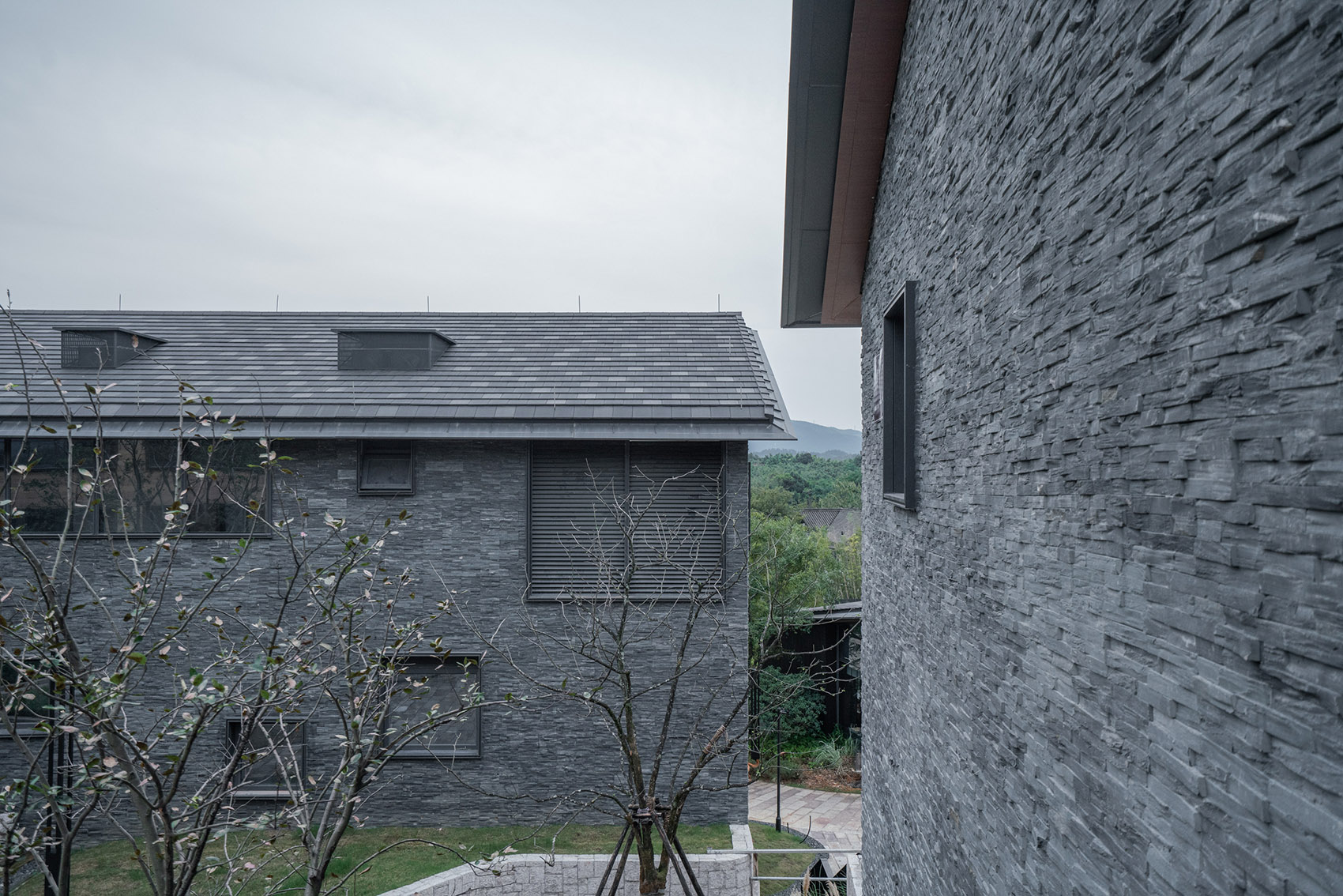
▼石墙细部,details of the stone wall ©孙磊
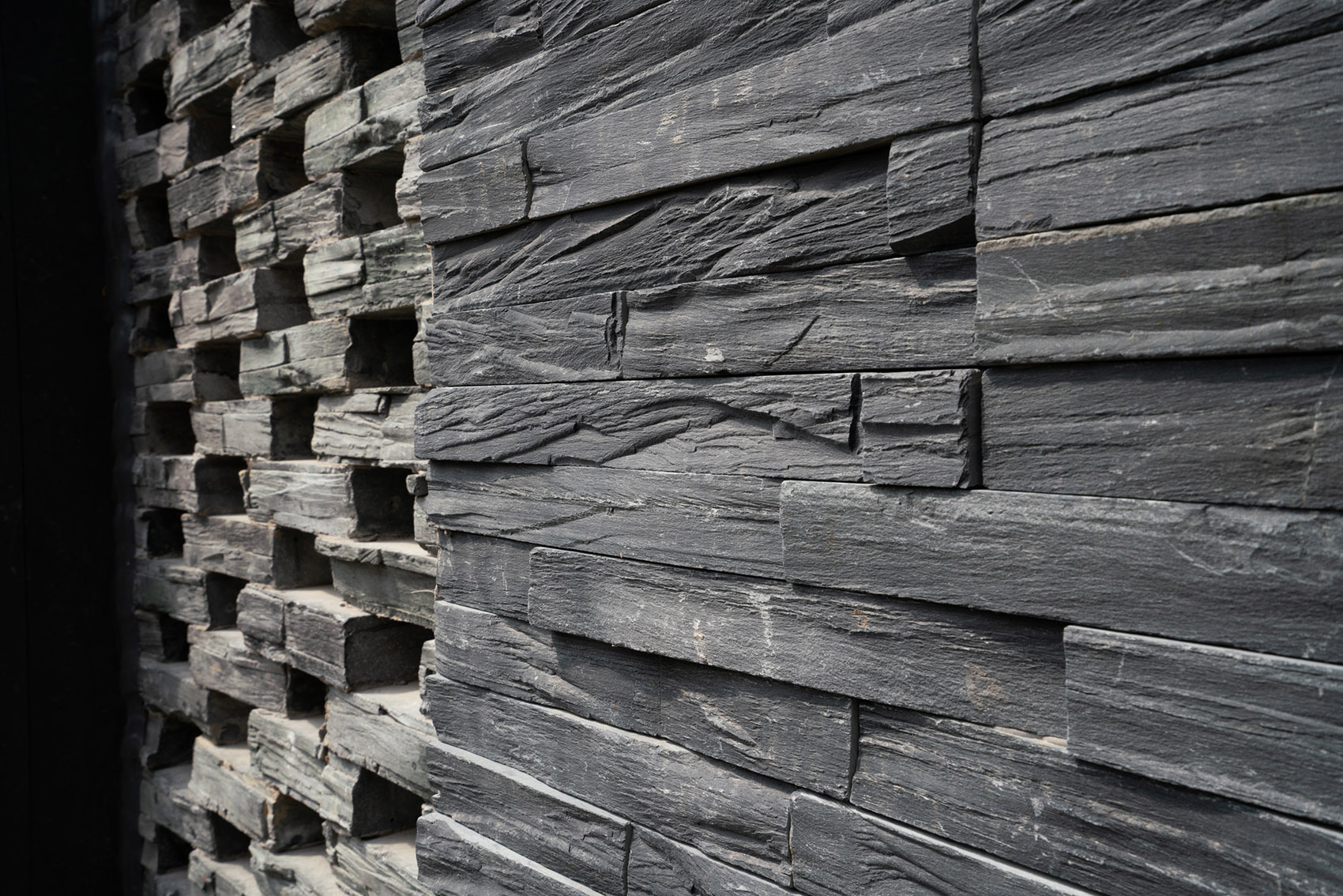
在设计上希望以小洞口、实面墙为主的“石屋”在表现整体体量感,但实面过多会使得内部空间相对压抑,为此,我们在两者之间置入了一层半透的镂空墙,既能引入更多的自然光,也丰富了立面的趣味性。
In the design, it is hoped that the “stone house” with small openings and solid walls will express the overall sense of volume, but the solid walls will result in that the internal space looks relatively oppressive. For this reason, we put a semi-transparent hollow wall between them, which not only brings in more natural light, but also enriches the interest of the facade.
▼镂空墙面减少空间的压抑感,hollow wall reducing the feeling of repression in the space ©孙磊
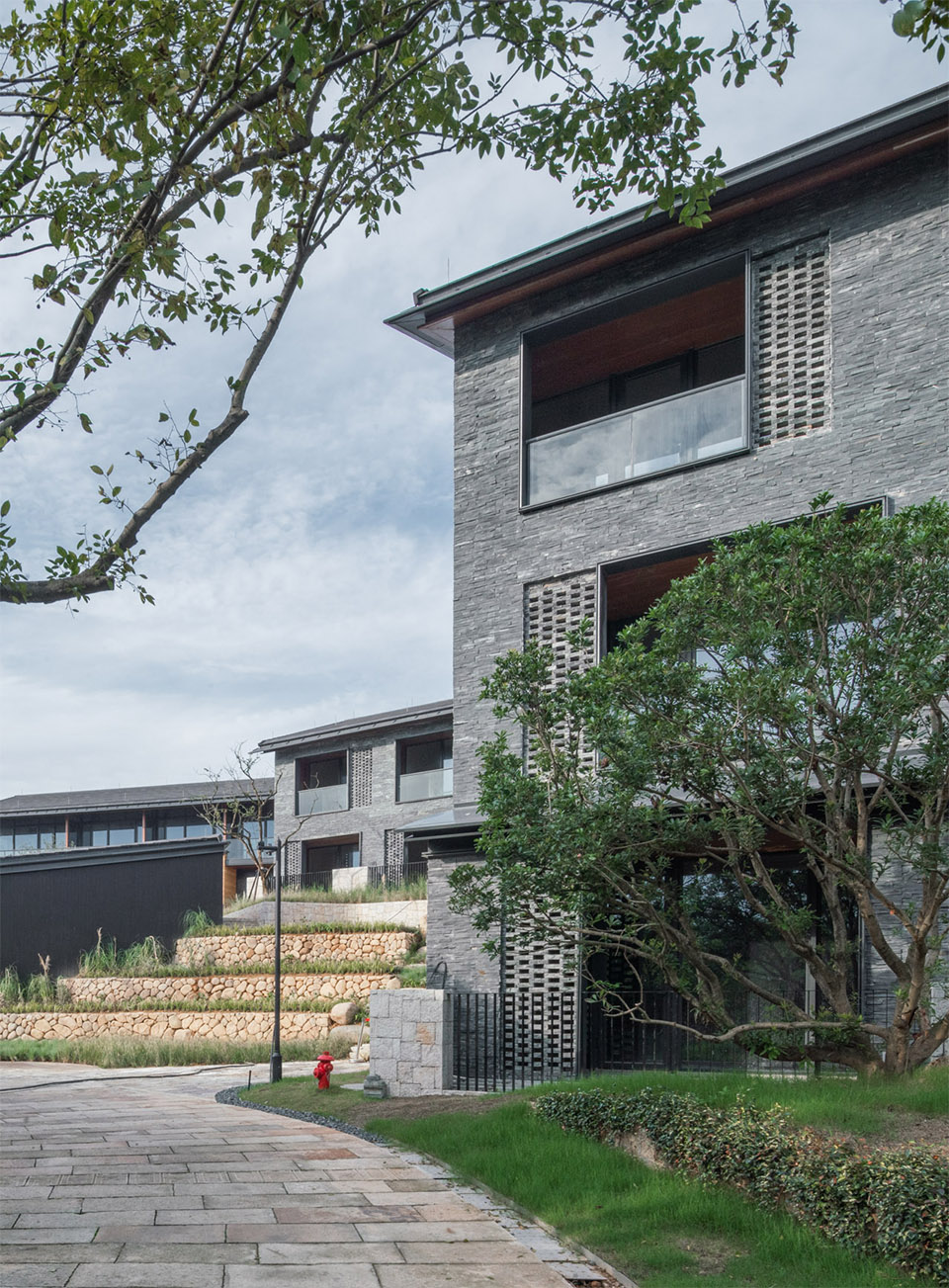
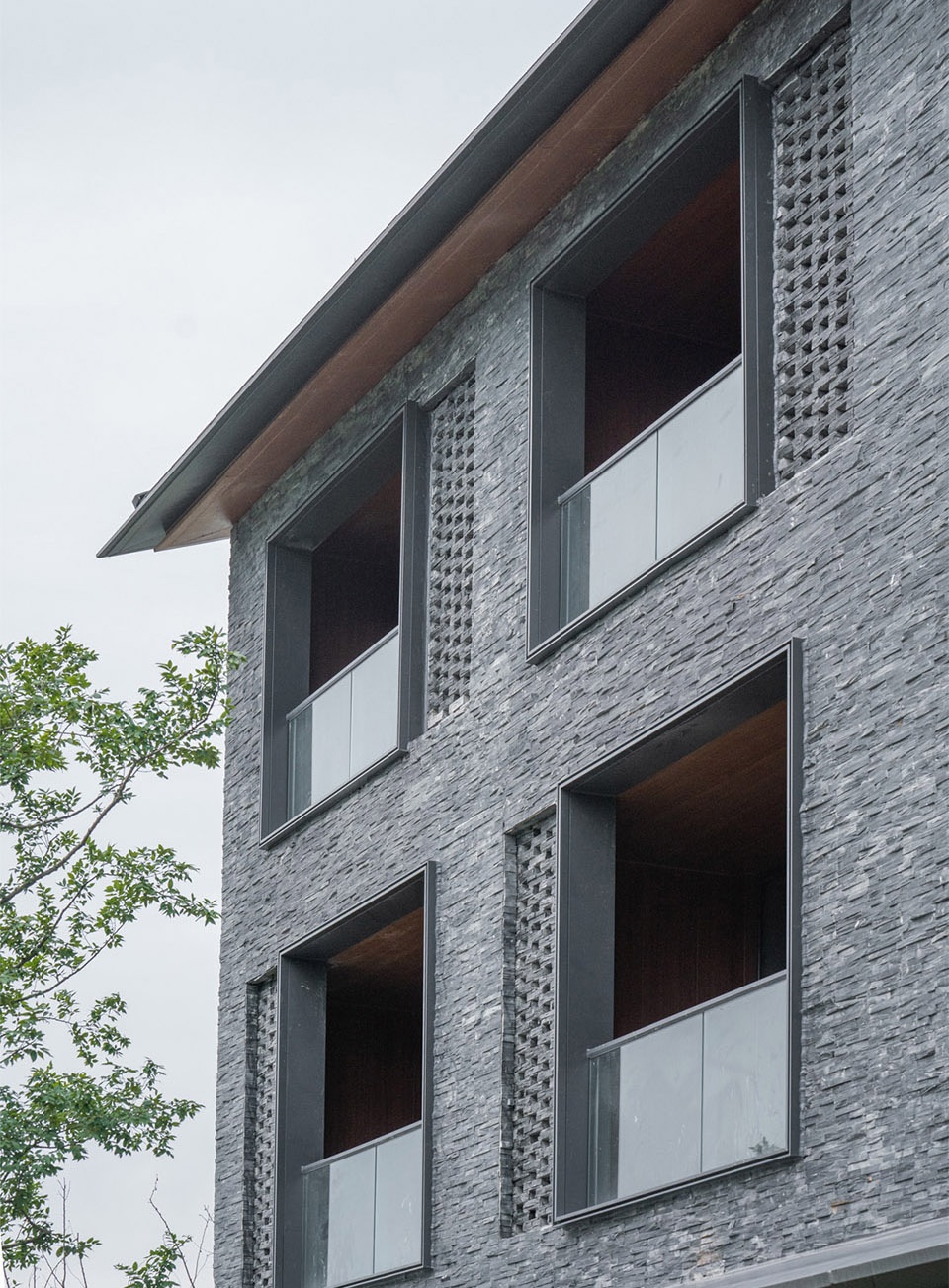
竹材——为了与“夯土”、“石屋”区别开,书吧等公共建筑主体采用黑色竹木板材。相较于常见的竹木原色板材,黑色竹木板材能够有效减少建筑在环境中的个性表达,更能融入周边的环境,也更适合野性的自然环境。工业化的黑色竹木墙板采用龙骨干挂于外墙表面,在建筑形式上表达公共空间的功能属性。
Bamboo wood boards – Different from the “rammed earth”, “stone house”, the main body of public buildings such as the book bar is made of black bamboo and wood boards. Compared with the common bamboo-wood boards of primary color, black bamboo-wood boards can effectively reduce the individual expression of the building in the environment, can be better fused into the surrounding environment, and are more suitable for the wild natural environment. Industrialized black bamboo-wood wall boards are dry hung on the exterior wall surface with keel, expressing the functional attributes of public spaces in architectural form.
▼黑色竹木书吧,book bar made of black bamboo ©孙磊
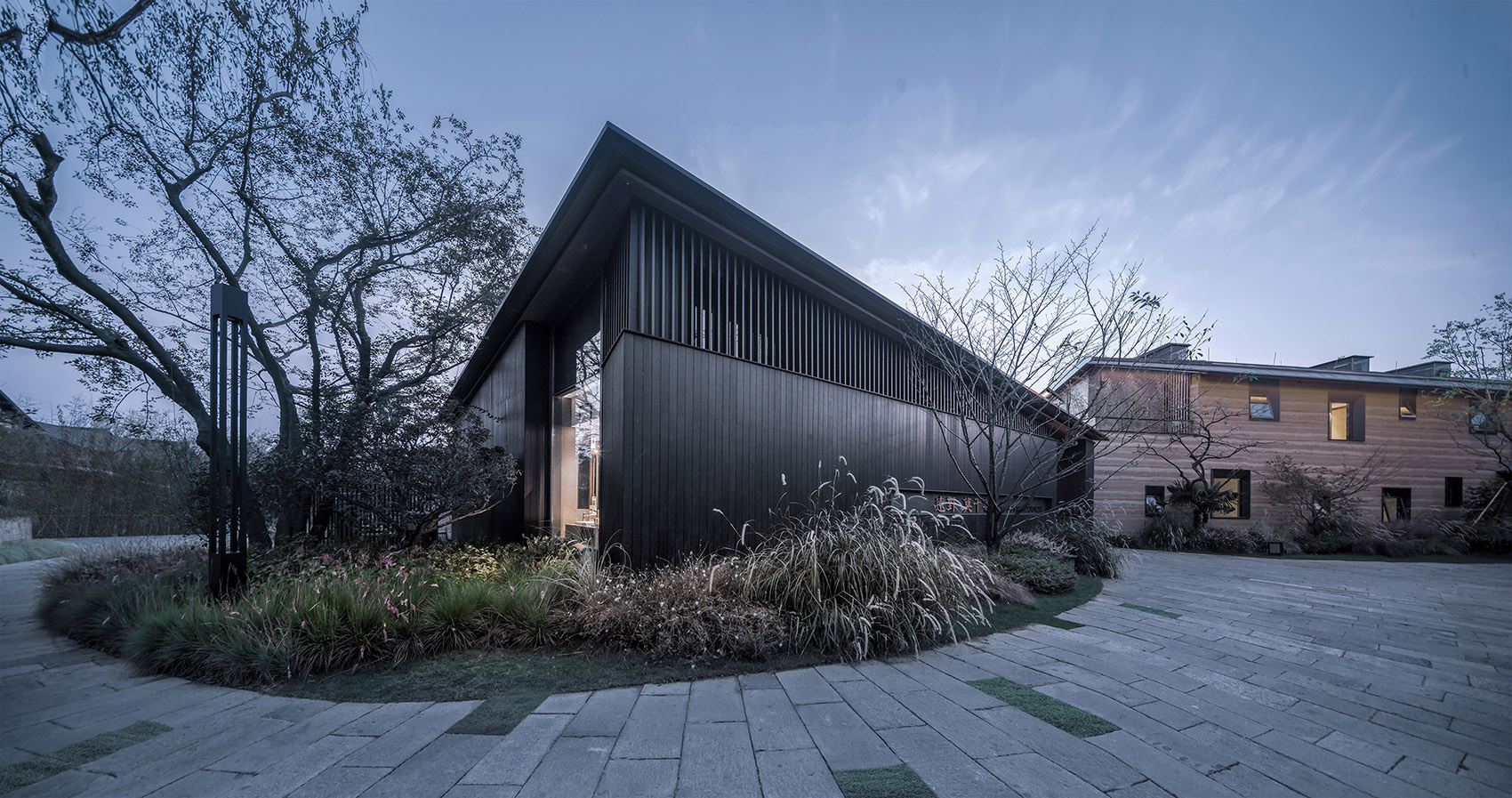
在以家庭为单位的生活方式主导下,我们对室内的空间布局尽可能做到稳定且多变,来满足各个家庭的不同需求。公共空间(客厅、活动空间)推向阳台,扩大活动范围,可以和室外田园直接互动;起居等私密空间则后移至稳定区域,通过置入格栅与卫生间形成可分可合的两个部分,彼此独立、互不干扰。
Guided by the family-oriented lifestyle, we try our best to make the layout of the interior space stable and changeable to meet different needs of each family. The public space (parlor, activity space) is pushed to the balcony to expand the scope of activities, allowing to directly interact with the outdoor garden; the private space such as the living room is moved to the stable area, and forms two parts that can be divided and combined with the bathroom by placing a grille, so that they are independent of each other.
▼公共空间和走廊,public space and corridor ©ingallery
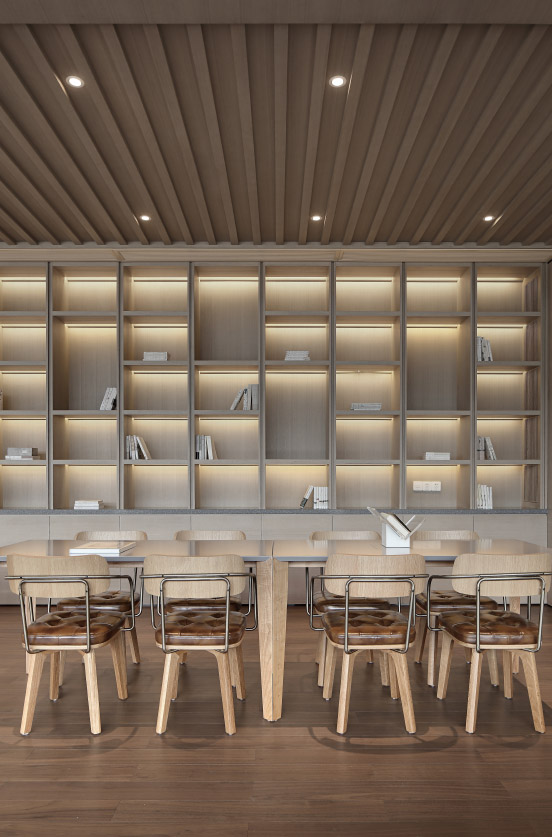
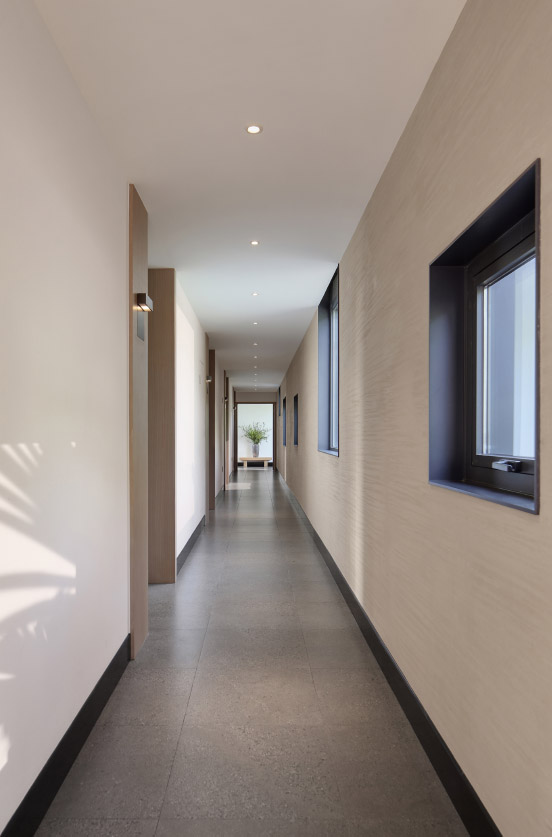
同时,室内设计也可以理解为建筑的内部衍生。室外墙体的夯土材料肌理向内延伸部分,经过漆面处理的硅藻泥涂料运用在内部立面装饰上,并结合木饰面、水磨石砖和暖白色肌理漆,顶面涂饰白色乳漆胶,木色的家具体系,整体呈现质朴而精致的居住环境,也表现出与城市居所不同的特殊韵味。
At the same time, interior design can also be understood as the internal derivation of the building. The rammed earth material texture of the outdoor wall extends inward, and the diatom mud coating with surface paint treatment is applied to the interior facade decoration. Combined with wood veneer, terrazzo tiles and warm white texture paint, the ceiling painted with white emulsion paint, the furniture system of wood color, it presents a simple and exquisite living environment as a whole, and also shows a special charm different from urban residences.
▼客房,guest rooom ©ingallery
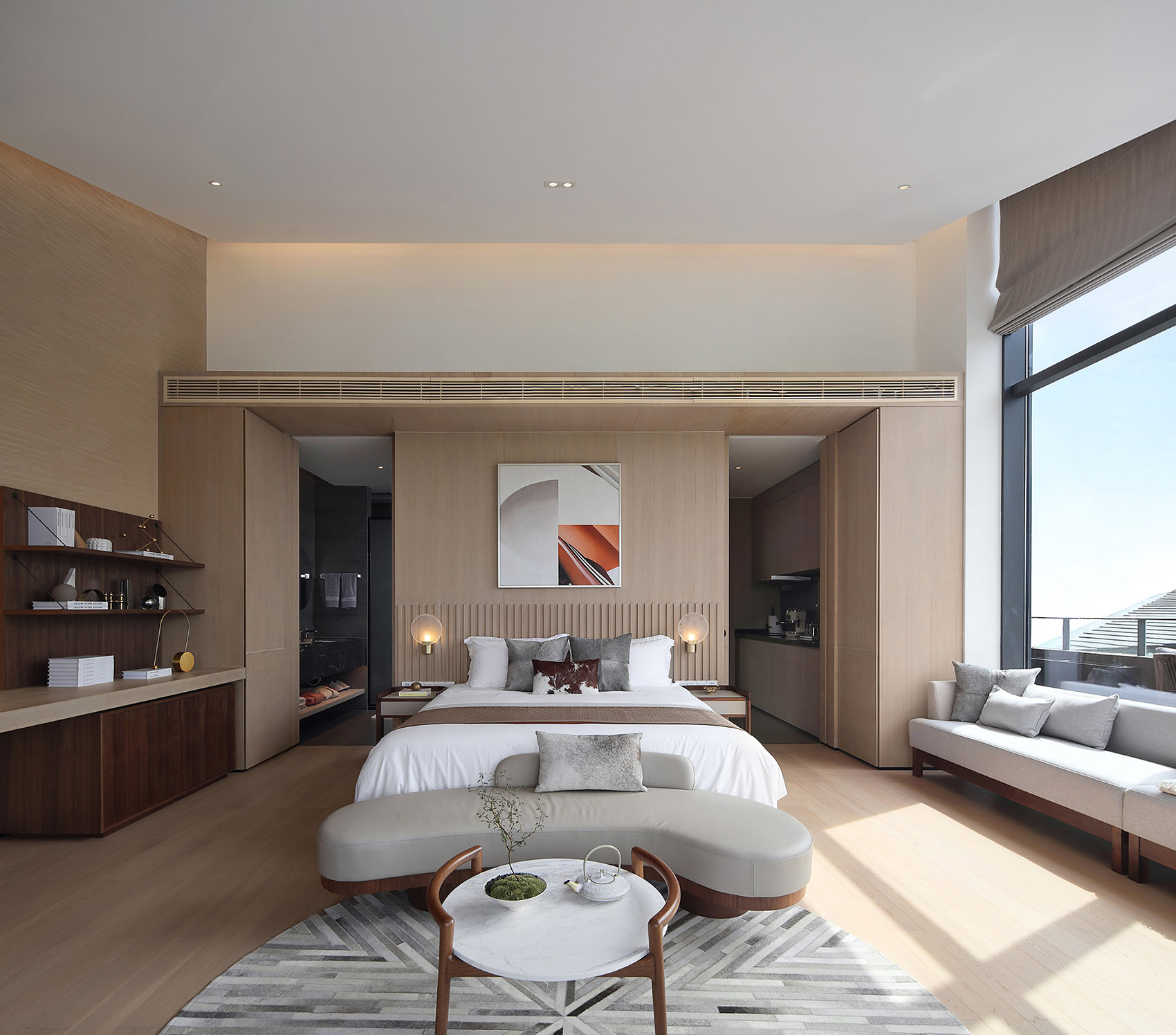
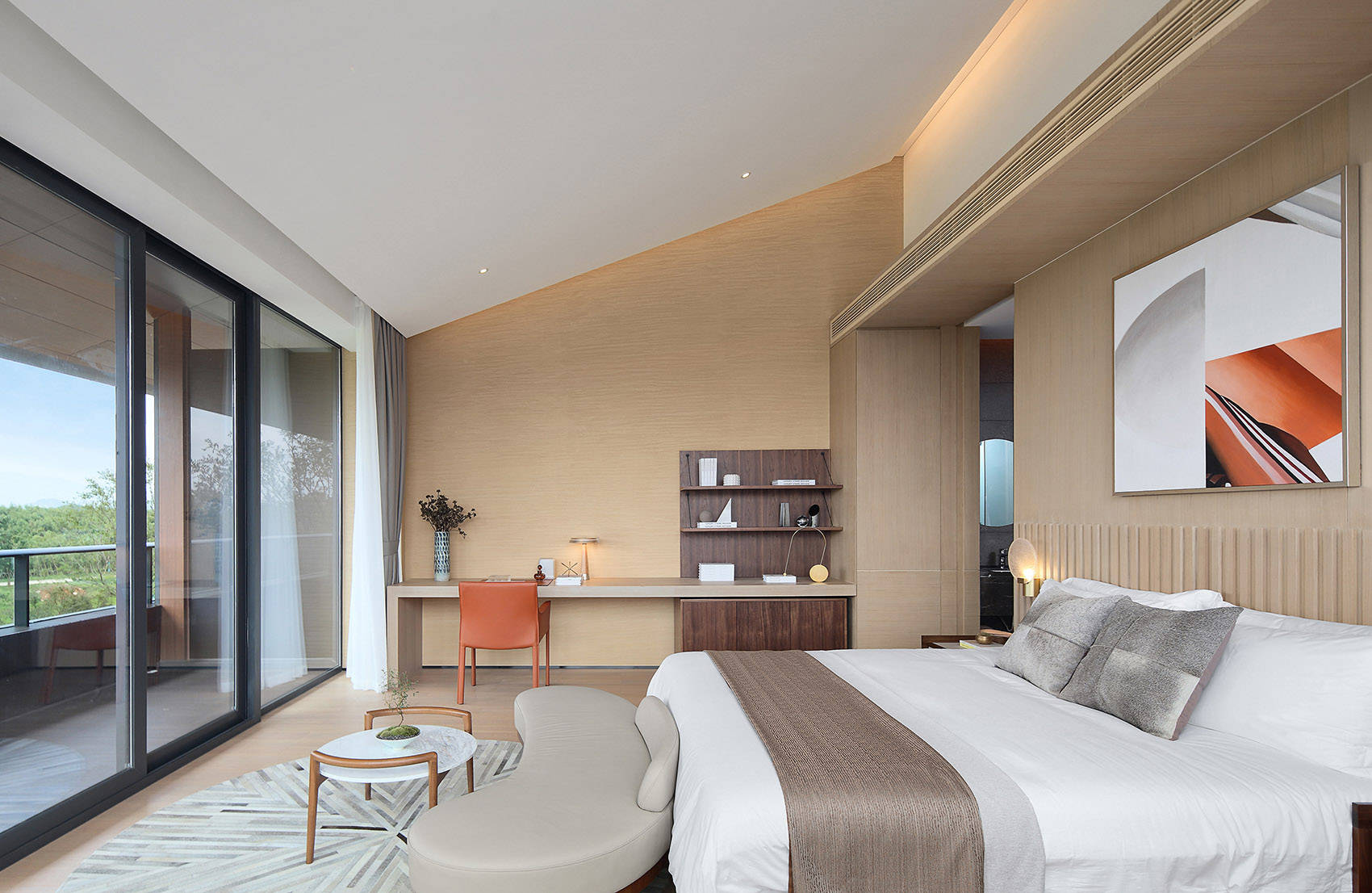
▼夯土材料延伸到室内,rammed earth material extending into the interior space ©ingallery
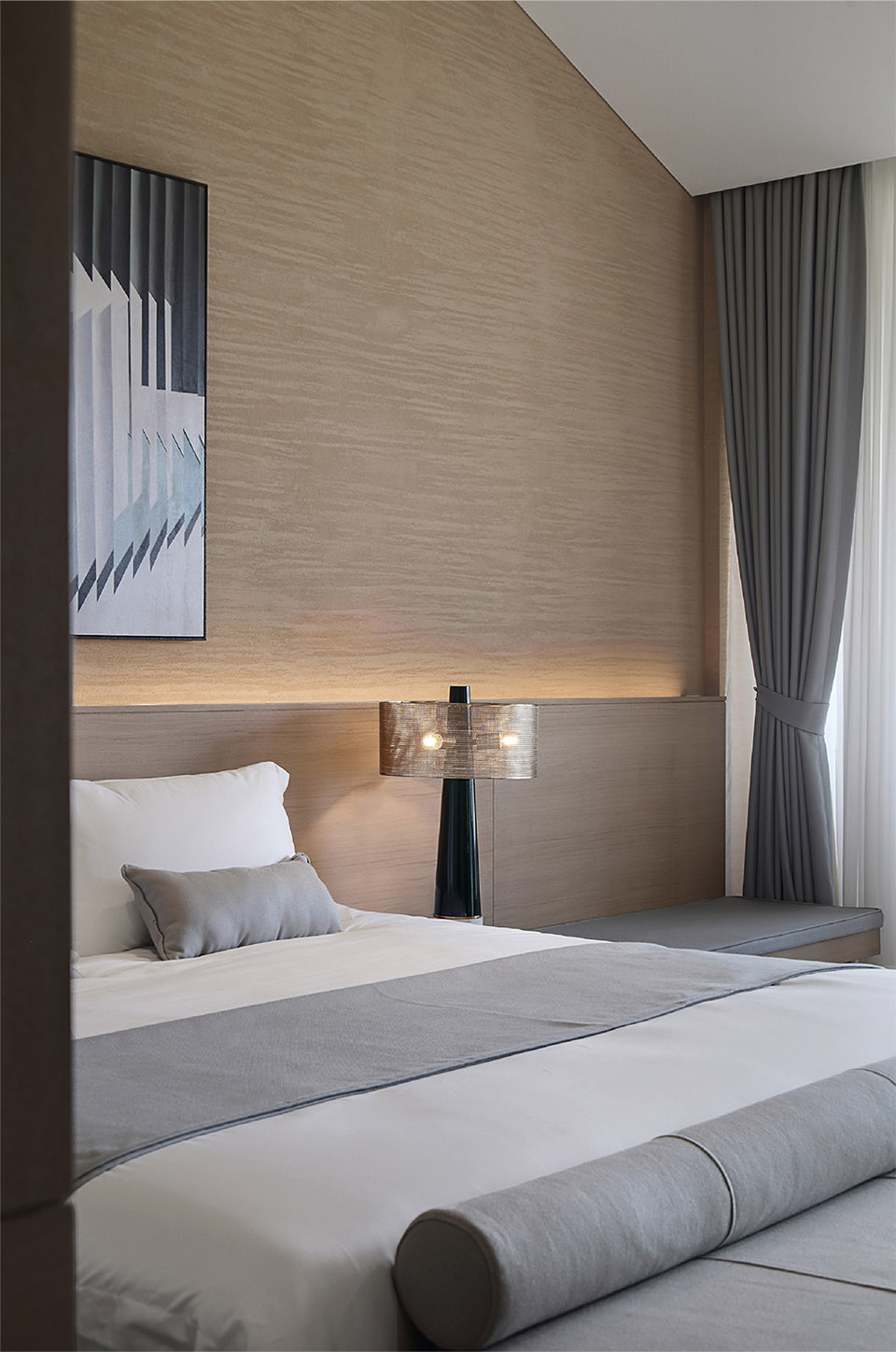

大面积的开窗使得通透的室内界面与室外田园风光构成空间的连贯性、层次感和伸手可触的尺度感。室内设计与建筑设计共同利用原始地形、环境、光线和景观,将田园生活方式融入生活的点滴细节中。
Large-area window openings allow the transparent indoor interface and outdoor pastoral scenery to constitute the spatial coherence, layering sense and palpable sense of scale. The original topography, environment, light and landscape are used in the interior design and architectural design, to integrate the idyllic lifestyle into the details of life.
▼大面积开窗,large windows ©上:孙磊,下:ingallery

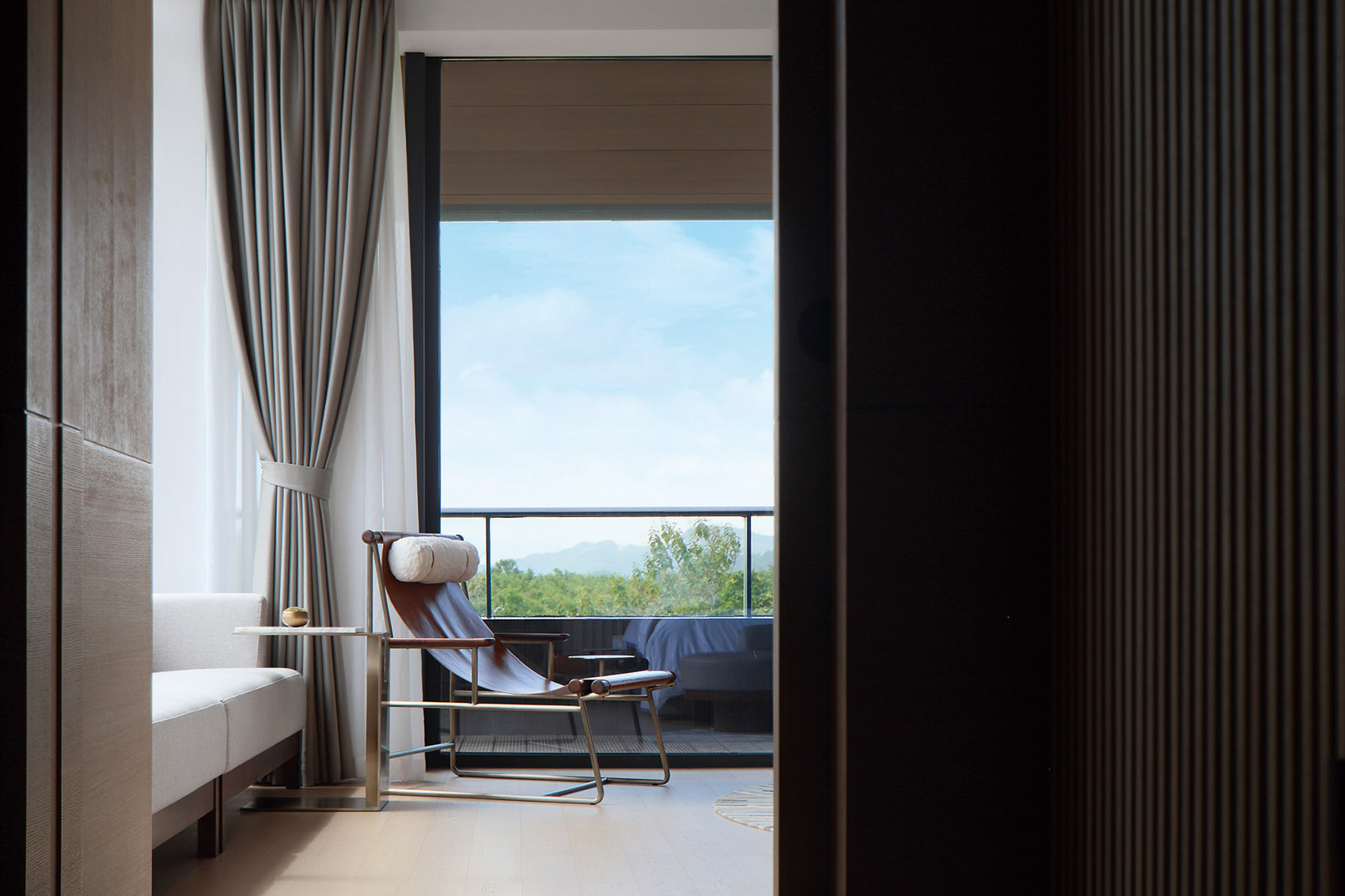
▼室外露台,outdoor terrace ©ingallery
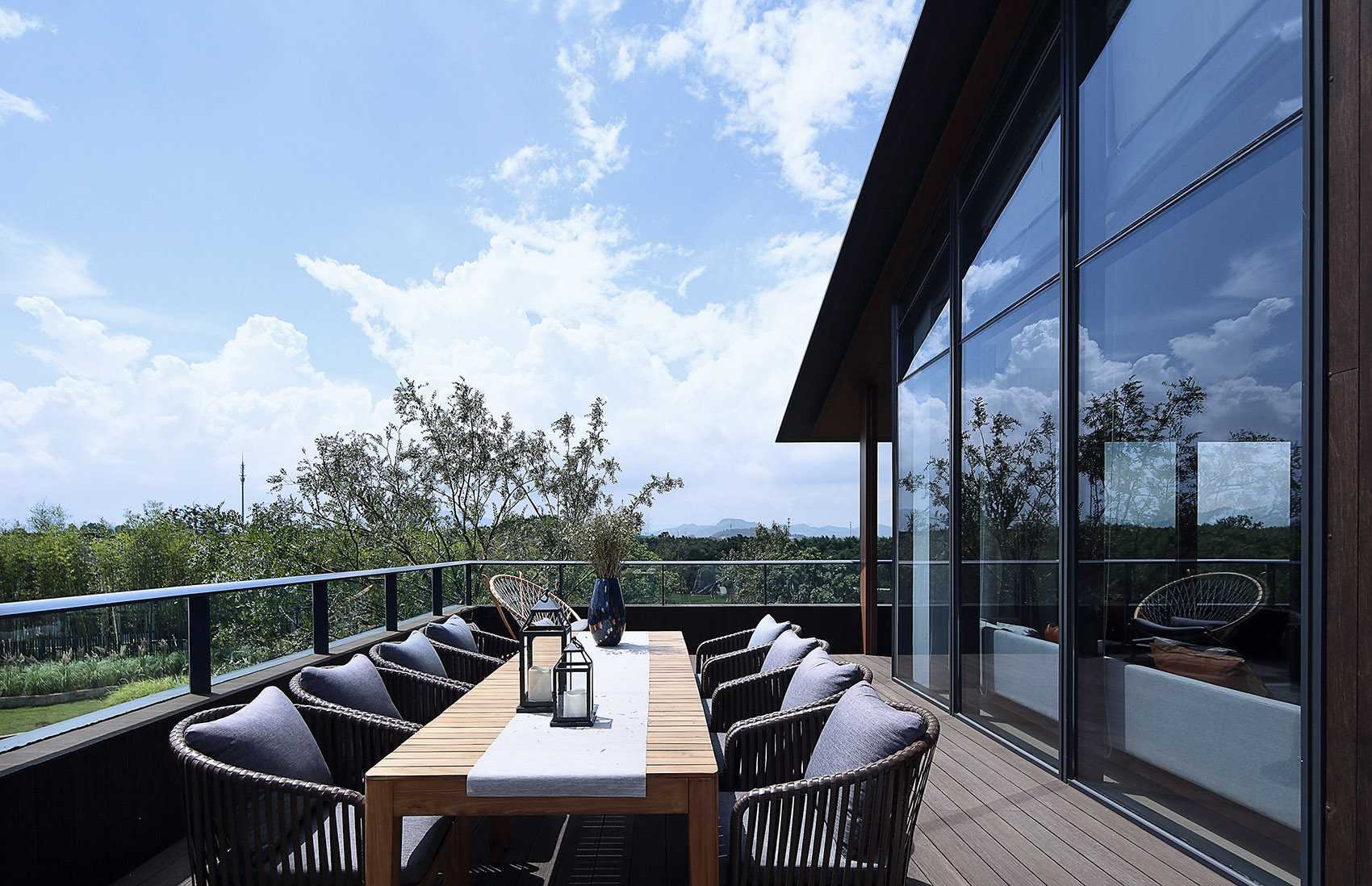
“诗意的栖居”启于人对自由与自然的追求,景观设计的落脚点即是对自然场地的再创作,在原有坡地上,我们希望尽可能地减少对原土地的干预,在恢复可持续生长的生态环境后,以“负景观设计”的手法,就地取材取景,构建人与自然、人与人交流互动的新渠道。
“Poetic dwelling” is inspired by people’s pursuit of freedom and nature. The strategy of landscape design is the re-creation of the natural site. On the original slope, we hope to have as little interference with the original land as possible. After restoring the ecological environment for sustainable growth, a new channel of communication and interaction between man and nature and between people is constructed by using the technique of “negative landscape design” and local materials and scenery.
▼景观概览,overall view of the landscape ©简直建筑-空间摄影

设计首先解读场地内的高差变化,最终以自东南向西北、沿山坡而下的阶梯形式进行梳理,以此形成多层次、多序列的空间形式可满足多种户外功能——上层聚拢式内向空间鼓励相互交流,下层开放式空间用于小憩和饱览稻田风光。
In the design, we first interpret the height difference changes in the site, and finally comb it in the form of a ladder from southeast to northwest along the hillside, to form a multi-level and multi-sequence spatial form that can meet a variety of outdoor functions. The upper gathering type inward space encourages mutual communication, and the lower open space is used for taking a rest and enjoying the rice field scenery.
▼阶梯式的景观应对场地高差,cope with the height differences in the site using terraced landscape ©简直建筑-空间摄影
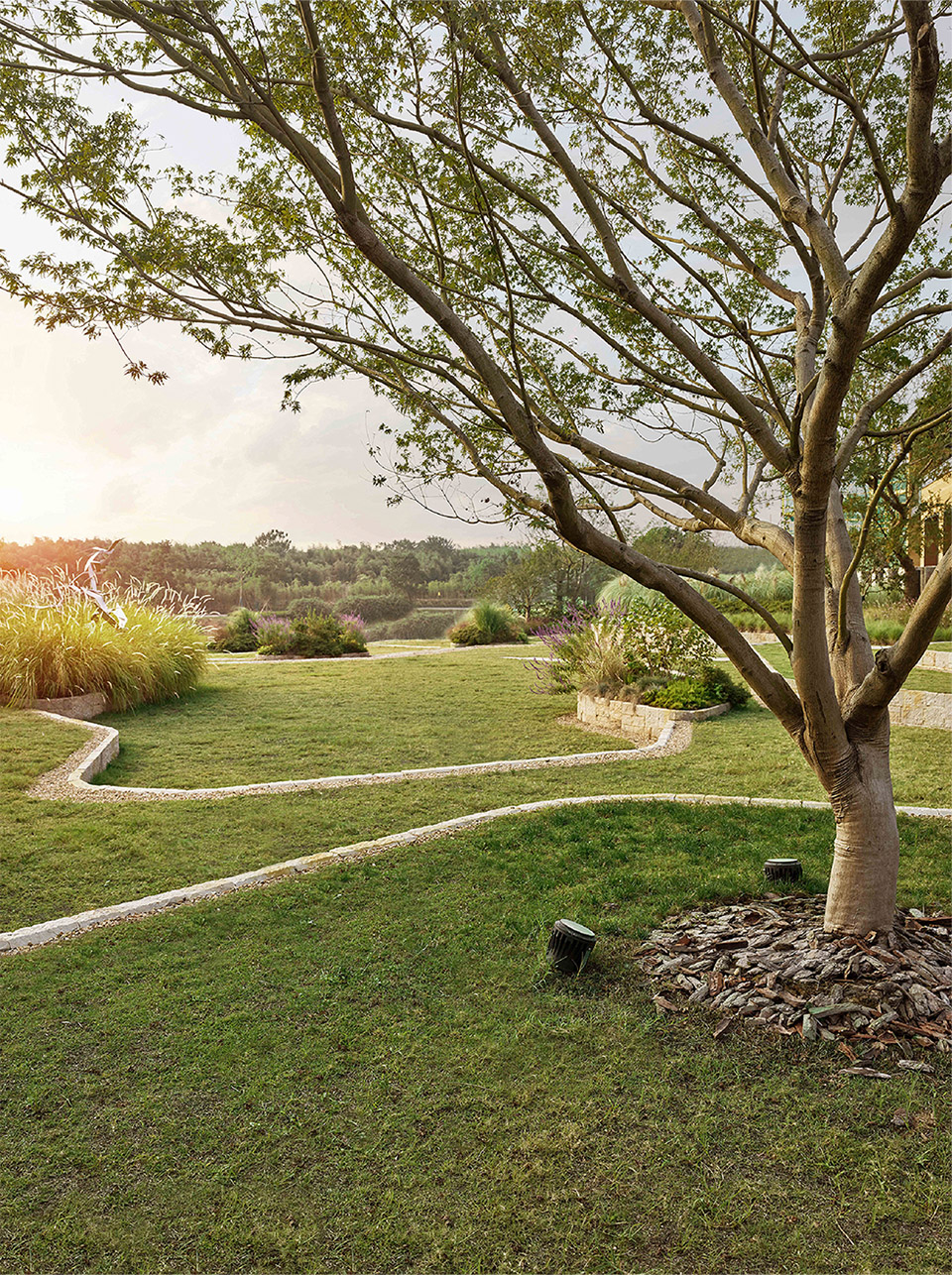
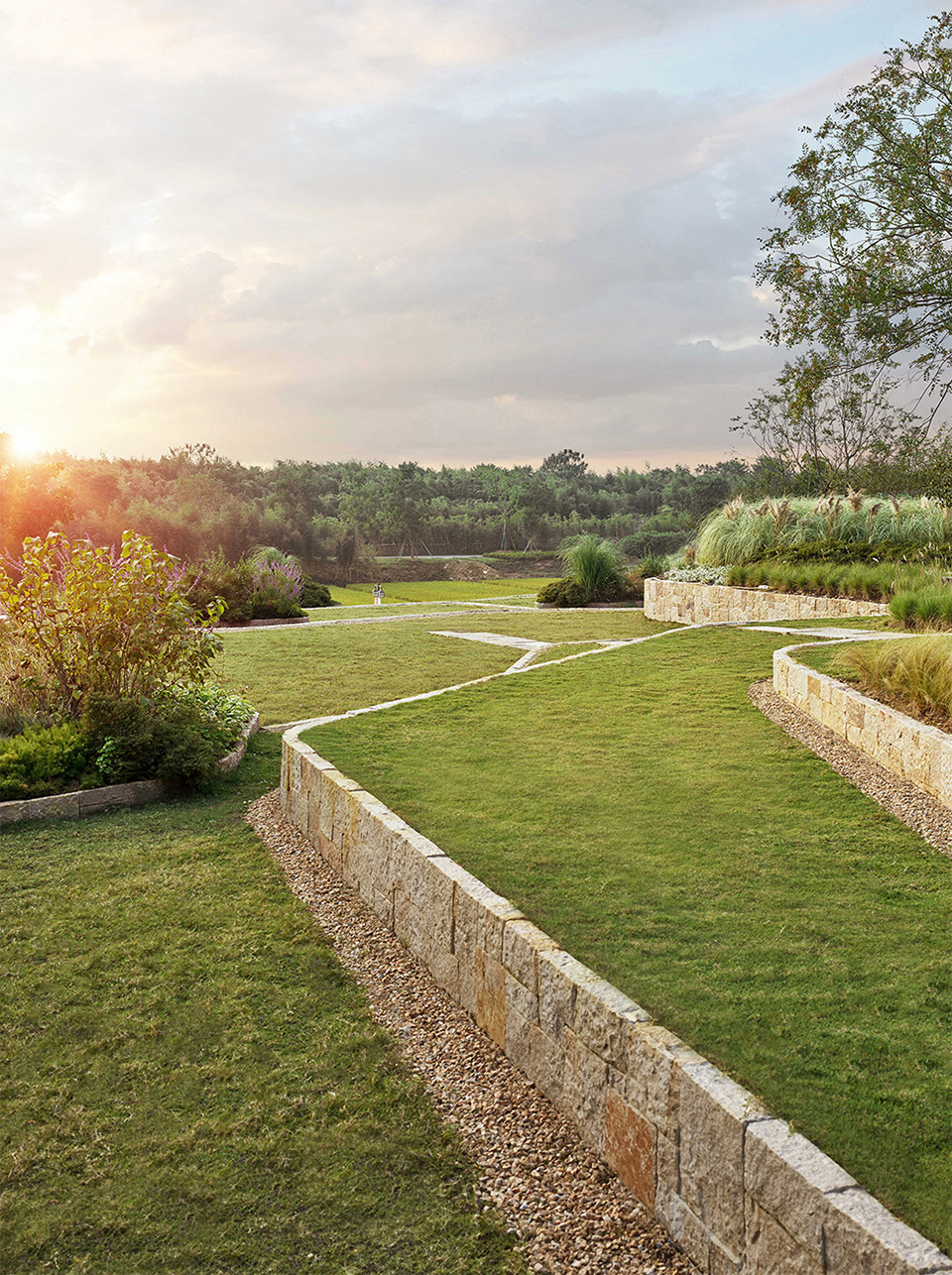
体型结构修改了山坡原有的坡度,设计通过设置多阶挡土墙稳固山体,以减少施工中造成的水土流失和雨水冲刷对山脚农田的伤害。挡土墙根部设置了排水渠,引导地表径流,阶梯形的结构更利于雨水汇集,通过处理系统实现保水、蓄水、净水、用水循环,保护当地生态环境。
丰富的空间体量提供与当地种植模式相符的结构,在多年草本植物和当地经济作物之间进行轮耕,以修养土壤,提供可持续种植及发展潜在农业的可能性。引入的植物对场地环境具有优化意义,成片栽种较高的细茎针茅、狼尾草和花叶蒲苇,边界点缀婆婆纳、络石、落新妇等植株,以固土护坡,净化水质,形成简洁、舒畅的空间序列。
It modified the original slope of the hillside, and stabilized the mountain by setting up multi-step retaining walls, so as to reduce the damage caused by soil erosion and rainwater erosion to the farmland at the foot of the mountain. A drainage canal is set at the root of the retaining wall to guide surface runoff. The stepped structure is more conducive to rainwater collection. The treatment system realizes water retention, storage, purification and circulation to protect the local ecological environment.
The abundant spatial volume provides a structure that conforms to the local planting model. Rotation is carried out between perennial herb plants and local cash crops to cultivate the soil and make sustainable planting and the development of potential agriculture possible. The introduced plants are of great significance to the optimization of the site environment. Taller stipa tenuissima, pennisetum and carex oshimensis ‘Evergold’ are planted in pieces, and the boundary is dotted with plants such as veronica didyma, trachelospermum jasminoide, astilbe chinensis, to consolidate the soil, protect the slope and purify water quality, forming a simple and comfortable spatial sequence.
▼雨水手机系统分析,analysis of the rainwater collection system ©gad · line+ studio
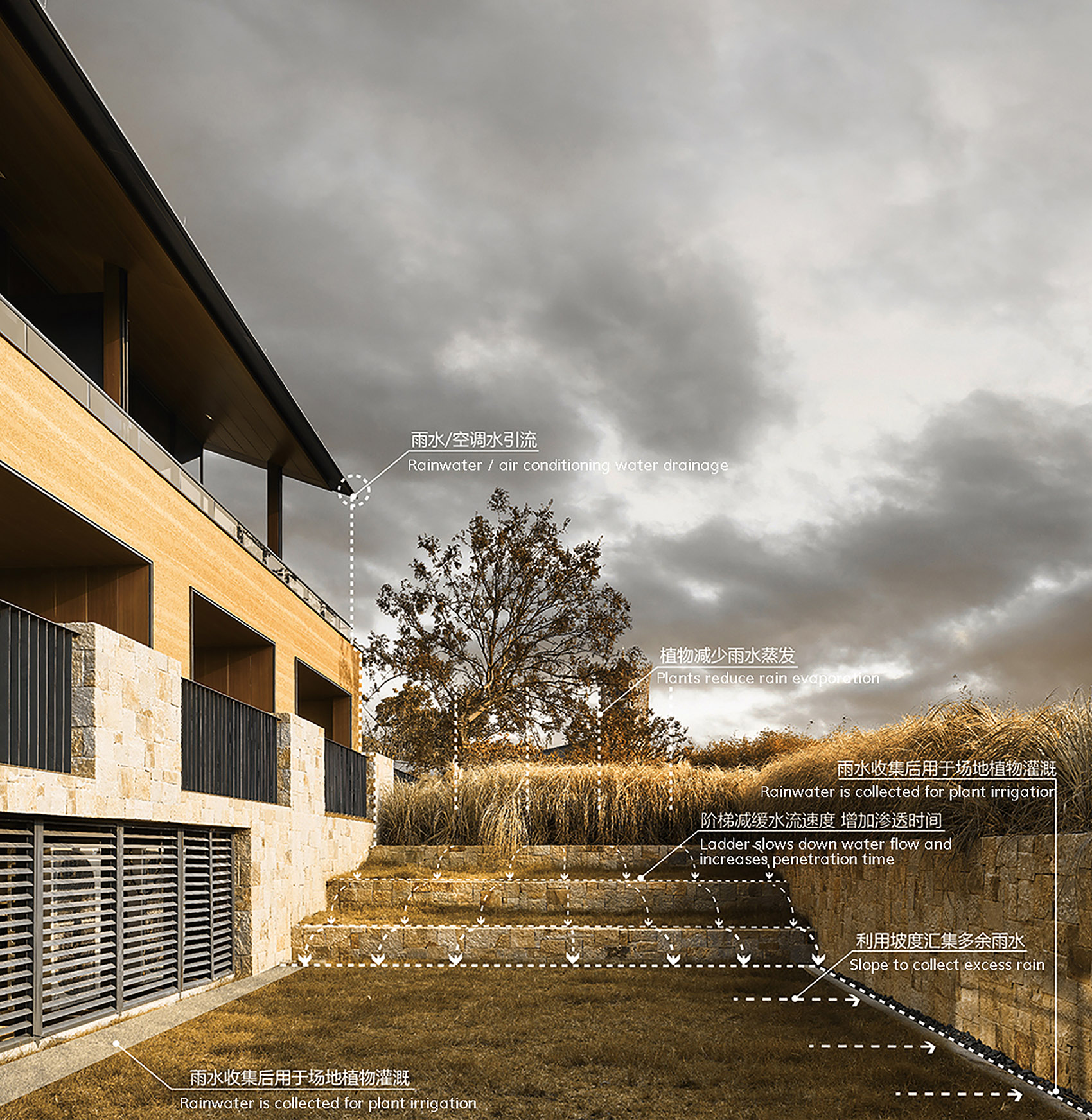
在类型同质化、标准化背景下,莫干溪谷 · 一亩田突破地产模式经验性规则,以传统聚落为类型概念,以空间为新型生活方式的载体,以生活社交度假为情感联系,以文化传承引领社区升级,实现世外桃源式的新田园社区和地产开发肌理的另一种可能性。
▼夜景,night view ©孙磊
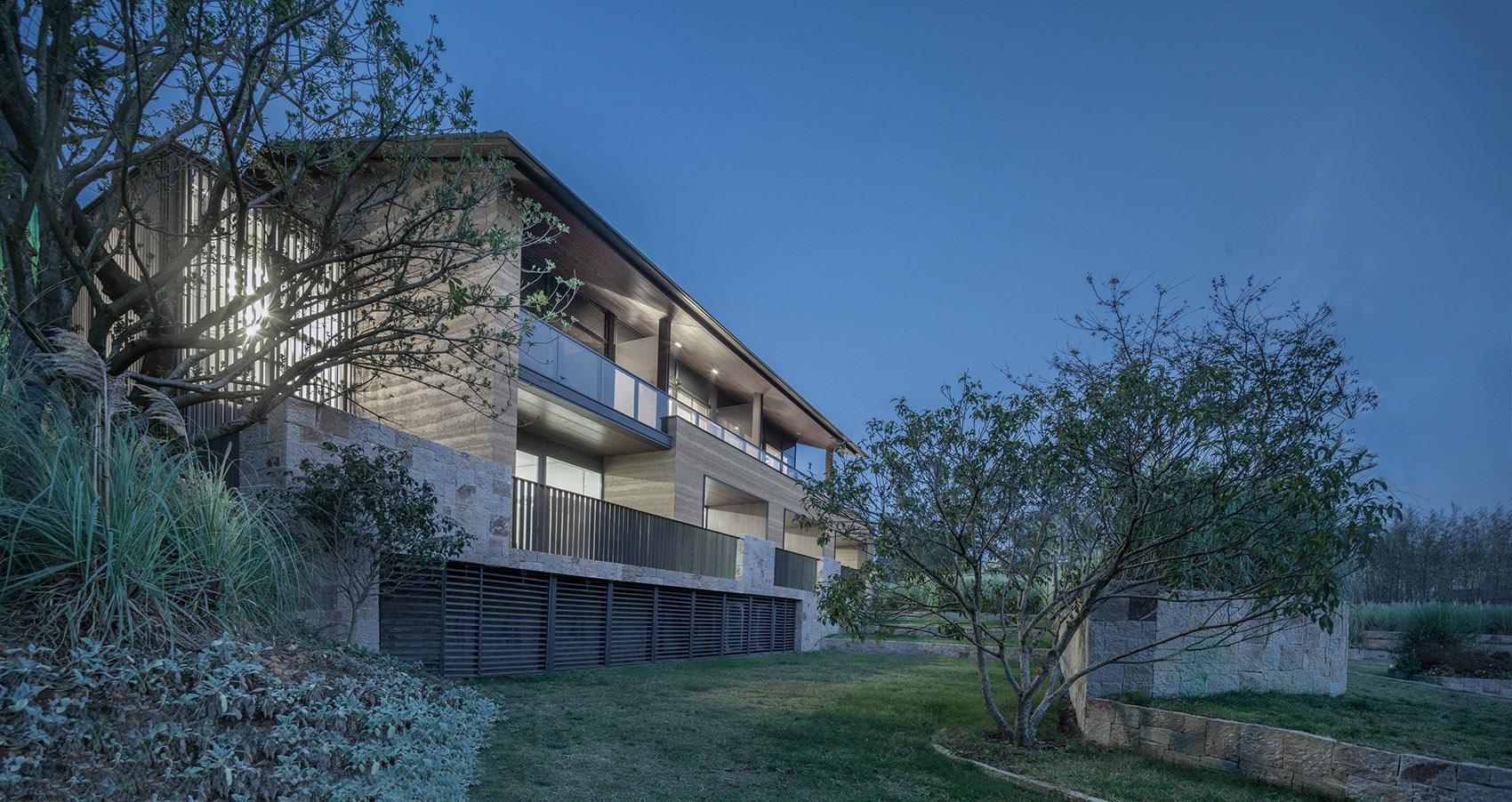
建筑作为人工聚落的有机组成和生活方式的载体,不单单是功能与形式的集合,也孕育着有机的生命力。无论是尺度、质感、建造细节,还是人性化功能的引入,所传递出的诗意性不是刻意的风格表象、抽象的结构秩序,而是由空间体验所唤起的人的内在情感联系与归属感。
As the organic composition of artificial settlements and the carrier of lifestyle, building is not only a collection of functions and forms, but also breeds organic vitality. In terms of the scale, texture, construction details, the introduction of humanized functions, the poetry conveyed is not deliberate style representation and abstract structural order, but the inner emotional connection and sense of belonging aroused by the experience of space.
▼不同材料形成富有情感的空间体验,emotional space experience created by different materials ©孙磊
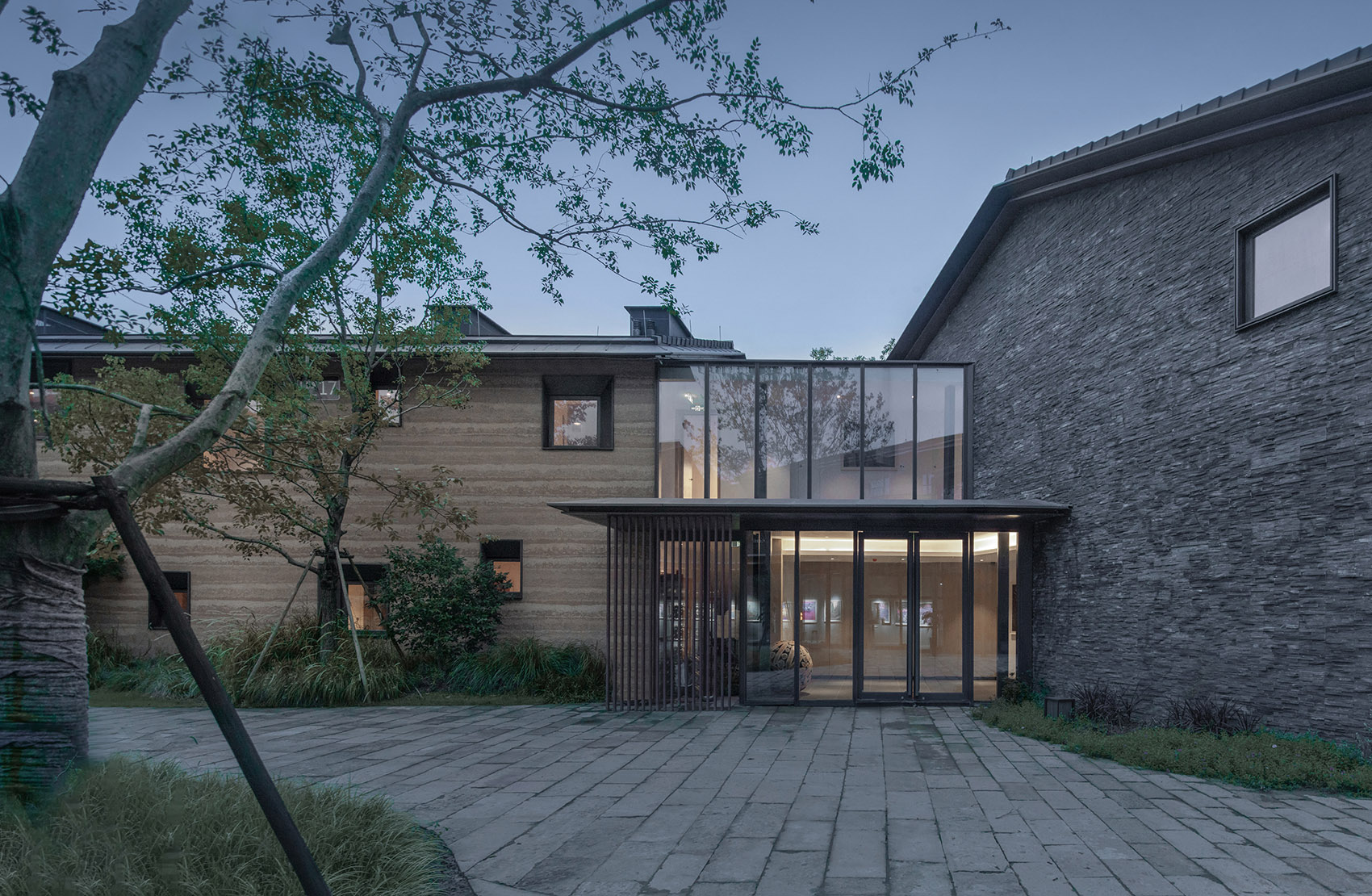
柯布西耶“住宅是居住的机器”的观念以标准化体系快速解决社会的基本需求问题,而在城市化进程中,部分城市人口开始从核心区外溢,以寻求更高品质的生活。居住产品不再局限于传统的住宅形式,度假产品、第二居所等新诉求的出现,迫使居住产品更多元化地迭代更新。另一方面,从市场机遇来看,地产行业也正在从增量时代向存量时代转变,由粗放式建造转向更精细化的开发模式和运营方式,需要我们以设计为空间赋能,创造具突破性的场景与体验。
The concept of “housing is a machine for living” solves the social problems quickly with a standardized system. But in the process of urbanization, part of the urban population has begun to escape from the core area in search of a higher quality of life. Residential products are no longer confined to traditional residential forms. The emergence of new demands such as holiday products and second residences has forced a more diversified iterative update of residential products. On the other hand, from the perspective of market opportunities, the real estate industry is also changing from an incremental era to a stock era, from extensive construction to more refined development models and operation methods. We should use architectural design to empower space and create special scenes and experiences.
▼高品质的生活场景,living scene with high quality ©孙磊
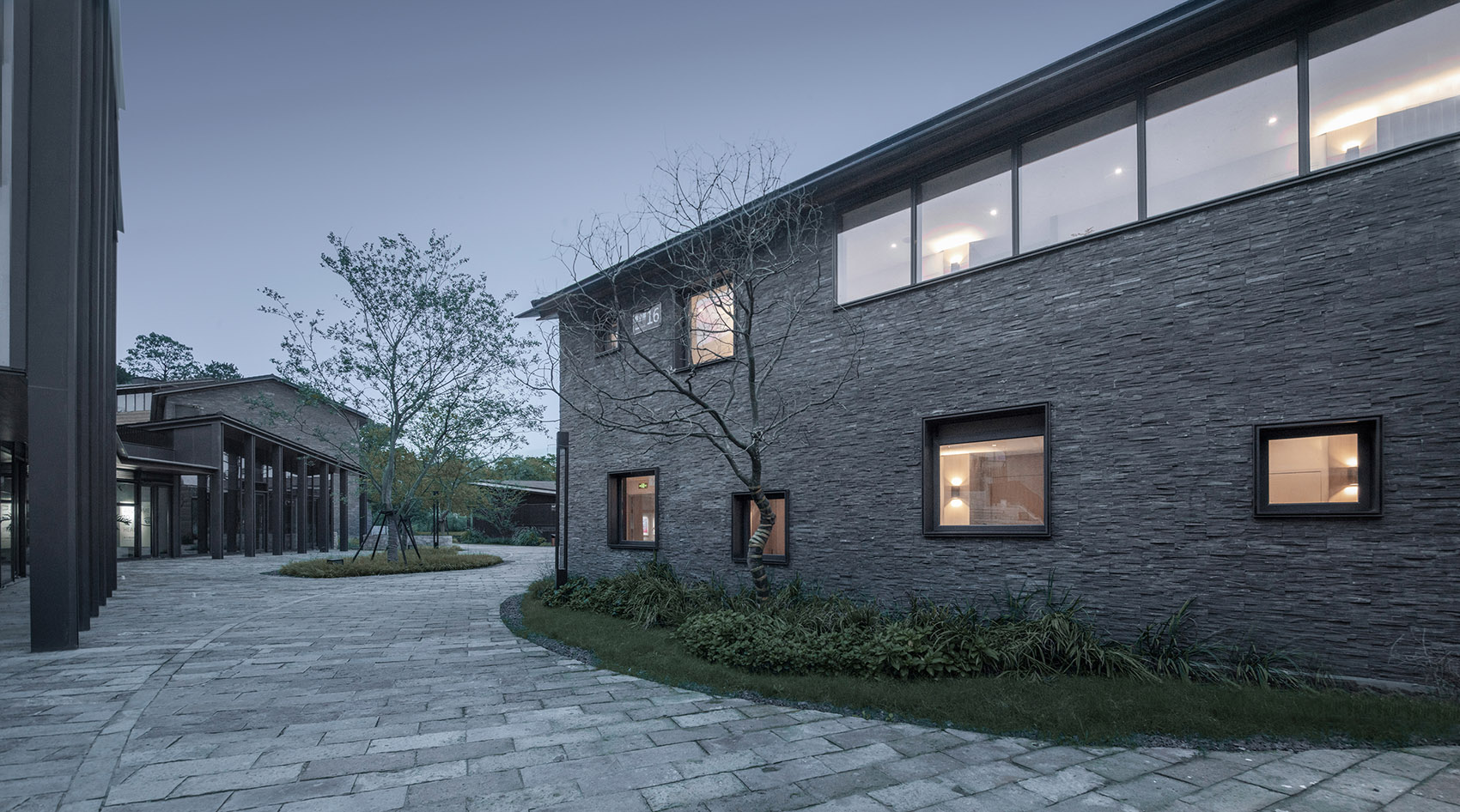
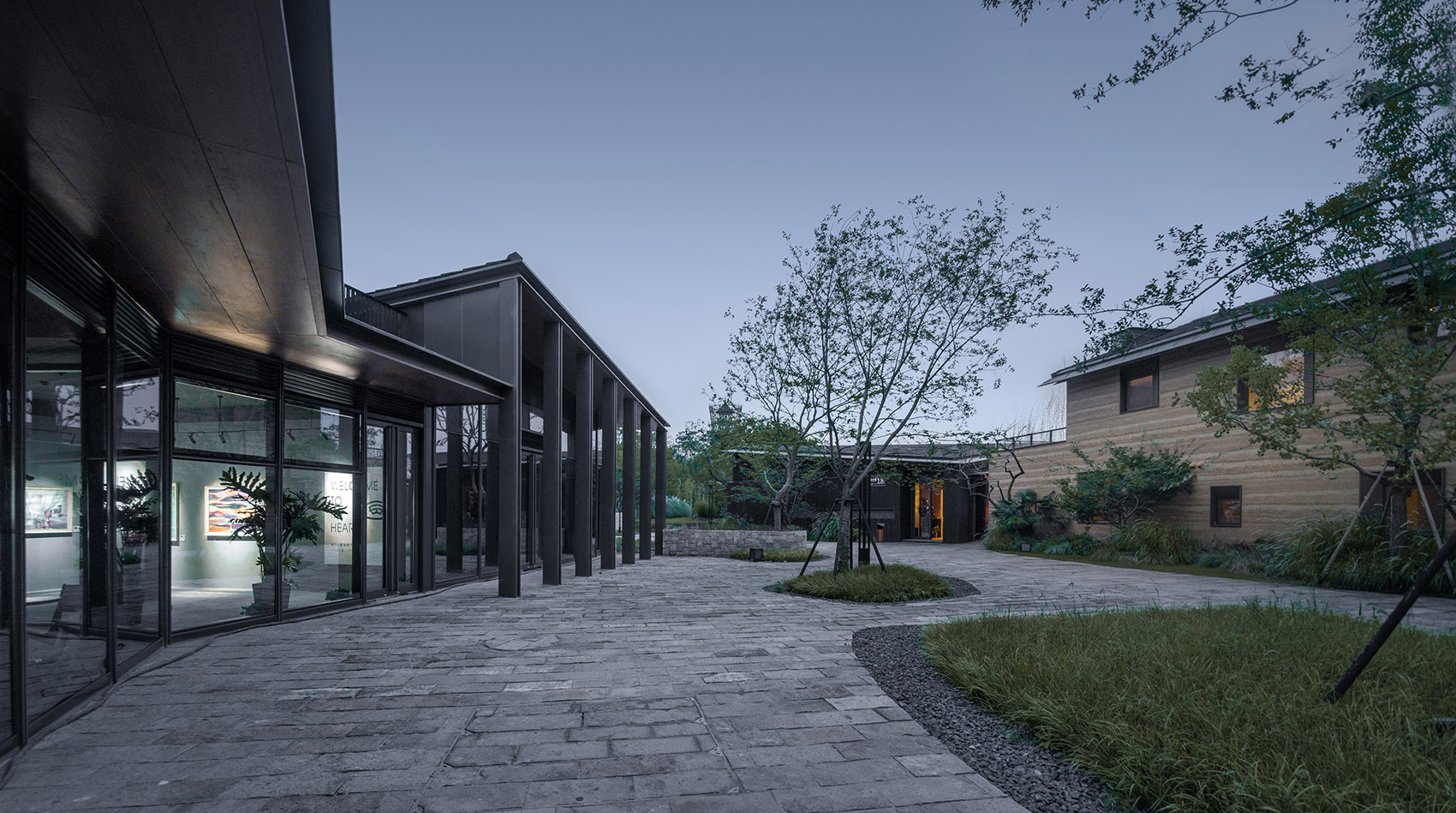
每个人都有自己心中的一亩田,我们希望莫干溪谷 · 一亩田是一次对新型生活社交度假载体的塑造,一次地产开发模式下的当代聚落重构。纵使在设计和施工过程中伴随着波折和插曲,但令人欣喜的是,它最终所呈现出的聚落的有机形态和使用场景超出了我们的预期,我们期许的“诗意的栖居”正在真实地发生着。
▼总平面图,site plan ©gad · line+ studio
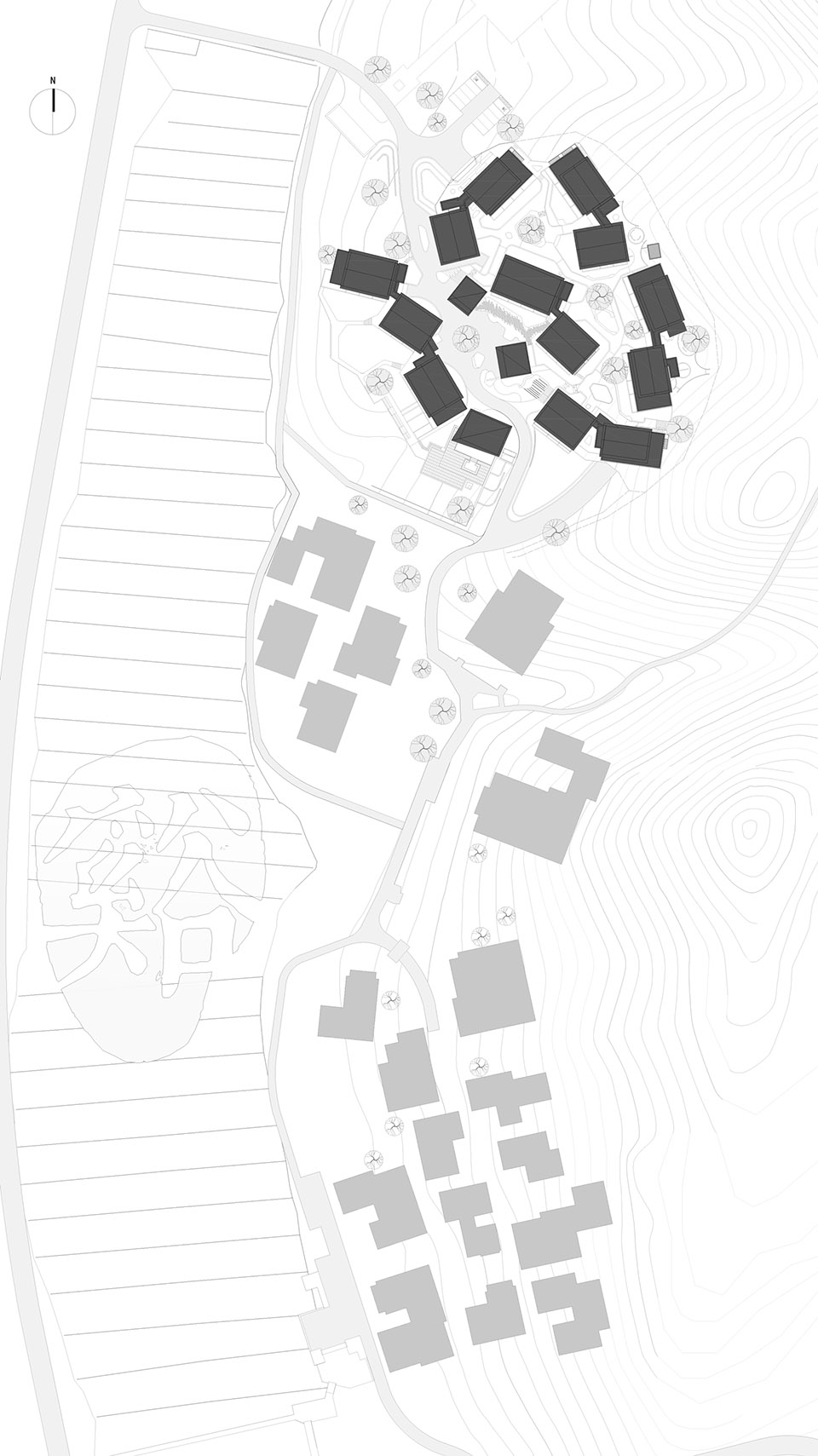
▼一层平面,ground floor plan ©gad · line+ studio
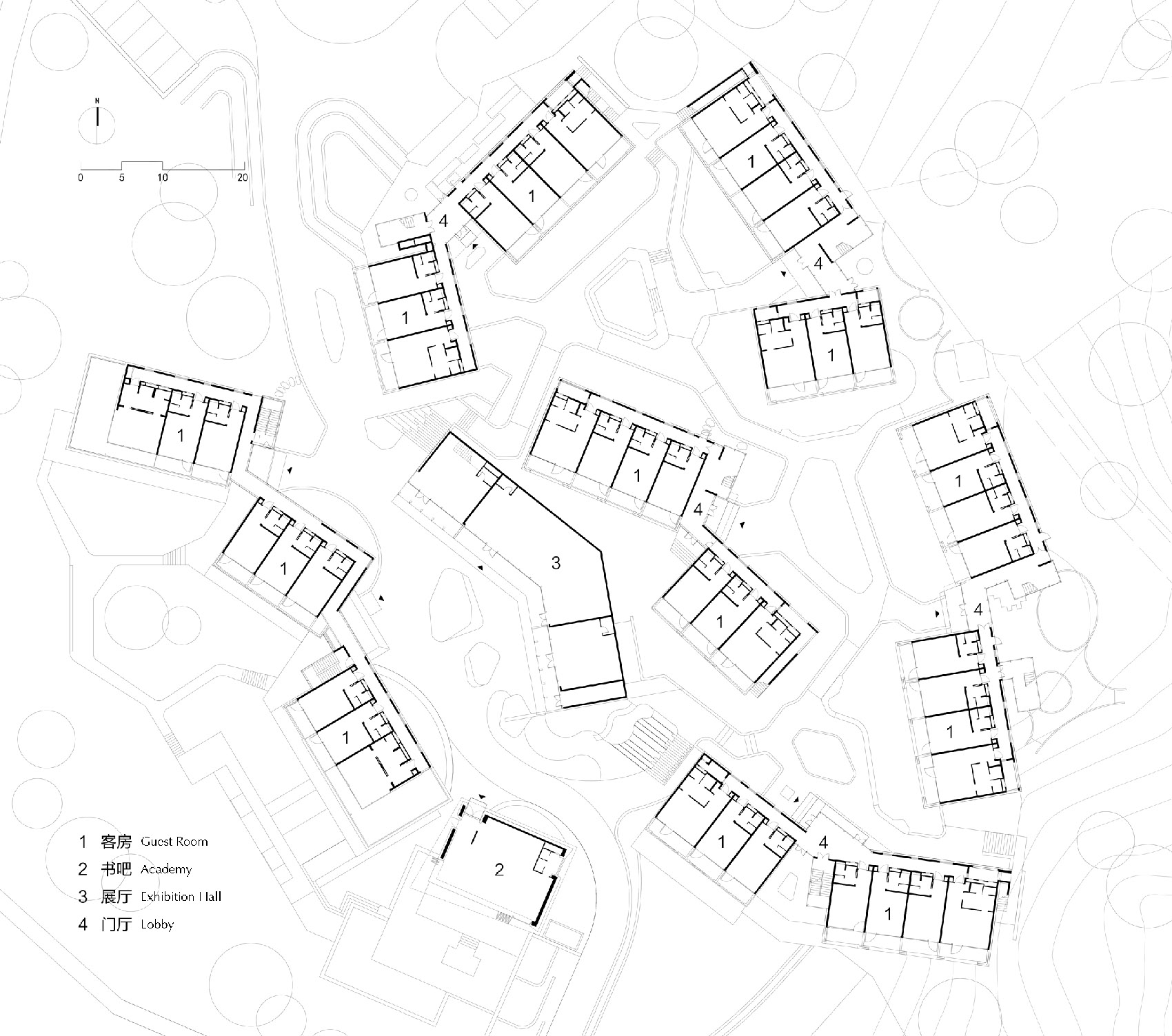
▼户型平面,floor plans ©gad · line+ studio
